BSBFIM601 Manage Finances Learner Workbook
VerifiedAdded on 2023/04/23
|75
|12842
|116
AI Summary
This workbook assesses aspects of all the elements, performance criteria, skills and knowledge and performance requirements of the unit of competency BSBFIM601: Manage finances. It includes instructions to the learner, assessment instructions, assessment requirements, candidate details, observation/demonstration, third party guide, activities, summative assessments, workplace documentation, supplementary oral questions, and competency record to be completed by the assessor.
Contribute Materials
Your contribution can guide someone’s learning journey. Share your
documents today.
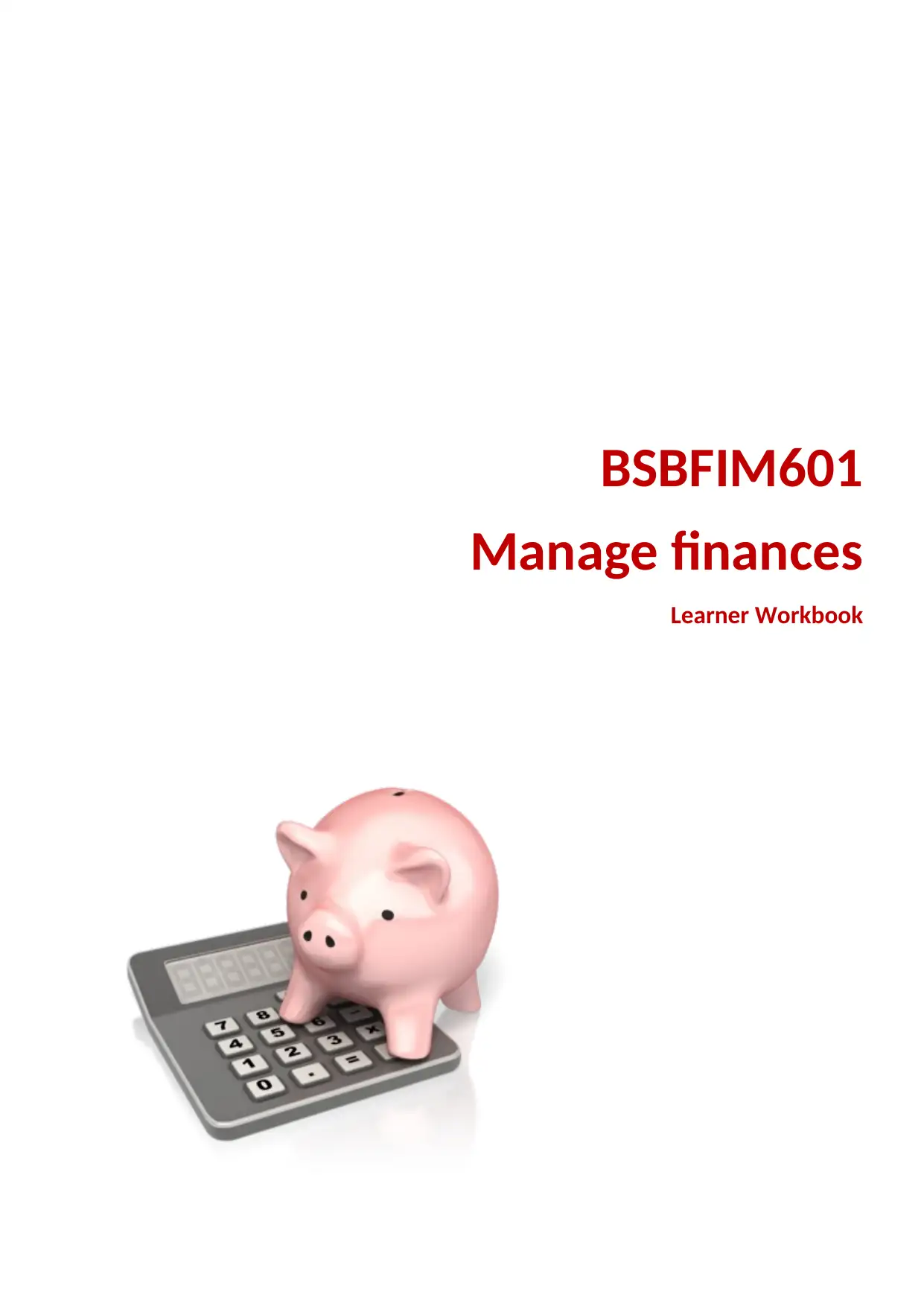
BSBFIM601
Manage finances
Learner Workbook
Manage finances
Learner Workbook
Secure Best Marks with AI Grader
Need help grading? Try our AI Grader for instant feedback on your assignments.
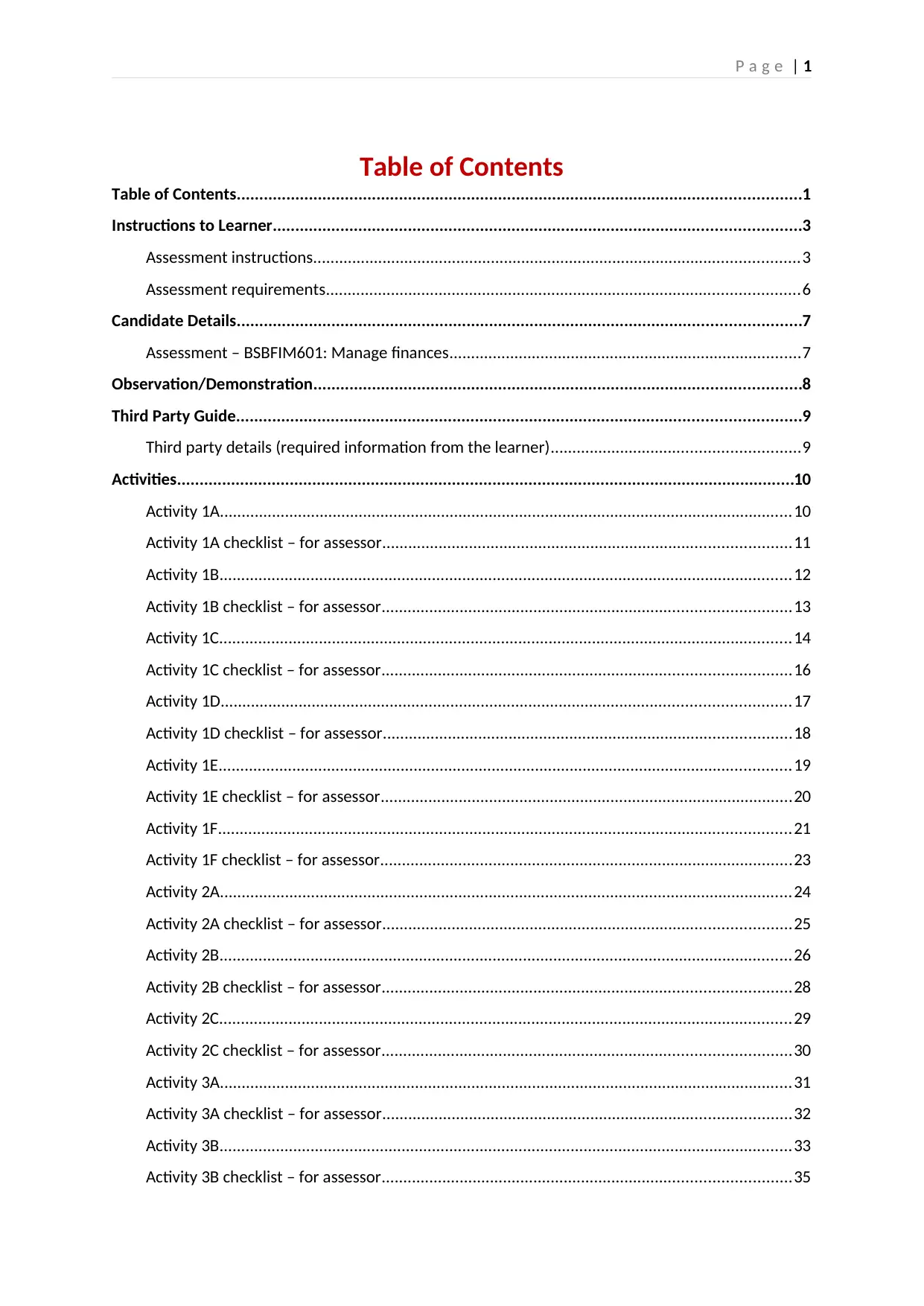
P a g e | 1
Table of Contents
Table of Contents.............................................................................................................................1
Instructions to Learner.....................................................................................................................3
Assessment instructions................................................................................................................3
Assessment requirements.............................................................................................................6
Candidate Details.............................................................................................................................7
Assessment – BSBFIM601: Manage finances.................................................................................7
Observation/Demonstration............................................................................................................8
Third Party Guide.............................................................................................................................9
Third party details (required information from the learner).........................................................9
Activities.........................................................................................................................................10
Activity 1A....................................................................................................................................10
Activity 1A checklist – for assessor..............................................................................................11
Activity 1B....................................................................................................................................12
Activity 1B checklist – for assessor..............................................................................................13
Activity 1C....................................................................................................................................14
Activity 1C checklist – for assessor..............................................................................................16
Activity 1D...................................................................................................................................17
Activity 1D checklist – for assessor..............................................................................................18
Activity 1E....................................................................................................................................19
Activity 1E checklist – for assessor...............................................................................................20
Activity 1F....................................................................................................................................21
Activity 1F checklist – for assessor...............................................................................................23
Activity 2A....................................................................................................................................24
Activity 2A checklist – for assessor..............................................................................................25
Activity 2B....................................................................................................................................26
Activity 2B checklist – for assessor..............................................................................................28
Activity 2C....................................................................................................................................29
Activity 2C checklist – for assessor..............................................................................................30
Activity 3A....................................................................................................................................31
Activity 3A checklist – for assessor..............................................................................................32
Activity 3B....................................................................................................................................33
Activity 3B checklist – for assessor..............................................................................................35
Table of Contents
Table of Contents.............................................................................................................................1
Instructions to Learner.....................................................................................................................3
Assessment instructions................................................................................................................3
Assessment requirements.............................................................................................................6
Candidate Details.............................................................................................................................7
Assessment – BSBFIM601: Manage finances.................................................................................7
Observation/Demonstration............................................................................................................8
Third Party Guide.............................................................................................................................9
Third party details (required information from the learner).........................................................9
Activities.........................................................................................................................................10
Activity 1A....................................................................................................................................10
Activity 1A checklist – for assessor..............................................................................................11
Activity 1B....................................................................................................................................12
Activity 1B checklist – for assessor..............................................................................................13
Activity 1C....................................................................................................................................14
Activity 1C checklist – for assessor..............................................................................................16
Activity 1D...................................................................................................................................17
Activity 1D checklist – for assessor..............................................................................................18
Activity 1E....................................................................................................................................19
Activity 1E checklist – for assessor...............................................................................................20
Activity 1F....................................................................................................................................21
Activity 1F checklist – for assessor...............................................................................................23
Activity 2A....................................................................................................................................24
Activity 2A checklist – for assessor..............................................................................................25
Activity 2B....................................................................................................................................26
Activity 2B checklist – for assessor..............................................................................................28
Activity 2C....................................................................................................................................29
Activity 2C checklist – for assessor..............................................................................................30
Activity 3A....................................................................................................................................31
Activity 3A checklist – for assessor..............................................................................................32
Activity 3B....................................................................................................................................33
Activity 3B checklist – for assessor..............................................................................................35

P a g e | 2
Activity 3C....................................................................................................................................36
Activity 3C checklist – for assessor..............................................................................................37
Activity 3D...................................................................................................................................38
Activity 3D checklist – for assessor..............................................................................................40
Activity 3E....................................................................................................................................41
Activity 3E checklist – for assessor...............................................................................................42
Activity 3F....................................................................................................................................43
Activity 3F checklist – for assessor...............................................................................................45
Activity 4A....................................................................................................................................46
Activity 4A checklist – for assessor..............................................................................................47
Activity 4B....................................................................................................................................48
Activity 4B checklist – for assessor..............................................................................................49
Activity 4C....................................................................................................................................50
Activity 4C checklist – for assessor..............................................................................................51
Activity 4D...................................................................................................................................52
Activity 4D checklist – for assessor..............................................................................................54
Summative Assessments................................................................................................................58
Section A: Skills Activity...............................................................................................................59
Summative Assessments: Section A checklist..............................................................................60
Section B: Knowledge Activity (Q & A).........................................................................................61
Summative Assessments: Section B checklist..............................................................................62
Section C: Performance Activity...................................................................................................63
Summative Assessments: Section C checklist..............................................................................64
Workplace Documentation – for learner........................................................................................65
Workplace documents checklist..................................................................................................65
Supplementary Oral Questions (optional) – for assessor................................................................66
Competency record to be completed by assessor...........................................................................69
Activity 3C....................................................................................................................................36
Activity 3C checklist – for assessor..............................................................................................37
Activity 3D...................................................................................................................................38
Activity 3D checklist – for assessor..............................................................................................40
Activity 3E....................................................................................................................................41
Activity 3E checklist – for assessor...............................................................................................42
Activity 3F....................................................................................................................................43
Activity 3F checklist – for assessor...............................................................................................45
Activity 4A....................................................................................................................................46
Activity 4A checklist – for assessor..............................................................................................47
Activity 4B....................................................................................................................................48
Activity 4B checklist – for assessor..............................................................................................49
Activity 4C....................................................................................................................................50
Activity 4C checklist – for assessor..............................................................................................51
Activity 4D...................................................................................................................................52
Activity 4D checklist – for assessor..............................................................................................54
Summative Assessments................................................................................................................58
Section A: Skills Activity...............................................................................................................59
Summative Assessments: Section A checklist..............................................................................60
Section B: Knowledge Activity (Q & A).........................................................................................61
Summative Assessments: Section B checklist..............................................................................62
Section C: Performance Activity...................................................................................................63
Summative Assessments: Section C checklist..............................................................................64
Workplace Documentation – for learner........................................................................................65
Workplace documents checklist..................................................................................................65
Supplementary Oral Questions (optional) – for assessor................................................................66
Competency record to be completed by assessor...........................................................................69
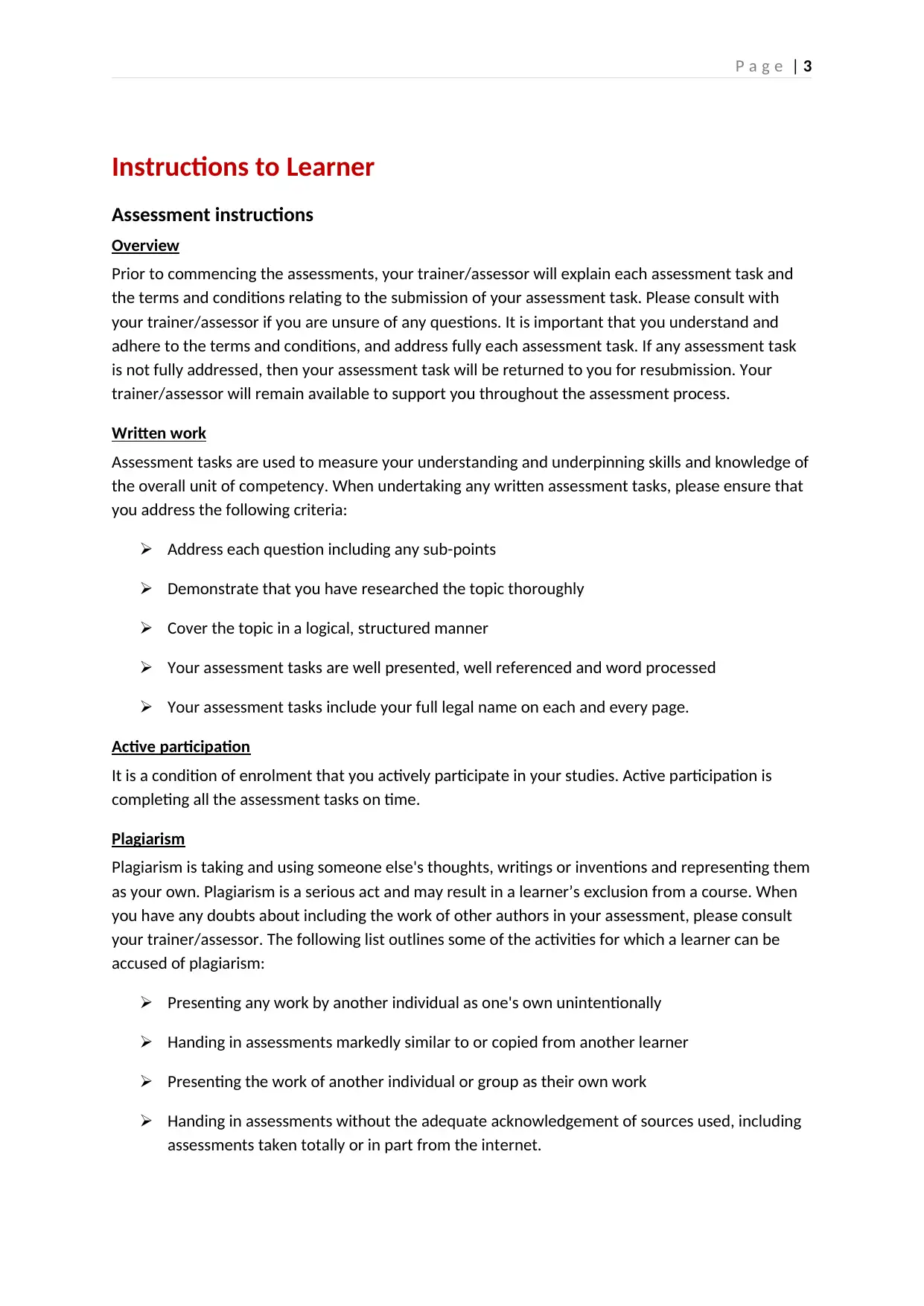
P a g e | 3
Instructions to Learner
Assessment instructions
Overview
Prior to commencing the assessments, your trainer/assessor will explain each assessment task and
the terms and conditions relating to the submission of your assessment task. Please consult with
your trainer/assessor if you are unsure of any questions. It is important that you understand and
adhere to the terms and conditions, and address fully each assessment task. If any assessment task
is not fully addressed, then your assessment task will be returned to you for resubmission. Your
trainer/assessor will remain available to support you throughout the assessment process.
Written work
Assessment tasks are used to measure your understanding and underpinning skills and knowledge of
the overall unit of competency. When undertaking any written assessment tasks, please ensure that
you address the following criteria:
Address each question including any sub-points
Demonstrate that you have researched the topic thoroughly
Cover the topic in a logical, structured manner
Your assessment tasks are well presented, well referenced and word processed
Your assessment tasks include your full legal name on each and every page.
Active participation
It is a condition of enrolment that you actively participate in your studies. Active participation is
completing all the assessment tasks on time.
Plagiarism
Plagiarism is taking and using someone else's thoughts, writings or inventions and representing them
as your own. Plagiarism is a serious act and may result in a learner’s exclusion from a course. When
you have any doubts about including the work of other authors in your assessment, please consult
your trainer/assessor. The following list outlines some of the activities for which a learner can be
accused of plagiarism:
Presenting any work by another individual as one's own unintentionally
Handing in assessments markedly similar to or copied from another learner
Presenting the work of another individual or group as their own work
Handing in assessments without the adequate acknowledgement of sources used, including
assessments taken totally or in part from the internet.
Instructions to Learner
Assessment instructions
Overview
Prior to commencing the assessments, your trainer/assessor will explain each assessment task and
the terms and conditions relating to the submission of your assessment task. Please consult with
your trainer/assessor if you are unsure of any questions. It is important that you understand and
adhere to the terms and conditions, and address fully each assessment task. If any assessment task
is not fully addressed, then your assessment task will be returned to you for resubmission. Your
trainer/assessor will remain available to support you throughout the assessment process.
Written work
Assessment tasks are used to measure your understanding and underpinning skills and knowledge of
the overall unit of competency. When undertaking any written assessment tasks, please ensure that
you address the following criteria:
Address each question including any sub-points
Demonstrate that you have researched the topic thoroughly
Cover the topic in a logical, structured manner
Your assessment tasks are well presented, well referenced and word processed
Your assessment tasks include your full legal name on each and every page.
Active participation
It is a condition of enrolment that you actively participate in your studies. Active participation is
completing all the assessment tasks on time.
Plagiarism
Plagiarism is taking and using someone else's thoughts, writings or inventions and representing them
as your own. Plagiarism is a serious act and may result in a learner’s exclusion from a course. When
you have any doubts about including the work of other authors in your assessment, please consult
your trainer/assessor. The following list outlines some of the activities for which a learner can be
accused of plagiarism:
Presenting any work by another individual as one's own unintentionally
Handing in assessments markedly similar to or copied from another learner
Presenting the work of another individual or group as their own work
Handing in assessments without the adequate acknowledgement of sources used, including
assessments taken totally or in part from the internet.
Secure Best Marks with AI Grader
Need help grading? Try our AI Grader for instant feedback on your assignments.
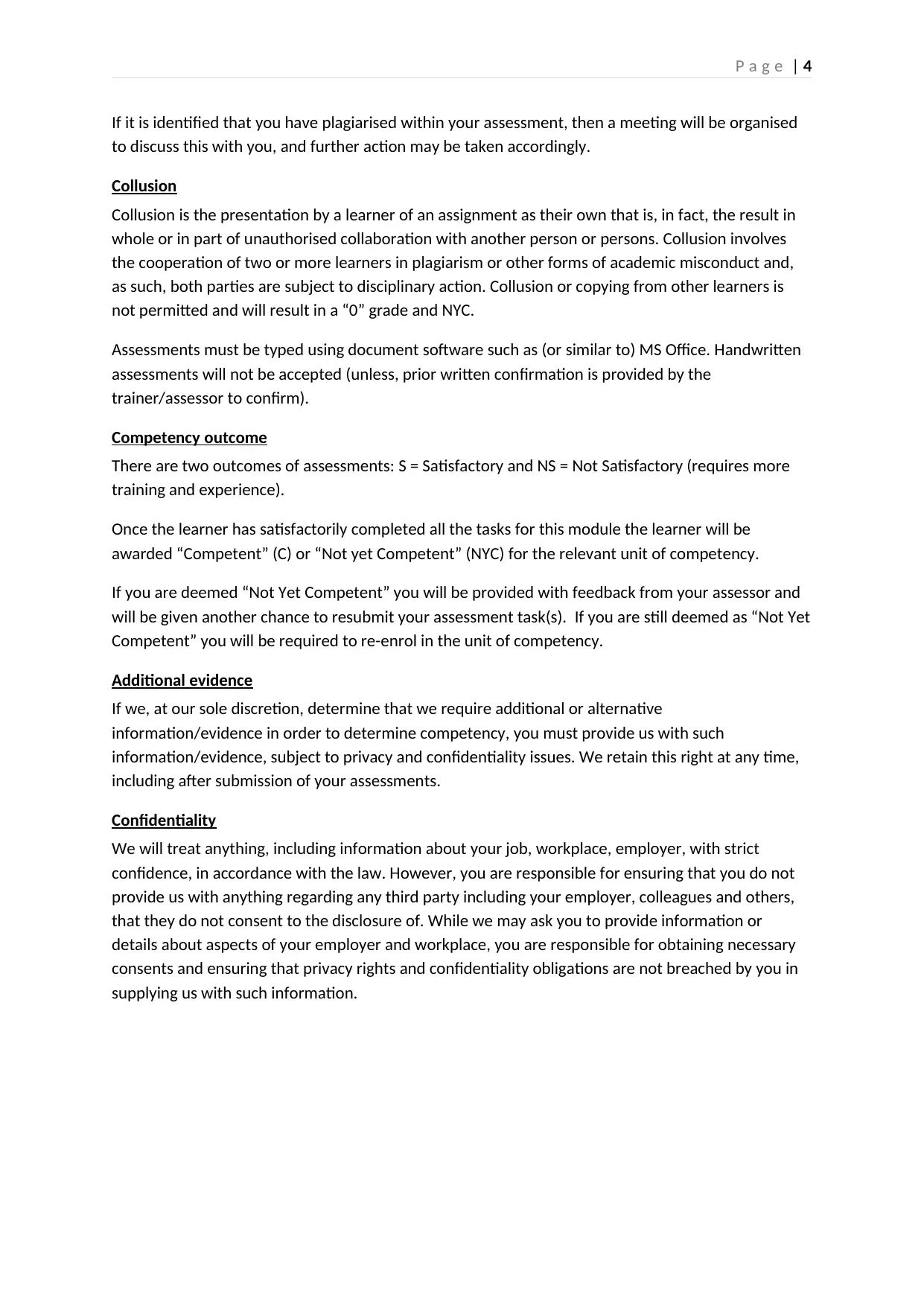
P a g e | 4
If it is identified that you have plagiarised within your assessment, then a meeting will be organised
to discuss this with you, and further action may be taken accordingly.
Collusion
Collusion is the presentation by a learner of an assignment as their own that is, in fact, the result in
whole or in part of unauthorised collaboration with another person or persons. Collusion involves
the cooperation of two or more learners in plagiarism or other forms of academic misconduct and,
as such, both parties are subject to disciplinary action. Collusion or copying from other learners is
not permitted and will result in a “0” grade and NYC.
Assessments must be typed using document software such as (or similar to) MS Office. Handwritten
assessments will not be accepted (unless, prior written confirmation is provided by the
trainer/assessor to confirm).
Competency outcome
There are two outcomes of assessments: S = Satisfactory and NS = Not Satisfactory (requires more
training and experience).
Once the learner has satisfactorily completed all the tasks for this module the learner will be
awarded “Competent” (C) or “Not yet Competent” (NYC) for the relevant unit of competency.
If you are deemed “Not Yet Competent” you will be provided with feedback from your assessor and
will be given another chance to resubmit your assessment task(s). If you are still deemed as “Not Yet
Competent” you will be required to re-enrol in the unit of competency.
Additional evidence
If we, at our sole discretion, determine that we require additional or alternative
information/evidence in order to determine competency, you must provide us with such
information/evidence, subject to privacy and confidentiality issues. We retain this right at any time,
including after submission of your assessments.
Confidentiality
We will treat anything, including information about your job, workplace, employer, with strict
confidence, in accordance with the law. However, you are responsible for ensuring that you do not
provide us with anything regarding any third party including your employer, colleagues and others,
that they do not consent to the disclosure of. While we may ask you to provide information or
details about aspects of your employer and workplace, you are responsible for obtaining necessary
consents and ensuring that privacy rights and confidentiality obligations are not breached by you in
supplying us with such information.
If it is identified that you have plagiarised within your assessment, then a meeting will be organised
to discuss this with you, and further action may be taken accordingly.
Collusion
Collusion is the presentation by a learner of an assignment as their own that is, in fact, the result in
whole or in part of unauthorised collaboration with another person or persons. Collusion involves
the cooperation of two or more learners in plagiarism or other forms of academic misconduct and,
as such, both parties are subject to disciplinary action. Collusion or copying from other learners is
not permitted and will result in a “0” grade and NYC.
Assessments must be typed using document software such as (or similar to) MS Office. Handwritten
assessments will not be accepted (unless, prior written confirmation is provided by the
trainer/assessor to confirm).
Competency outcome
There are two outcomes of assessments: S = Satisfactory and NS = Not Satisfactory (requires more
training and experience).
Once the learner has satisfactorily completed all the tasks for this module the learner will be
awarded “Competent” (C) or “Not yet Competent” (NYC) for the relevant unit of competency.
If you are deemed “Not Yet Competent” you will be provided with feedback from your assessor and
will be given another chance to resubmit your assessment task(s). If you are still deemed as “Not Yet
Competent” you will be required to re-enrol in the unit of competency.
Additional evidence
If we, at our sole discretion, determine that we require additional or alternative
information/evidence in order to determine competency, you must provide us with such
information/evidence, subject to privacy and confidentiality issues. We retain this right at any time,
including after submission of your assessments.
Confidentiality
We will treat anything, including information about your job, workplace, employer, with strict
confidence, in accordance with the law. However, you are responsible for ensuring that you do not
provide us with anything regarding any third party including your employer, colleagues and others,
that they do not consent to the disclosure of. While we may ask you to provide information or
details about aspects of your employer and workplace, you are responsible for obtaining necessary
consents and ensuring that privacy rights and confidentiality obligations are not breached by you in
supplying us with such information.
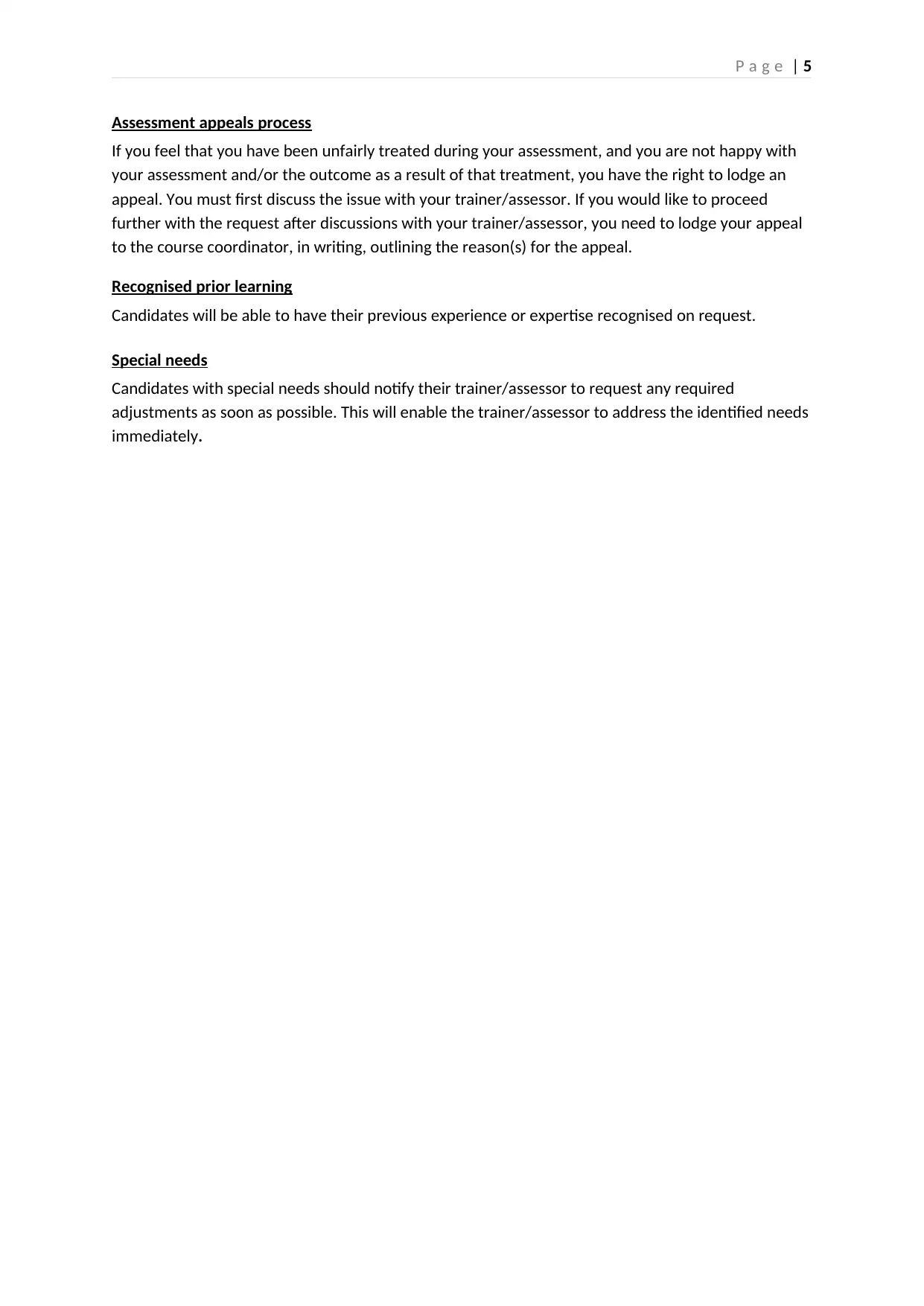
P a g e | 5
Assessment appeals process
If you feel that you have been unfairly treated during your assessment, and you are not happy with
your assessment and/or the outcome as a result of that treatment, you have the right to lodge an
appeal. You must first discuss the issue with your trainer/assessor. If you would like to proceed
further with the request after discussions with your trainer/assessor, you need to lodge your appeal
to the course coordinator, in writing, outlining the reason(s) for the appeal.
Recognised prior learning
Candidates will be able to have their previous experience or expertise recognised on request.
Special needs
Candidates with special needs should notify their trainer/assessor to request any required
adjustments as soon as possible. This will enable the trainer/assessor to address the identified needs
immediately .
Assessment appeals process
If you feel that you have been unfairly treated during your assessment, and you are not happy with
your assessment and/or the outcome as a result of that treatment, you have the right to lodge an
appeal. You must first discuss the issue with your trainer/assessor. If you would like to proceed
further with the request after discussions with your trainer/assessor, you need to lodge your appeal
to the course coordinator, in writing, outlining the reason(s) for the appeal.
Recognised prior learning
Candidates will be able to have their previous experience or expertise recognised on request.
Special needs
Candidates with special needs should notify their trainer/assessor to request any required
adjustments as soon as possible. This will enable the trainer/assessor to address the identified needs
immediately .
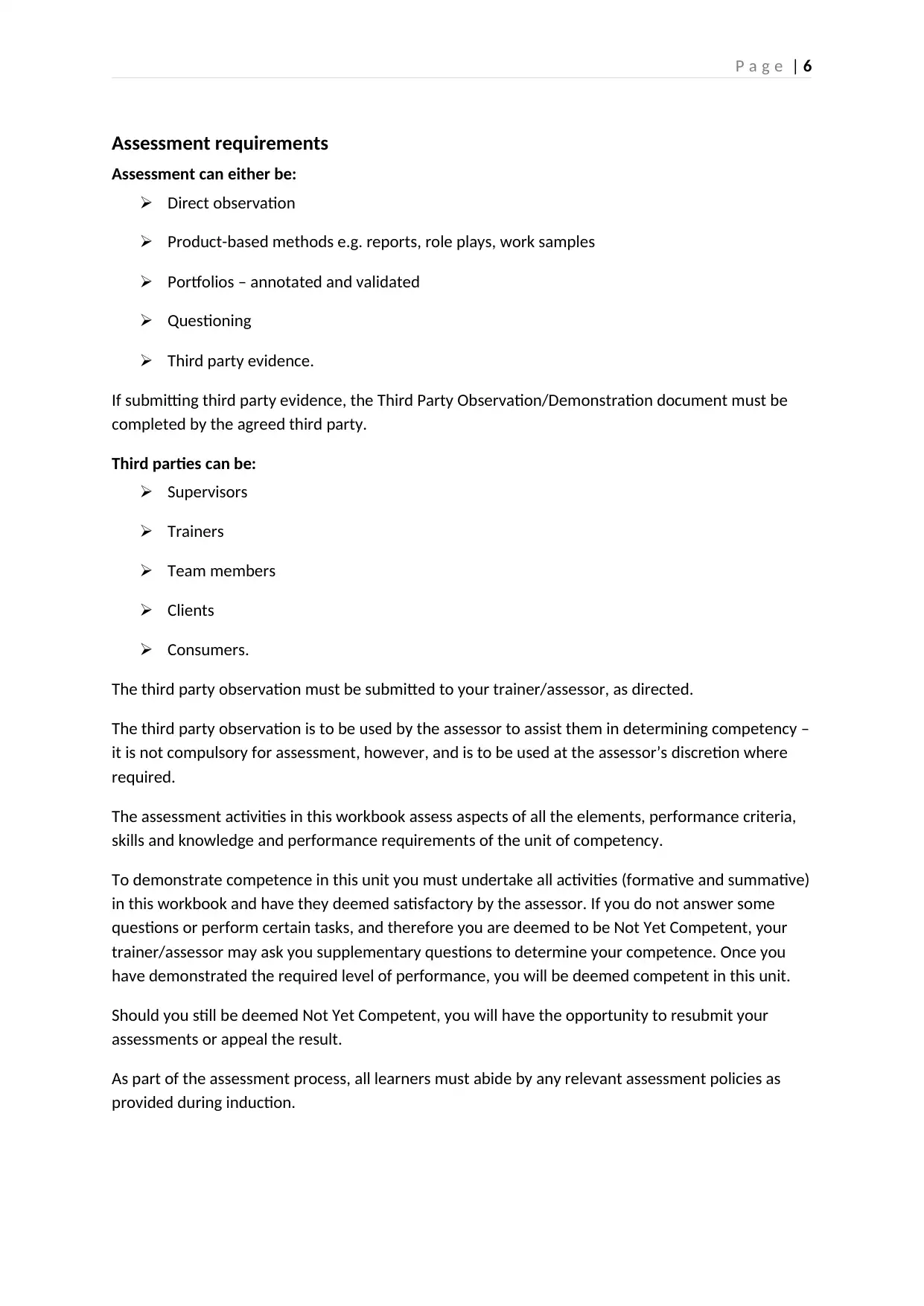
P a g e | 6
Assessment requirements
Assessment can either be:
Direct observation
Product-based methods e.g. reports, role plays, work samples
Portfolios – annotated and validated
Questioning
Third party evidence.
If submitting third party evidence, the Third Party Observation/Demonstration document must be
completed by the agreed third party.
Third parties can be:
Supervisors
Trainers
Team members
Clients
Consumers.
The third party observation must be submitted to your trainer/assessor, as directed.
The third party observation is to be used by the assessor to assist them in determining competency –
it is not compulsory for assessment, however, and is to be used at the assessor’s discretion where
required.
The assessment activities in this workbook assess aspects of all the elements, performance criteria,
skills and knowledge and performance requirements of the unit of competency.
To demonstrate competence in this unit you must undertake all activities (formative and summative)
in this workbook and have they deemed satisfactory by the assessor. If you do not answer some
questions or perform certain tasks, and therefore you are deemed to be Not Yet Competent, your
trainer/assessor may ask you supplementary questions to determine your competence. Once you
have demonstrated the required level of performance, you will be deemed competent in this unit.
Should you still be deemed Not Yet Competent, you will have the opportunity to resubmit your
assessments or appeal the result.
As part of the assessment process, all learners must abide by any relevant assessment policies as
provided during induction.
Assessment requirements
Assessment can either be:
Direct observation
Product-based methods e.g. reports, role plays, work samples
Portfolios – annotated and validated
Questioning
Third party evidence.
If submitting third party evidence, the Third Party Observation/Demonstration document must be
completed by the agreed third party.
Third parties can be:
Supervisors
Trainers
Team members
Clients
Consumers.
The third party observation must be submitted to your trainer/assessor, as directed.
The third party observation is to be used by the assessor to assist them in determining competency –
it is not compulsory for assessment, however, and is to be used at the assessor’s discretion where
required.
The assessment activities in this workbook assess aspects of all the elements, performance criteria,
skills and knowledge and performance requirements of the unit of competency.
To demonstrate competence in this unit you must undertake all activities (formative and summative)
in this workbook and have they deemed satisfactory by the assessor. If you do not answer some
questions or perform certain tasks, and therefore you are deemed to be Not Yet Competent, your
trainer/assessor may ask you supplementary questions to determine your competence. Once you
have demonstrated the required level of performance, you will be deemed competent in this unit.
Should you still be deemed Not Yet Competent, you will have the opportunity to resubmit your
assessments or appeal the result.
As part of the assessment process, all learners must abide by any relevant assessment policies as
provided during induction.
Paraphrase This Document
Need a fresh take? Get an instant paraphrase of this document with our AI Paraphraser
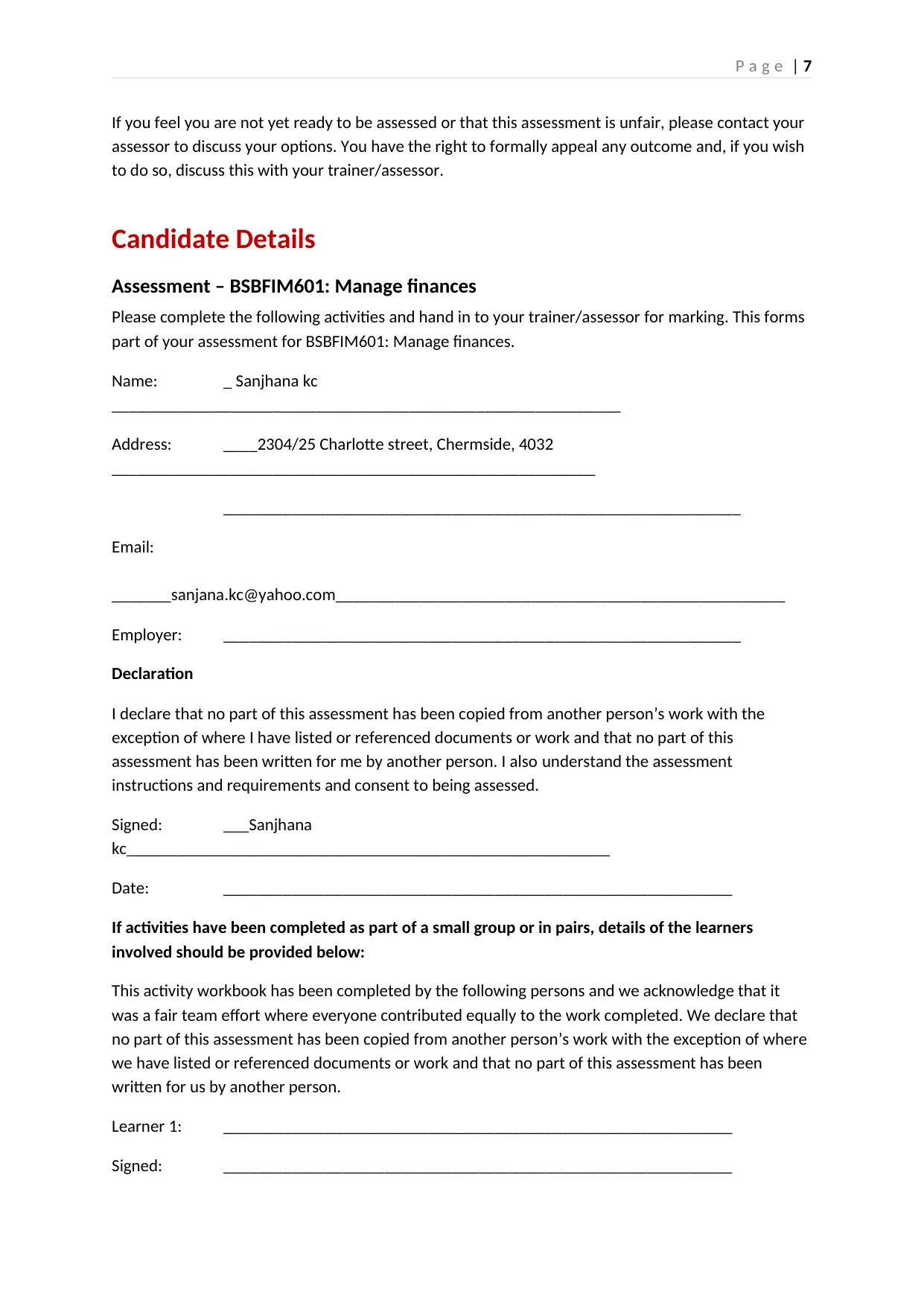
P a g e | 7
If you feel you are not yet ready to be assessed or that this assessment is unfair, please contact your
assessor to discuss your options. You have the right to formally appeal any outcome and, if you wish
to do so, discuss this with your trainer/assessor.
Candidate Details
Assessment – BSBFIM601: Manage finances
Please complete the following activities and hand in to your trainer/assessor for marking. This forms
part of your assessment for BSBFIM601: Manage finances.
Name: _ Sanjhana kc
____________________________________________________________
Address: ____2304/25 Charlotte street, Chermside, 4032
_________________________________________________________
_____________________________________________________________
Email:
_______sanjana.kc@yahoo.com_____________________________________________________
Employer: _____________________________________________________________
Declaration
I declare that no part of this assessment has been copied from another person’s work with the
exception of where I have listed or referenced documents or work and that no part of this
assessment has been written for me by another person. I also understand the assessment
instructions and requirements and consent to being assessed.
Signed: ___Sanjhana
kc_________________________________________________________
Date: ____________________________________________________________
If activities have been completed as part of a small group or in pairs, details of the learners
involved should be provided below:
This activity workbook has been completed by the following persons and we acknowledge that it
was a fair team effort where everyone contributed equally to the work completed. We declare that
no part of this assessment has been copied from another person’s work with the exception of where
we have listed or referenced documents or work and that no part of this assessment has been
written for us by another person.
Learner 1: ____________________________________________________________
Signed: ____________________________________________________________
If you feel you are not yet ready to be assessed or that this assessment is unfair, please contact your
assessor to discuss your options. You have the right to formally appeal any outcome and, if you wish
to do so, discuss this with your trainer/assessor.
Candidate Details
Assessment – BSBFIM601: Manage finances
Please complete the following activities and hand in to your trainer/assessor for marking. This forms
part of your assessment for BSBFIM601: Manage finances.
Name: _ Sanjhana kc
____________________________________________________________
Address: ____2304/25 Charlotte street, Chermside, 4032
_________________________________________________________
_____________________________________________________________
Email:
_______sanjana.kc@yahoo.com_____________________________________________________
Employer: _____________________________________________________________
Declaration
I declare that no part of this assessment has been copied from another person’s work with the
exception of where I have listed or referenced documents or work and that no part of this
assessment has been written for me by another person. I also understand the assessment
instructions and requirements and consent to being assessed.
Signed: ___Sanjhana
kc_________________________________________________________
Date: ____________________________________________________________
If activities have been completed as part of a small group or in pairs, details of the learners
involved should be provided below:
This activity workbook has been completed by the following persons and we acknowledge that it
was a fair team effort where everyone contributed equally to the work completed. We declare that
no part of this assessment has been copied from another person’s work with the exception of where
we have listed or referenced documents or work and that no part of this assessment has been
written for us by another person.
Learner 1: ____________________________________________________________
Signed: ____________________________________________________________

P a g e | 8
Learner 2: ____________________________________________________________
Signed: ____________________________________________________________
Learner 3: ____________________________________________________________
Signed: ____________________________________________________________
Learner 2: ____________________________________________________________
Signed: ____________________________________________________________
Learner 3: ____________________________________________________________
Signed: ____________________________________________________________
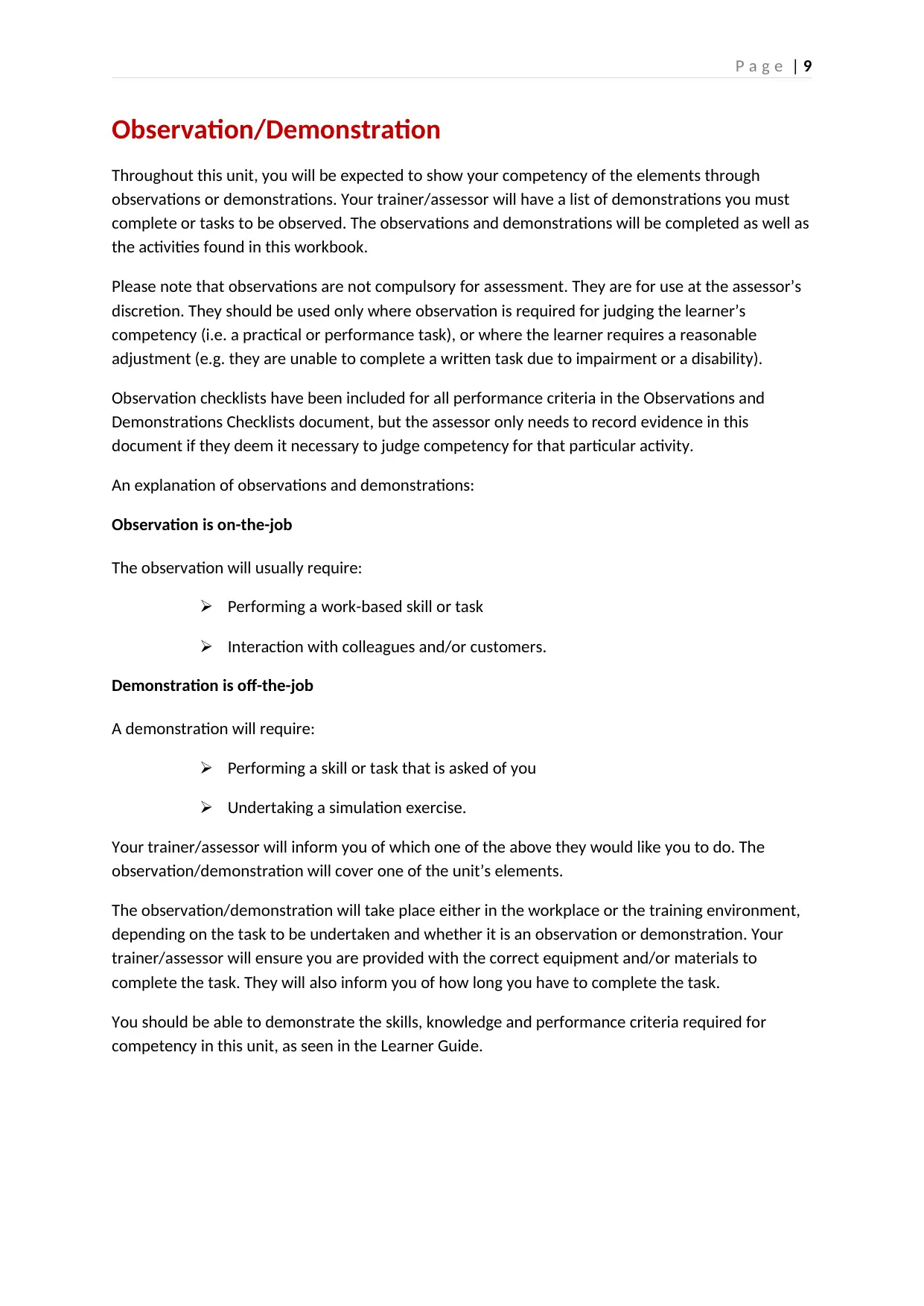
P a g e | 9
Observation/Demonstration
Throughout this unit, you will be expected to show your competency of the elements through
observations or demonstrations. Your trainer/assessor will have a list of demonstrations you must
complete or tasks to be observed. The observations and demonstrations will be completed as well as
the activities found in this workbook.
Please note that observations are not compulsory for assessment. They are for use at the assessor’s
discretion. They should be used only where observation is required for judging the learner’s
competency (i.e. a practical or performance task), or where the learner requires a reasonable
adjustment (e.g. they are unable to complete a written task due to impairment or a disability).
Observation checklists have been included for all performance criteria in the Observations and
Demonstrations Checklists document, but the assessor only needs to record evidence in this
document if they deem it necessary to judge competency for that particular activity.
An explanation of observations and demonstrations:
Observation is on-the-job
The observation will usually require:
Performing a work-based skill or task
Interaction with colleagues and/or customers.
Demonstration is off-the-job
A demonstration will require:
Performing a skill or task that is asked of you
Undertaking a simulation exercise.
Your trainer/assessor will inform you of which one of the above they would like you to do. The
observation/demonstration will cover one of the unit’s elements.
The observation/demonstration will take place either in the workplace or the training environment,
depending on the task to be undertaken and whether it is an observation or demonstration. Your
trainer/assessor will ensure you are provided with the correct equipment and/or materials to
complete the task. They will also inform you of how long you have to complete the task.
You should be able to demonstrate the skills, knowledge and performance criteria required for
competency in this unit, as seen in the Learner Guide.
Observation/Demonstration
Throughout this unit, you will be expected to show your competency of the elements through
observations or demonstrations. Your trainer/assessor will have a list of demonstrations you must
complete or tasks to be observed. The observations and demonstrations will be completed as well as
the activities found in this workbook.
Please note that observations are not compulsory for assessment. They are for use at the assessor’s
discretion. They should be used only where observation is required for judging the learner’s
competency (i.e. a practical or performance task), or where the learner requires a reasonable
adjustment (e.g. they are unable to complete a written task due to impairment or a disability).
Observation checklists have been included for all performance criteria in the Observations and
Demonstrations Checklists document, but the assessor only needs to record evidence in this
document if they deem it necessary to judge competency for that particular activity.
An explanation of observations and demonstrations:
Observation is on-the-job
The observation will usually require:
Performing a work-based skill or task
Interaction with colleagues and/or customers.
Demonstration is off-the-job
A demonstration will require:
Performing a skill or task that is asked of you
Undertaking a simulation exercise.
Your trainer/assessor will inform you of which one of the above they would like you to do. The
observation/demonstration will cover one of the unit’s elements.
The observation/demonstration will take place either in the workplace or the training environment,
depending on the task to be undertaken and whether it is an observation or demonstration. Your
trainer/assessor will ensure you are provided with the correct equipment and/or materials to
complete the task. They will also inform you of how long you have to complete the task.
You should be able to demonstrate the skills, knowledge and performance criteria required for
competency in this unit, as seen in the Learner Guide.
Secure Best Marks with AI Grader
Need help grading? Try our AI Grader for instant feedback on your assignments.
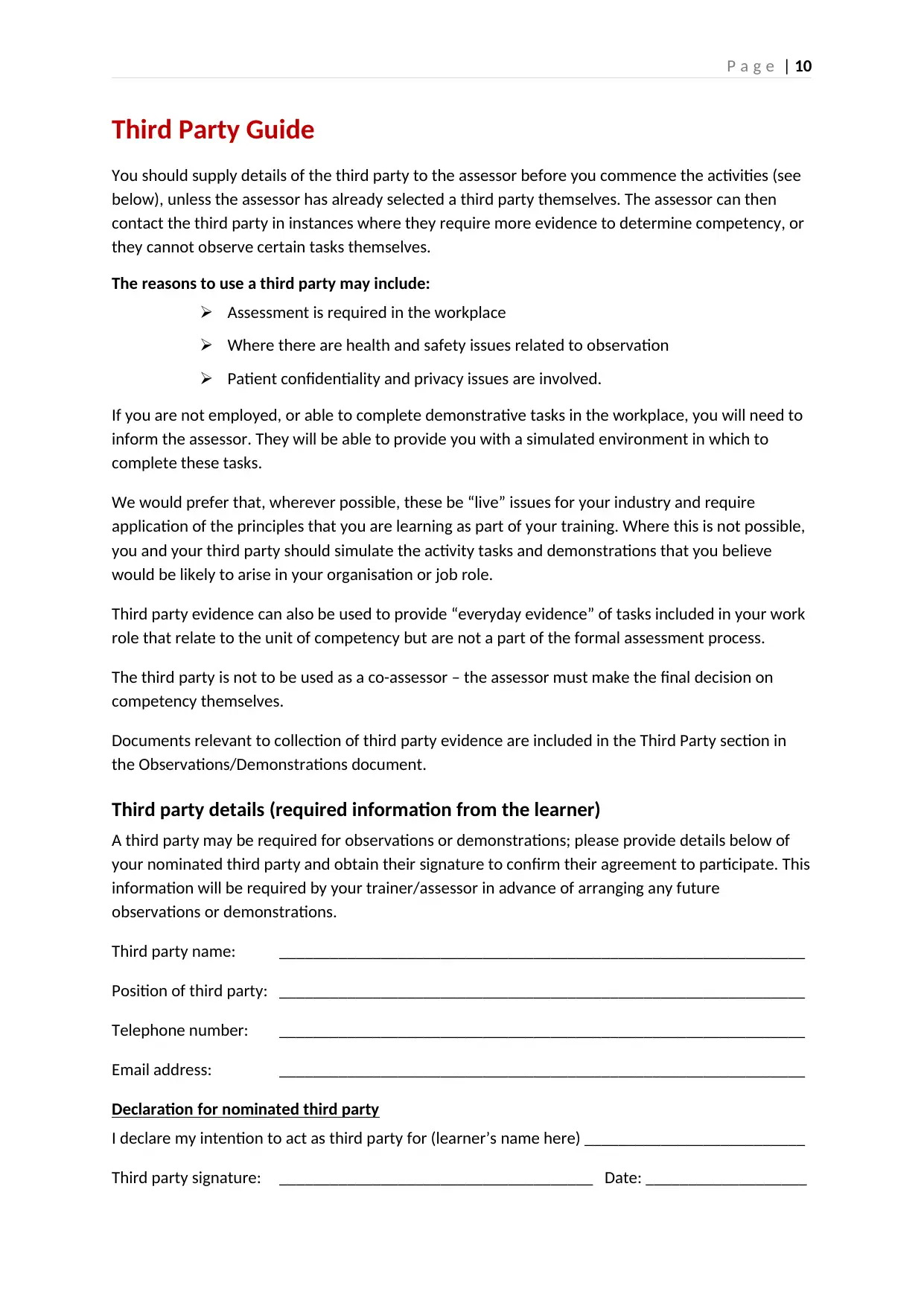
P a g e | 10
Third Party Guide
You should supply details of the third party to the assessor before you commence the activities (see
below), unless the assessor has already selected a third party themselves. The assessor can then
contact the third party in instances where they require more evidence to determine competency, or
they cannot observe certain tasks themselves.
The reasons to use a third party may include:
Assessment is required in the workplace
Where there are health and safety issues related to observation
Patient confidentiality and privacy issues are involved.
If you are not employed, or able to complete demonstrative tasks in the workplace, you will need to
inform the assessor. They will be able to provide you with a simulated environment in which to
complete these tasks.
We would prefer that, wherever possible, these be “live” issues for your industry and require
application of the principles that you are learning as part of your training. Where this is not possible,
you and your third party should simulate the activity tasks and demonstrations that you believe
would be likely to arise in your organisation or job role.
Third party evidence can also be used to provide “everyday evidence” of tasks included in your work
role that relate to the unit of competency but are not a part of the formal assessment process.
The third party is not to be used as a co-assessor – the assessor must make the final decision on
competency themselves.
Documents relevant to collection of third party evidence are included in the Third Party section in
the Observations/Demonstrations document.
Third party details (required information from the learner)
A third party may be required for observations or demonstrations; please provide details below of
your nominated third party and obtain their signature to confirm their agreement to participate. This
information will be required by your trainer/assessor in advance of arranging any future
observations or demonstrations.
Third party name: ______________________________________________________________
Position of third party: ______________________________________________________________
Telephone number: ______________________________________________________________
Email address: ______________________________________________________________
Declaration for nominated third party
I declare my intention to act as third party for (learner’s name here) __________________________
Third party signature: _____________________________________ Date: ___________________
Third Party Guide
You should supply details of the third party to the assessor before you commence the activities (see
below), unless the assessor has already selected a third party themselves. The assessor can then
contact the third party in instances where they require more evidence to determine competency, or
they cannot observe certain tasks themselves.
The reasons to use a third party may include:
Assessment is required in the workplace
Where there are health and safety issues related to observation
Patient confidentiality and privacy issues are involved.
If you are not employed, or able to complete demonstrative tasks in the workplace, you will need to
inform the assessor. They will be able to provide you with a simulated environment in which to
complete these tasks.
We would prefer that, wherever possible, these be “live” issues for your industry and require
application of the principles that you are learning as part of your training. Where this is not possible,
you and your third party should simulate the activity tasks and demonstrations that you believe
would be likely to arise in your organisation or job role.
Third party evidence can also be used to provide “everyday evidence” of tasks included in your work
role that relate to the unit of competency but are not a part of the formal assessment process.
The third party is not to be used as a co-assessor – the assessor must make the final decision on
competency themselves.
Documents relevant to collection of third party evidence are included in the Third Party section in
the Observations/Demonstrations document.
Third party details (required information from the learner)
A third party may be required for observations or demonstrations; please provide details below of
your nominated third party and obtain their signature to confirm their agreement to participate. This
information will be required by your trainer/assessor in advance of arranging any future
observations or demonstrations.
Third party name: ______________________________________________________________
Position of third party: ______________________________________________________________
Telephone number: ______________________________________________________________
Email address: ______________________________________________________________
Declaration for nominated third party
I declare my intention to act as third party for (learner’s name here) __________________________
Third party signature: _____________________________________ Date: ___________________
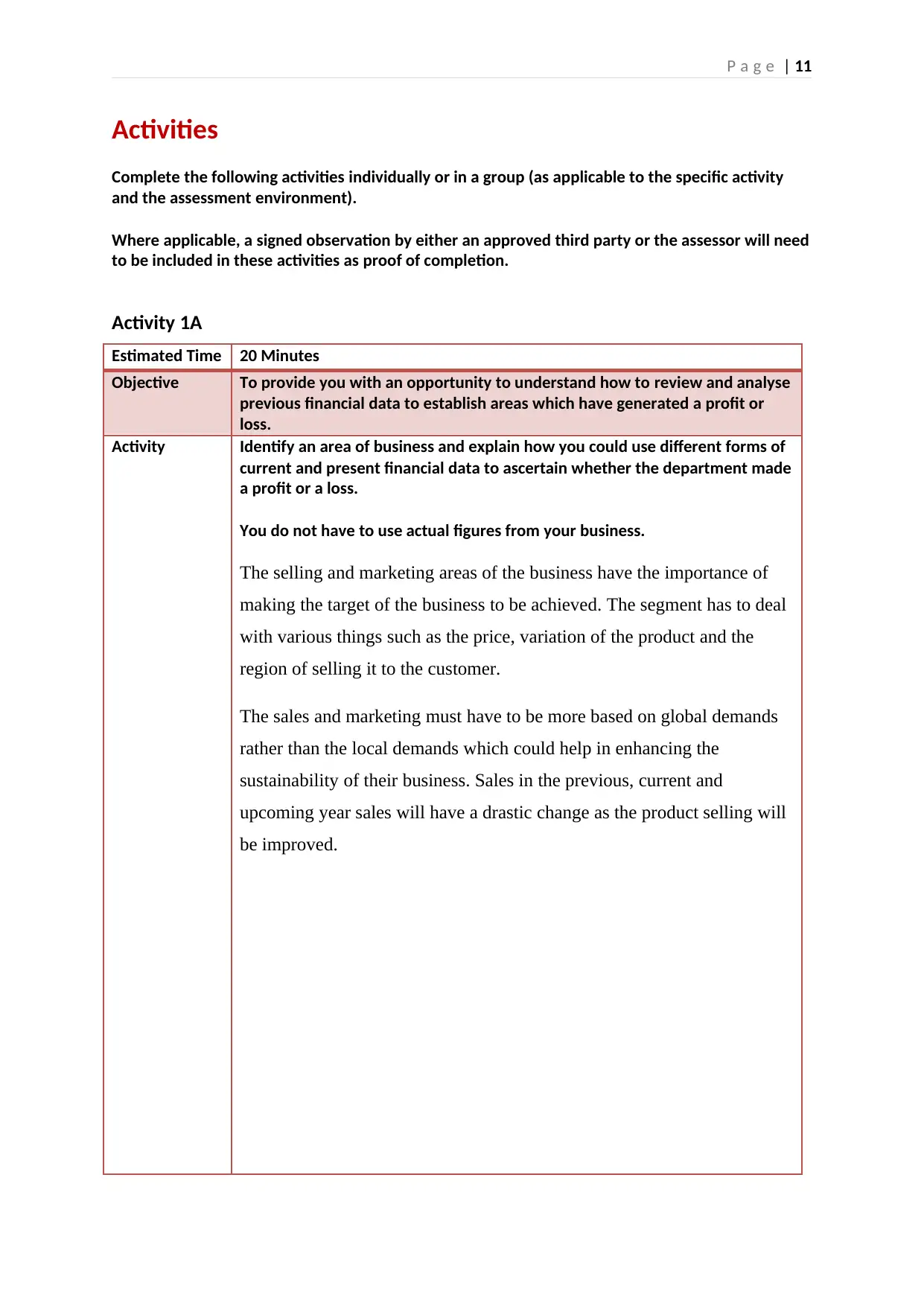
P a g e | 11
Activities
Complete the following activities individually or in a group (as applicable to the specific activity
and the assessment environment).
Where applicable, a signed observation by either an approved third party or the assessor will need
to be included in these activities as proof of completion.
Activity 1A
Estimated Time 20 Minutes
Objective To provide you with an opportunity to understand how to review and analyse
previous financial data to establish areas which have generated a profit or
loss.
Activity Identify an area of business and explain how you could use different forms of
current and present financial data to ascertain whether the department made
a profit or a loss.
You do not have to use actual figures from your business.
The selling and marketing areas of the business have the importance of
making the target of the business to be achieved. The segment has to deal
with various things such as the price, variation of the product and the
region of selling it to the customer.
The sales and marketing must have to be more based on global demands
rather than the local demands which could help in enhancing the
sustainability of their business. Sales in the previous, current and
upcoming year sales will have a drastic change as the product selling will
be improved.
Activities
Complete the following activities individually or in a group (as applicable to the specific activity
and the assessment environment).
Where applicable, a signed observation by either an approved third party or the assessor will need
to be included in these activities as proof of completion.
Activity 1A
Estimated Time 20 Minutes
Objective To provide you with an opportunity to understand how to review and analyse
previous financial data to establish areas which have generated a profit or
loss.
Activity Identify an area of business and explain how you could use different forms of
current and present financial data to ascertain whether the department made
a profit or a loss.
You do not have to use actual figures from your business.
The selling and marketing areas of the business have the importance of
making the target of the business to be achieved. The segment has to deal
with various things such as the price, variation of the product and the
region of selling it to the customer.
The sales and marketing must have to be more based on global demands
rather than the local demands which could help in enhancing the
sustainability of their business. Sales in the previous, current and
upcoming year sales will have a drastic change as the product selling will
be improved.

P a g e | 12
Activity 1A checklist – for assessor
This should be used by the trainer/assessor to document the learner’s skills, knowledge and
performance as relevant to the unit activity. Indicate in the table below if the learner is deemed
satisfactory (S) or not satisfactory (NS) for the activity or if reassessment is required.
Learner’s name Sanjhana kc
Assessor’s name Njau Gitu
Unit of Competence
(Code and Title) BSBFIM601 Manage finances
Date(s) of assessment 6/3/2019
Has the activity been answered and performed fully, as required to assess the
competency of the learner?
Yes No
(Please circle)
Has sufficient evidence and information been provided by the learner for the
activity?
Yes No
(Please circle)
Comments
Provide your comments here:
The learner’s Not yet satisfactory Satisfactory
Activity 1A checklist – for assessor
This should be used by the trainer/assessor to document the learner’s skills, knowledge and
performance as relevant to the unit activity. Indicate in the table below if the learner is deemed
satisfactory (S) or not satisfactory (NS) for the activity or if reassessment is required.
Learner’s name Sanjhana kc
Assessor’s name Njau Gitu
Unit of Competence
(Code and Title) BSBFIM601 Manage finances
Date(s) of assessment 6/3/2019
Has the activity been answered and performed fully, as required to assess the
competency of the learner?
Yes No
(Please circle)
Has sufficient evidence and information been provided by the learner for the
activity?
Yes No
(Please circle)
Comments
Provide your comments here:
The learner’s Not yet satisfactory Satisfactory
Paraphrase This Document
Need a fresh take? Get an instant paraphrase of this document with our AI Paraphraser
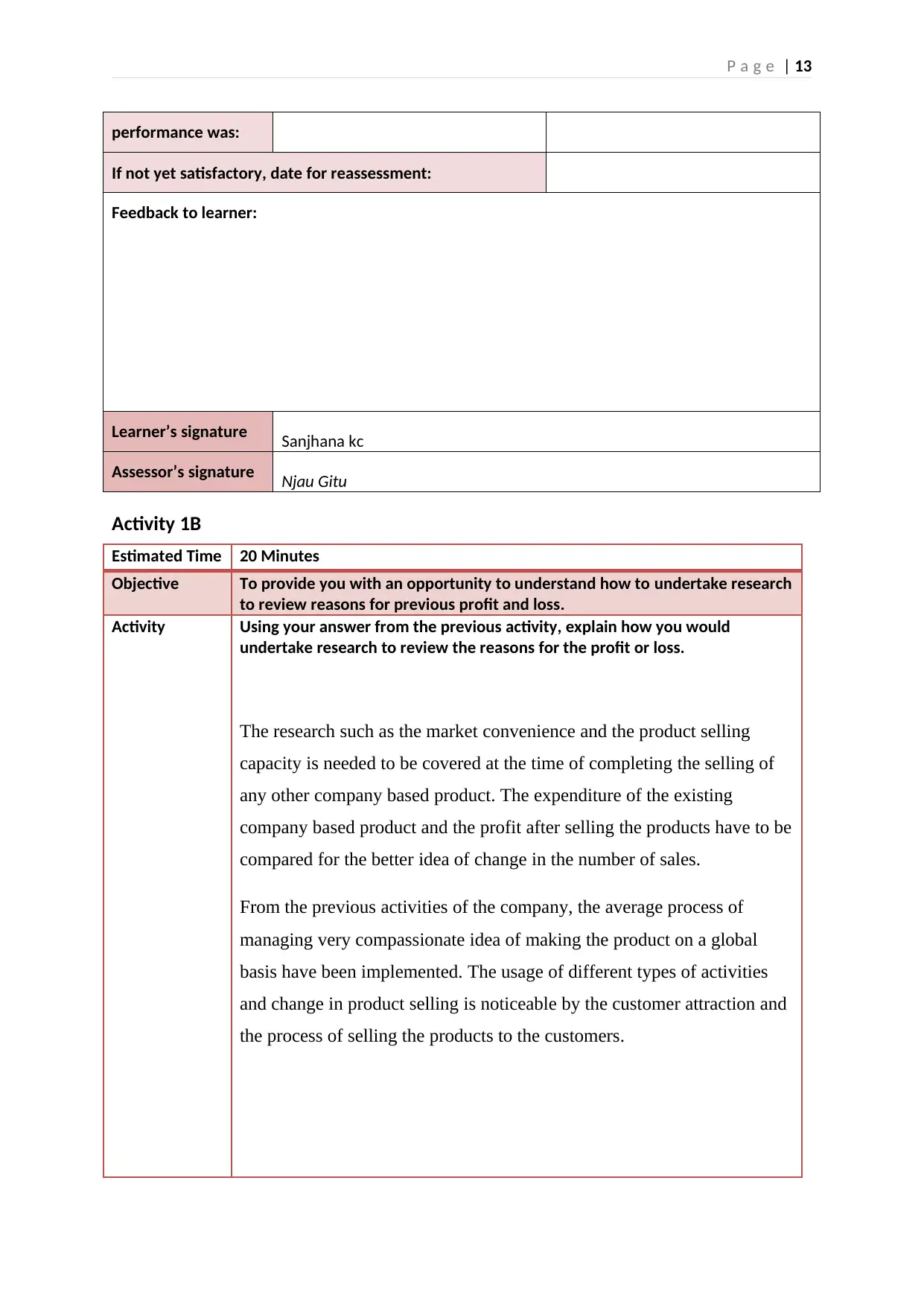
P a g e | 13
performance was:
If not yet satisfactory, date for reassessment:
Feedback to learner:
Learner’s signature Sanjhana kc
Assessor’s signature Njau Gitu
Activity 1B
Estimated Time 20 Minutes
Objective To provide you with an opportunity to understand how to undertake research
to review reasons for previous profit and loss.
Activity Using your answer from the previous activity, explain how you would
undertake research to review the reasons for the profit or loss.
The research such as the market convenience and the product selling
capacity is needed to be covered at the time of completing the selling of
any other company based product. The expenditure of the existing
company based product and the profit after selling the products have to be
compared for the better idea of change in the number of sales.
From the previous activities of the company, the average process of
managing very compassionate idea of making the product on a global
basis have been implemented. The usage of different types of activities
and change in product selling is noticeable by the customer attraction and
the process of selling the products to the customers.
performance was:
If not yet satisfactory, date for reassessment:
Feedback to learner:
Learner’s signature Sanjhana kc
Assessor’s signature Njau Gitu
Activity 1B
Estimated Time 20 Minutes
Objective To provide you with an opportunity to understand how to undertake research
to review reasons for previous profit and loss.
Activity Using your answer from the previous activity, explain how you would
undertake research to review the reasons for the profit or loss.
The research such as the market convenience and the product selling
capacity is needed to be covered at the time of completing the selling of
any other company based product. The expenditure of the existing
company based product and the profit after selling the products have to be
compared for the better idea of change in the number of sales.
From the previous activities of the company, the average process of
managing very compassionate idea of making the product on a global
basis have been implemented. The usage of different types of activities
and change in product selling is noticeable by the customer attraction and
the process of selling the products to the customers.
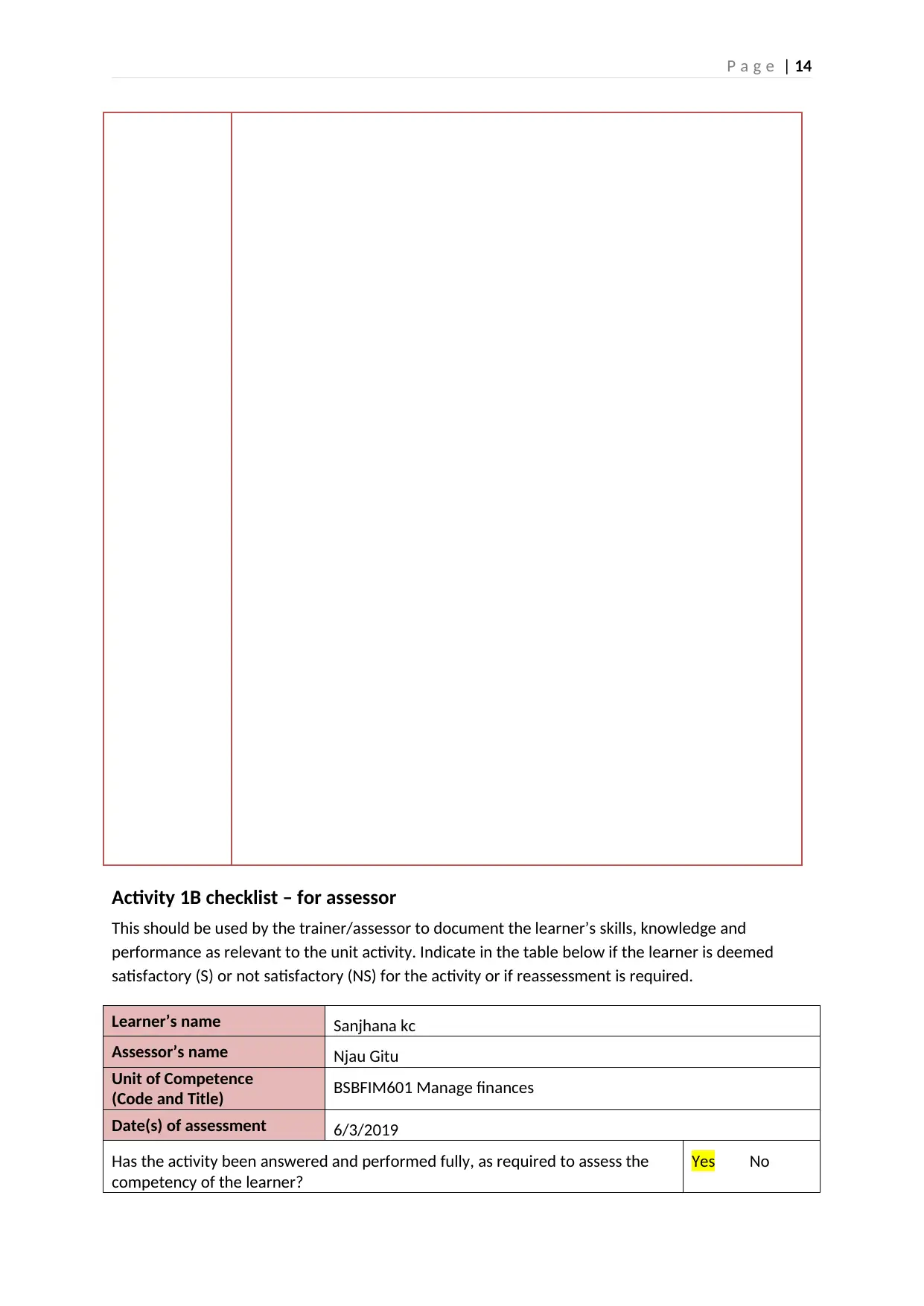
P a g e | 14
Activity 1B checklist – for assessor
This should be used by the trainer/assessor to document the learner’s skills, knowledge and
performance as relevant to the unit activity. Indicate in the table below if the learner is deemed
satisfactory (S) or not satisfactory (NS) for the activity or if reassessment is required.
Learner’s name Sanjhana kc
Assessor’s name Njau Gitu
Unit of Competence
(Code and Title) BSBFIM601 Manage finances
Date(s) of assessment 6/3/2019
Has the activity been answered and performed fully, as required to assess the
competency of the learner?
Yes No
Activity 1B checklist – for assessor
This should be used by the trainer/assessor to document the learner’s skills, knowledge and
performance as relevant to the unit activity. Indicate in the table below if the learner is deemed
satisfactory (S) or not satisfactory (NS) for the activity or if reassessment is required.
Learner’s name Sanjhana kc
Assessor’s name Njau Gitu
Unit of Competence
(Code and Title) BSBFIM601 Manage finances
Date(s) of assessment 6/3/2019
Has the activity been answered and performed fully, as required to assess the
competency of the learner?
Yes No
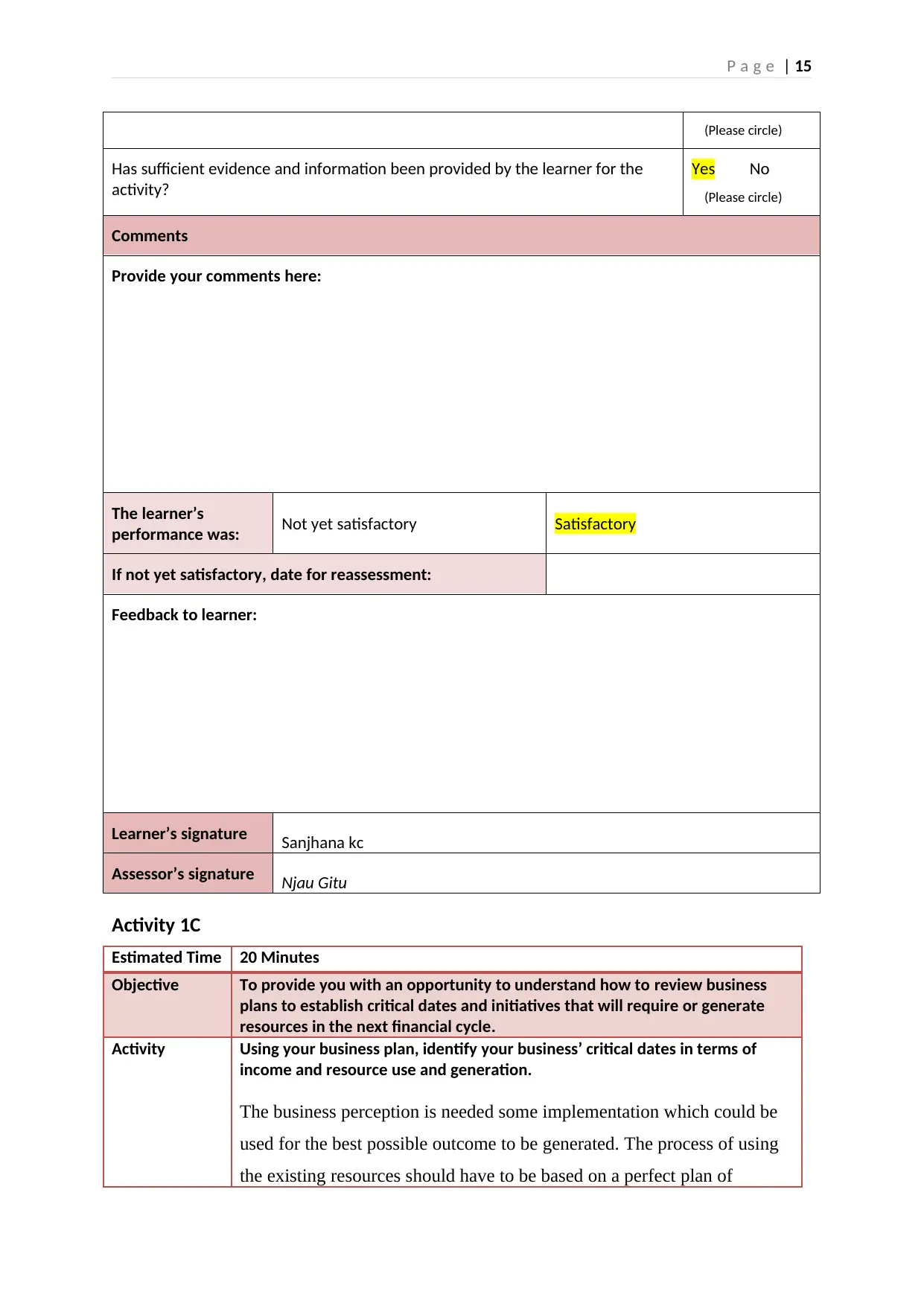
P a g e | 15
(Please circle)
Has sufficient evidence and information been provided by the learner for the
activity?
Yes No
(Please circle)
Comments
Provide your comments here:
The learner’s
performance was: Not yet satisfactory Satisfactory
If not yet satisfactory, date for reassessment:
Feedback to learner:
Learner’s signature Sanjhana kc
Assessor’s signature Njau Gitu
Activity 1C
Estimated Time 20 Minutes
Objective To provide you with an opportunity to understand how to review business
plans to establish critical dates and initiatives that will require or generate
resources in the next financial cycle.
Activity Using your business plan, identify your business’ critical dates in terms of
income and resource use and generation.
The business perception is needed some implementation which could be
used for the best possible outcome to be generated. The process of using
the existing resources should have to be based on a perfect plan of
(Please circle)
Has sufficient evidence and information been provided by the learner for the
activity?
Yes No
(Please circle)
Comments
Provide your comments here:
The learner’s
performance was: Not yet satisfactory Satisfactory
If not yet satisfactory, date for reassessment:
Feedback to learner:
Learner’s signature Sanjhana kc
Assessor’s signature Njau Gitu
Activity 1C
Estimated Time 20 Minutes
Objective To provide you with an opportunity to understand how to review business
plans to establish critical dates and initiatives that will require or generate
resources in the next financial cycle.
Activity Using your business plan, identify your business’ critical dates in terms of
income and resource use and generation.
The business perception is needed some implementation which could be
used for the best possible outcome to be generated. The process of using
the existing resources should have to be based on a perfect plan of
Secure Best Marks with AI Grader
Need help grading? Try our AI Grader for instant feedback on your assignments.

P a g e | 16
critically measured of the project activity.
The income should have to be generated by both increasing the sales and
the innovation in the technique and method invoked in producing or
manufacturing the product. The implementation of the latest plan and the
funding for the latest plan would be easy as per the recommended outlines
to follow. The dates such as End of Financial Year Sales (EOFYS) and
Boxing day have been considered as per the needed segmentation.
critically measured of the project activity.
The income should have to be generated by both increasing the sales and
the innovation in the technique and method invoked in producing or
manufacturing the product. The implementation of the latest plan and the
funding for the latest plan would be easy as per the recommended outlines
to follow. The dates such as End of Financial Year Sales (EOFYS) and
Boxing day have been considered as per the needed segmentation.
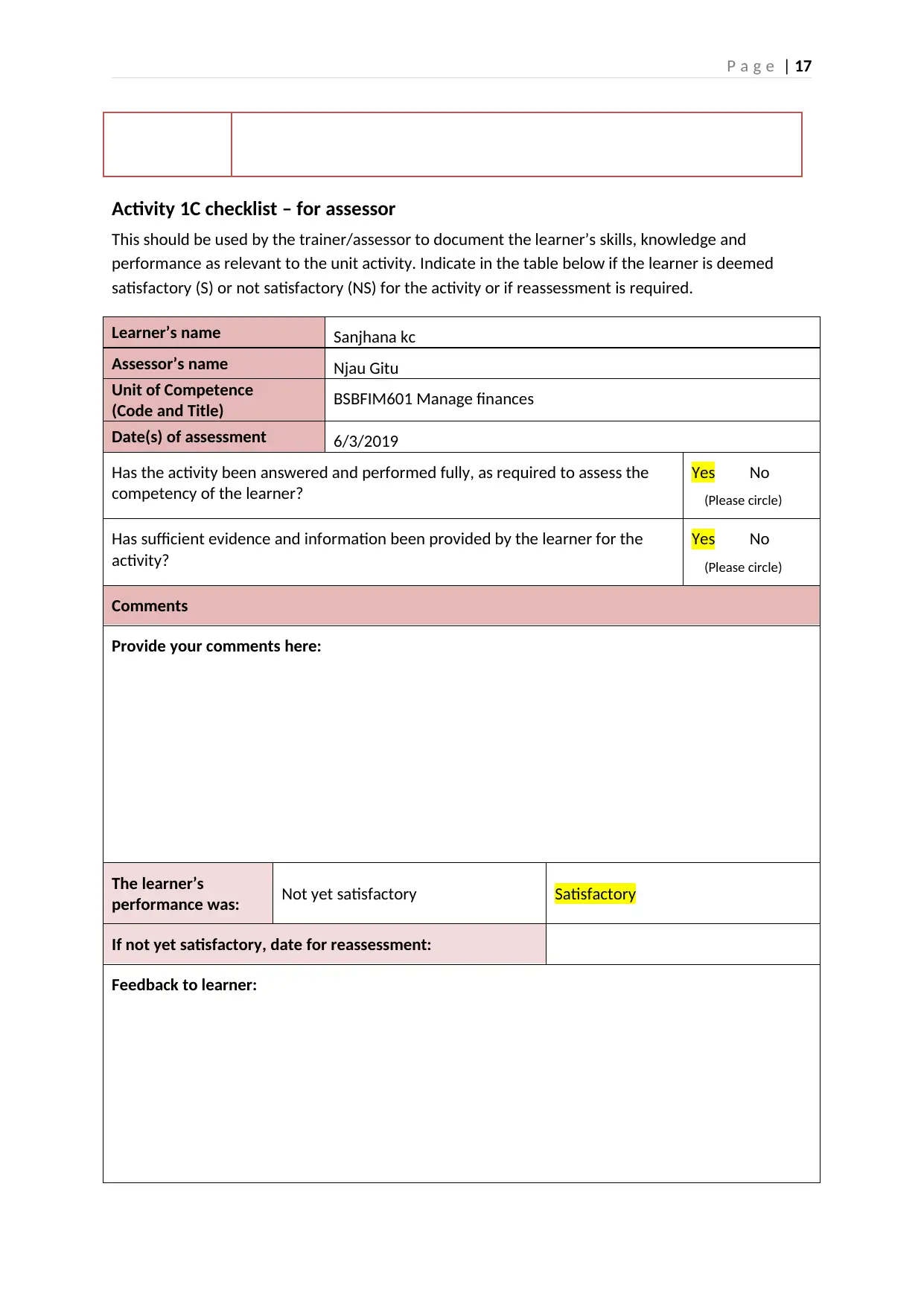
P a g e | 17
Activity 1C checklist – for assessor
This should be used by the trainer/assessor to document the learner’s skills, knowledge and
performance as relevant to the unit activity. Indicate in the table below if the learner is deemed
satisfactory (S) or not satisfactory (NS) for the activity or if reassessment is required.
Learner’s name Sanjhana kc
Assessor’s name Njau Gitu
Unit of Competence
(Code and Title) BSBFIM601 Manage finances
Date(s) of assessment 6/3/2019
Has the activity been answered and performed fully, as required to assess the
competency of the learner?
Yes No
(Please circle)
Has sufficient evidence and information been provided by the learner for the
activity?
Yes No
(Please circle)
Comments
Provide your comments here:
The learner’s
performance was: Not yet satisfactory Satisfactory
If not yet satisfactory, date for reassessment:
Feedback to learner:
Activity 1C checklist – for assessor
This should be used by the trainer/assessor to document the learner’s skills, knowledge and
performance as relevant to the unit activity. Indicate in the table below if the learner is deemed
satisfactory (S) or not satisfactory (NS) for the activity or if reassessment is required.
Learner’s name Sanjhana kc
Assessor’s name Njau Gitu
Unit of Competence
(Code and Title) BSBFIM601 Manage finances
Date(s) of assessment 6/3/2019
Has the activity been answered and performed fully, as required to assess the
competency of the learner?
Yes No
(Please circle)
Has sufficient evidence and information been provided by the learner for the
activity?
Yes No
(Please circle)
Comments
Provide your comments here:
The learner’s
performance was: Not yet satisfactory Satisfactory
If not yet satisfactory, date for reassessment:
Feedback to learner:
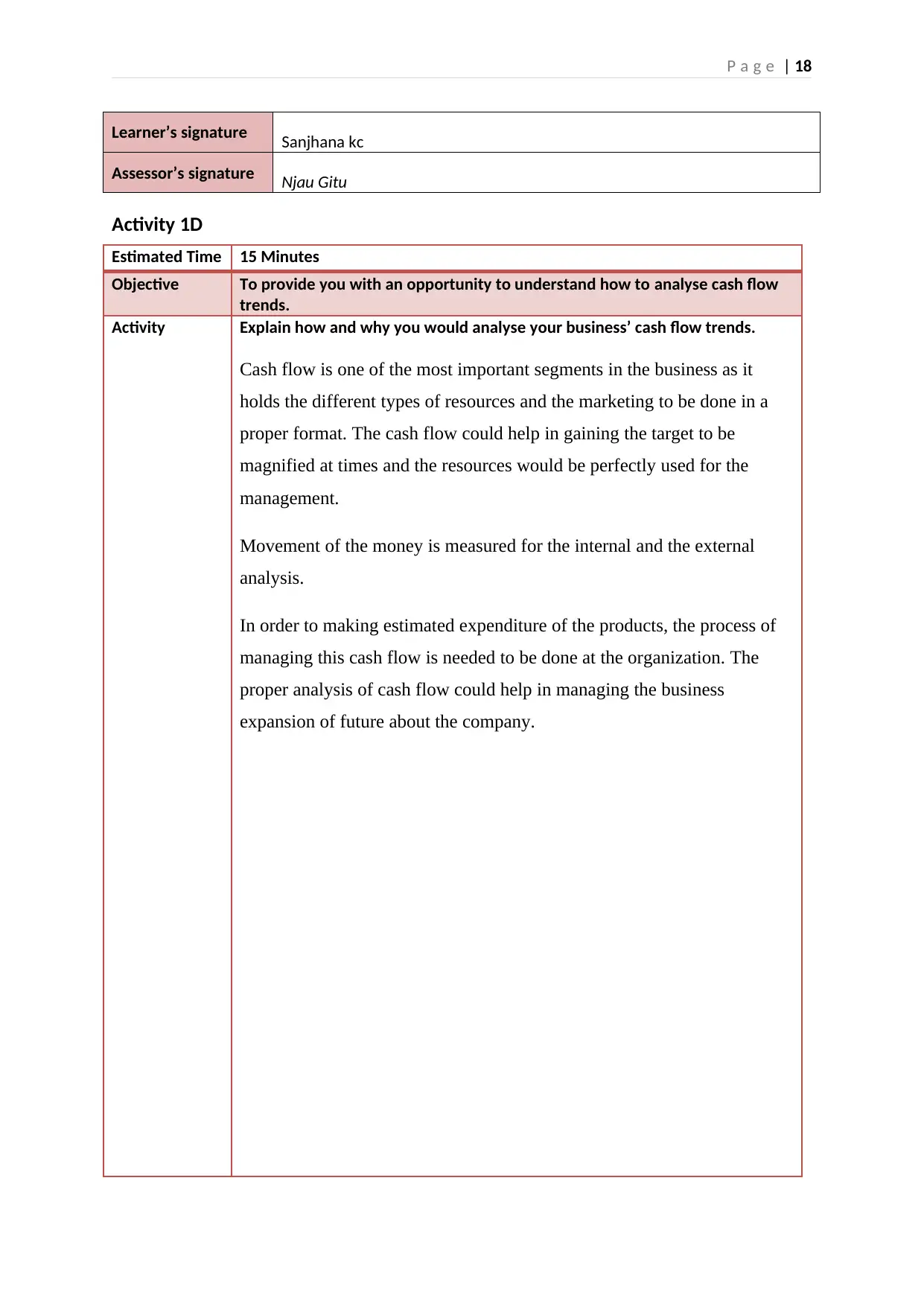
P a g e | 18
Learner’s signature Sanjhana kc
Assessor’s signature Njau Gitu
Activity 1D
Estimated Time 15 Minutes
Objective To provide you with an opportunity to understand how to analyse cash flow
trends.
Activity Explain how and why you would analyse your business’ cash flow trends.
Cash flow is one of the most important segments in the business as it
holds the different types of resources and the marketing to be done in a
proper format. The cash flow could help in gaining the target to be
magnified at times and the resources would be perfectly used for the
management.
Movement of the money is measured for the internal and the external
analysis.
In order to making estimated expenditure of the products, the process of
managing this cash flow is needed to be done at the organization. The
proper analysis of cash flow could help in managing the business
expansion of future about the company.
Learner’s signature Sanjhana kc
Assessor’s signature Njau Gitu
Activity 1D
Estimated Time 15 Minutes
Objective To provide you with an opportunity to understand how to analyse cash flow
trends.
Activity Explain how and why you would analyse your business’ cash flow trends.
Cash flow is one of the most important segments in the business as it
holds the different types of resources and the marketing to be done in a
proper format. The cash flow could help in gaining the target to be
magnified at times and the resources would be perfectly used for the
management.
Movement of the money is measured for the internal and the external
analysis.
In order to making estimated expenditure of the products, the process of
managing this cash flow is needed to be done at the organization. The
proper analysis of cash flow could help in managing the business
expansion of future about the company.
Paraphrase This Document
Need a fresh take? Get an instant paraphrase of this document with our AI Paraphraser

P a g e | 19
Activity 1D checklist – for assessor
This should be used by the trainer/assessor to document the learner’s skills, knowledge and
performance as relevant to the unit activity. Indicate in the table below if the learner is deemed
satisfactory (S) or not satisfactory (NS) for the activity or if reassessment is required.
Learner’s name Sanjhana kc
Assessor’s name Njau Gitu
Unit of Competence
(Code and Title) BSBFIM601 Manage finances
Date(s) of assessment 6/3/2019
Has the activity been answered and performed fully, as required to assess the
competency of the learner?
Yes No
(Please circle)
Has sufficient evidence and information been provided by the learner for the
activity?
Yes No
(Please circle)
Comments
Provide your comments here:
Activity 1D checklist – for assessor
This should be used by the trainer/assessor to document the learner’s skills, knowledge and
performance as relevant to the unit activity. Indicate in the table below if the learner is deemed
satisfactory (S) or not satisfactory (NS) for the activity or if reassessment is required.
Learner’s name Sanjhana kc
Assessor’s name Njau Gitu
Unit of Competence
(Code and Title) BSBFIM601 Manage finances
Date(s) of assessment 6/3/2019
Has the activity been answered and performed fully, as required to assess the
competency of the learner?
Yes No
(Please circle)
Has sufficient evidence and information been provided by the learner for the
activity?
Yes No
(Please circle)
Comments
Provide your comments here:
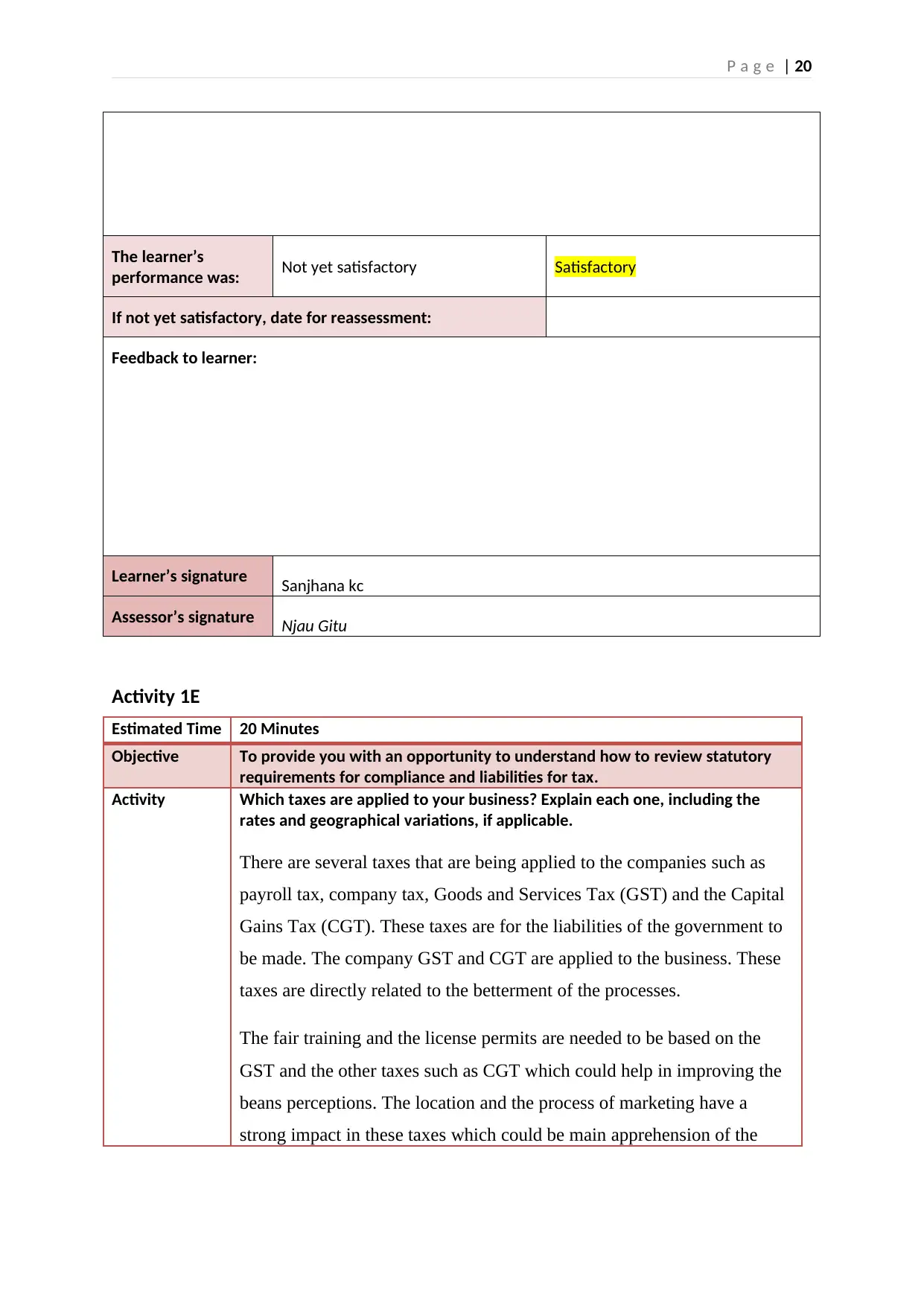
P a g e | 20
The learner’s
performance was: Not yet satisfactory Satisfactory
If not yet satisfactory, date for reassessment:
Feedback to learner:
Learner’s signature Sanjhana kc
Assessor’s signature Njau Gitu
Activity 1E
Estimated Time 20 Minutes
Objective To provide you with an opportunity to understand how to review statutory
requirements for compliance and liabilities for tax.
Activity Which taxes are applied to your business? Explain each one, including the
rates and geographical variations, if applicable.
There are several taxes that are being applied to the companies such as
payroll tax, company tax, Goods and Services Tax (GST) and the Capital
Gains Tax (CGT). These taxes are for the liabilities of the government to
be made. The company GST and CGT are applied to the business. These
taxes are directly related to the betterment of the processes.
The fair training and the license permits are needed to be based on the
GST and the other taxes such as CGT which could help in improving the
beans perceptions. The location and the process of marketing have a
strong impact in these taxes which could be main apprehension of the
The learner’s
performance was: Not yet satisfactory Satisfactory
If not yet satisfactory, date for reassessment:
Feedback to learner:
Learner’s signature Sanjhana kc
Assessor’s signature Njau Gitu
Activity 1E
Estimated Time 20 Minutes
Objective To provide you with an opportunity to understand how to review statutory
requirements for compliance and liabilities for tax.
Activity Which taxes are applied to your business? Explain each one, including the
rates and geographical variations, if applicable.
There are several taxes that are being applied to the companies such as
payroll tax, company tax, Goods and Services Tax (GST) and the Capital
Gains Tax (CGT). These taxes are for the liabilities of the government to
be made. The company GST and CGT are applied to the business. These
taxes are directly related to the betterment of the processes.
The fair training and the license permits are needed to be based on the
GST and the other taxes such as CGT which could help in improving the
beans perceptions. The location and the process of marketing have a
strong impact in these taxes which could be main apprehension of the
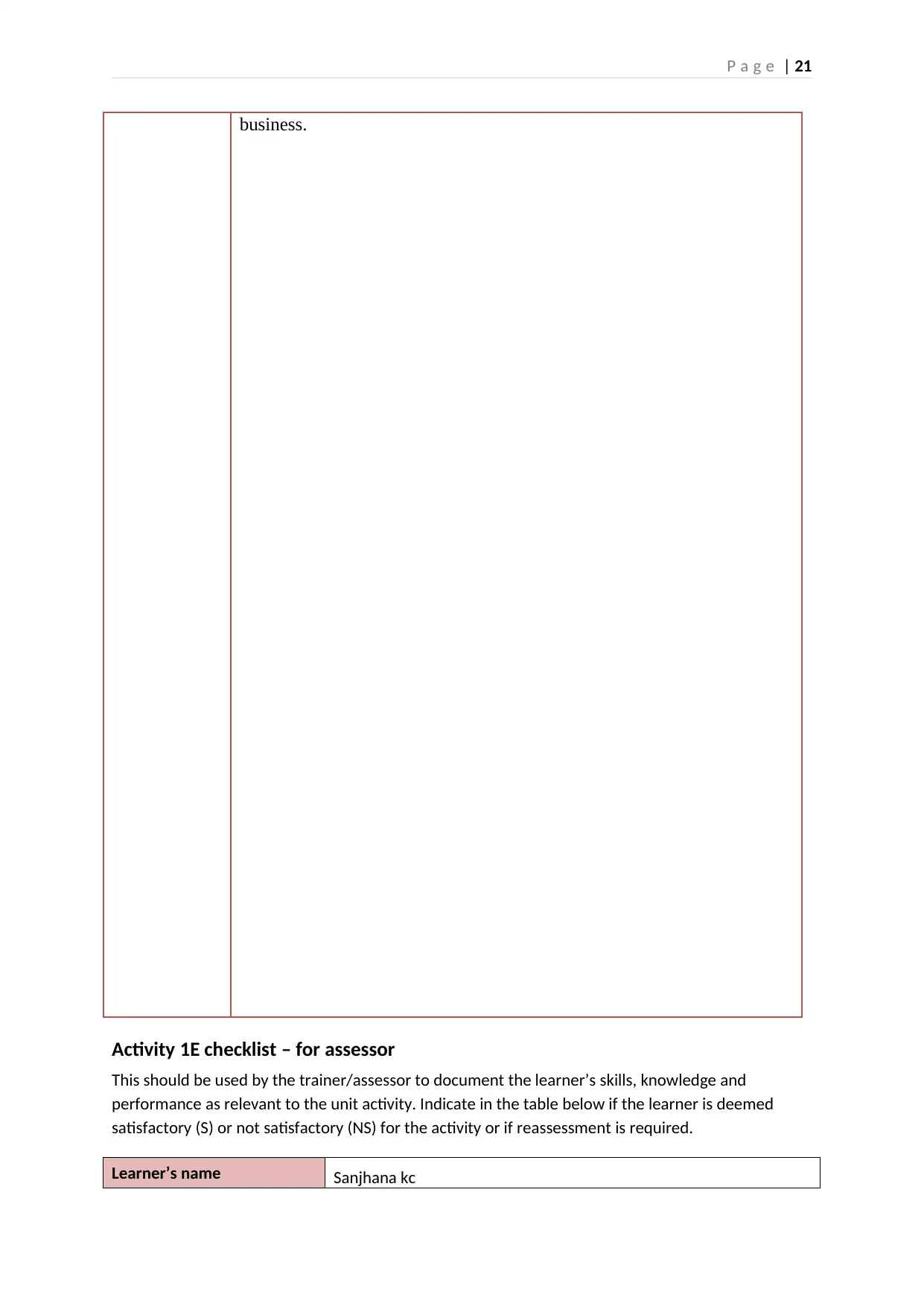
P a g e | 21
business.
Activity 1E checklist – for assessor
This should be used by the trainer/assessor to document the learner’s skills, knowledge and
performance as relevant to the unit activity. Indicate in the table below if the learner is deemed
satisfactory (S) or not satisfactory (NS) for the activity or if reassessment is required.
Learner’s name Sanjhana kc
business.
Activity 1E checklist – for assessor
This should be used by the trainer/assessor to document the learner’s skills, knowledge and
performance as relevant to the unit activity. Indicate in the table below if the learner is deemed
satisfactory (S) or not satisfactory (NS) for the activity or if reassessment is required.
Learner’s name Sanjhana kc
Secure Best Marks with AI Grader
Need help grading? Try our AI Grader for instant feedback on your assignments.
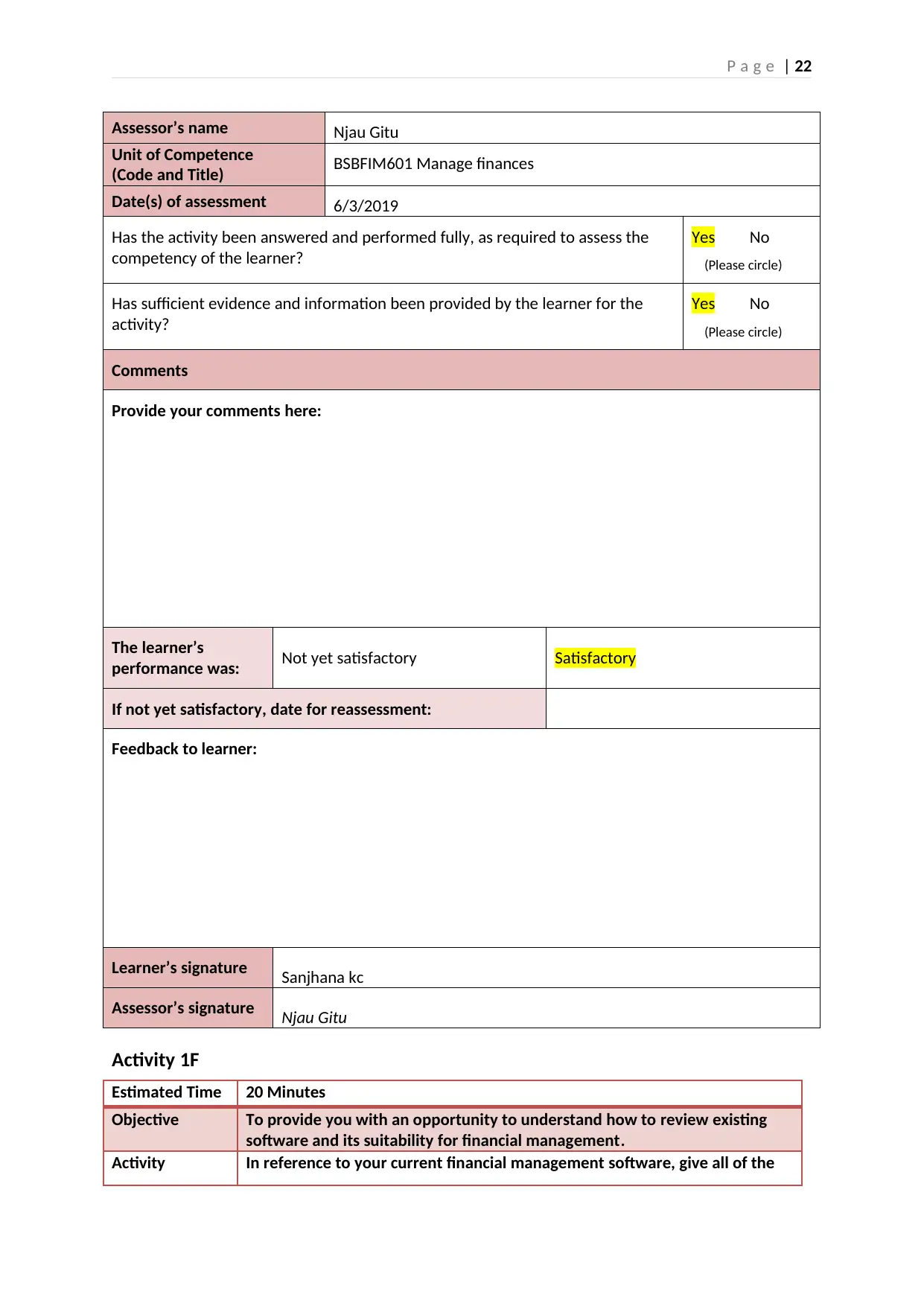
P a g e | 22
Assessor’s name Njau Gitu
Unit of Competence
(Code and Title) BSBFIM601 Manage finances
Date(s) of assessment 6/3/2019
Has the activity been answered and performed fully, as required to assess the
competency of the learner?
Yes No
(Please circle)
Has sufficient evidence and information been provided by the learner for the
activity?
Yes No
(Please circle)
Comments
Provide your comments here:
The learner’s
performance was: Not yet satisfactory Satisfactory
If not yet satisfactory, date for reassessment:
Feedback to learner:
Learner’s signature Sanjhana kc
Assessor’s signature Njau Gitu
Activity 1F
Estimated Time 20 Minutes
Objective To provide you with an opportunity to understand how to review existing
software and its suitability for financial management.
Activity In reference to your current financial management software, give all of the
Assessor’s name Njau Gitu
Unit of Competence
(Code and Title) BSBFIM601 Manage finances
Date(s) of assessment 6/3/2019
Has the activity been answered and performed fully, as required to assess the
competency of the learner?
Yes No
(Please circle)
Has sufficient evidence and information been provided by the learner for the
activity?
Yes No
(Please circle)
Comments
Provide your comments here:
The learner’s
performance was: Not yet satisfactory Satisfactory
If not yet satisfactory, date for reassessment:
Feedback to learner:
Learner’s signature Sanjhana kc
Assessor’s signature Njau Gitu
Activity 1F
Estimated Time 20 Minutes
Objective To provide you with an opportunity to understand how to review existing
software and its suitability for financial management.
Activity In reference to your current financial management software, give all of the

P a g e | 23
pros and cons you can think of.
Summarise whether you think the software is suitable for both your current
needs and future needs.
The current financial management software has the following
identifiable advantages and disadvantages
Pros
The data entry process is centralised and simple to process
Provides accurate predictions and analytics
It is well integrated to the other interfaces of management
Automation of tasks reduces errors and saves time
Cons
The maintenance cost is quite high
Highly susceptible to security issues
Specialized needs for IT professionals and technical support
The financial software would be helpful in managing the finances and
transactions of the count, balance sheet, profit and loss to be calculated
in the database. The software would be accessible to make the bills and
the reports to be managed. The software is made of the different existing
applications. The usage of this financial software is needed to be more
advised to the commercial based. The financial software of mail court
dated which could make an impact on the complicated sections to be
discussed. The usage of this software is too expensive in term of the
other software which is a cause of less using the software and the impact
of budget is high on maintain the software.
pros and cons you can think of.
Summarise whether you think the software is suitable for both your current
needs and future needs.
The current financial management software has the following
identifiable advantages and disadvantages
Pros
The data entry process is centralised and simple to process
Provides accurate predictions and analytics
It is well integrated to the other interfaces of management
Automation of tasks reduces errors and saves time
Cons
The maintenance cost is quite high
Highly susceptible to security issues
Specialized needs for IT professionals and technical support
The financial software would be helpful in managing the finances and
transactions of the count, balance sheet, profit and loss to be calculated
in the database. The software would be accessible to make the bills and
the reports to be managed. The software is made of the different existing
applications. The usage of this financial software is needed to be more
advised to the commercial based. The financial software of mail court
dated which could make an impact on the complicated sections to be
discussed. The usage of this software is too expensive in term of the
other software which is a cause of less using the software and the impact
of budget is high on maintain the software.
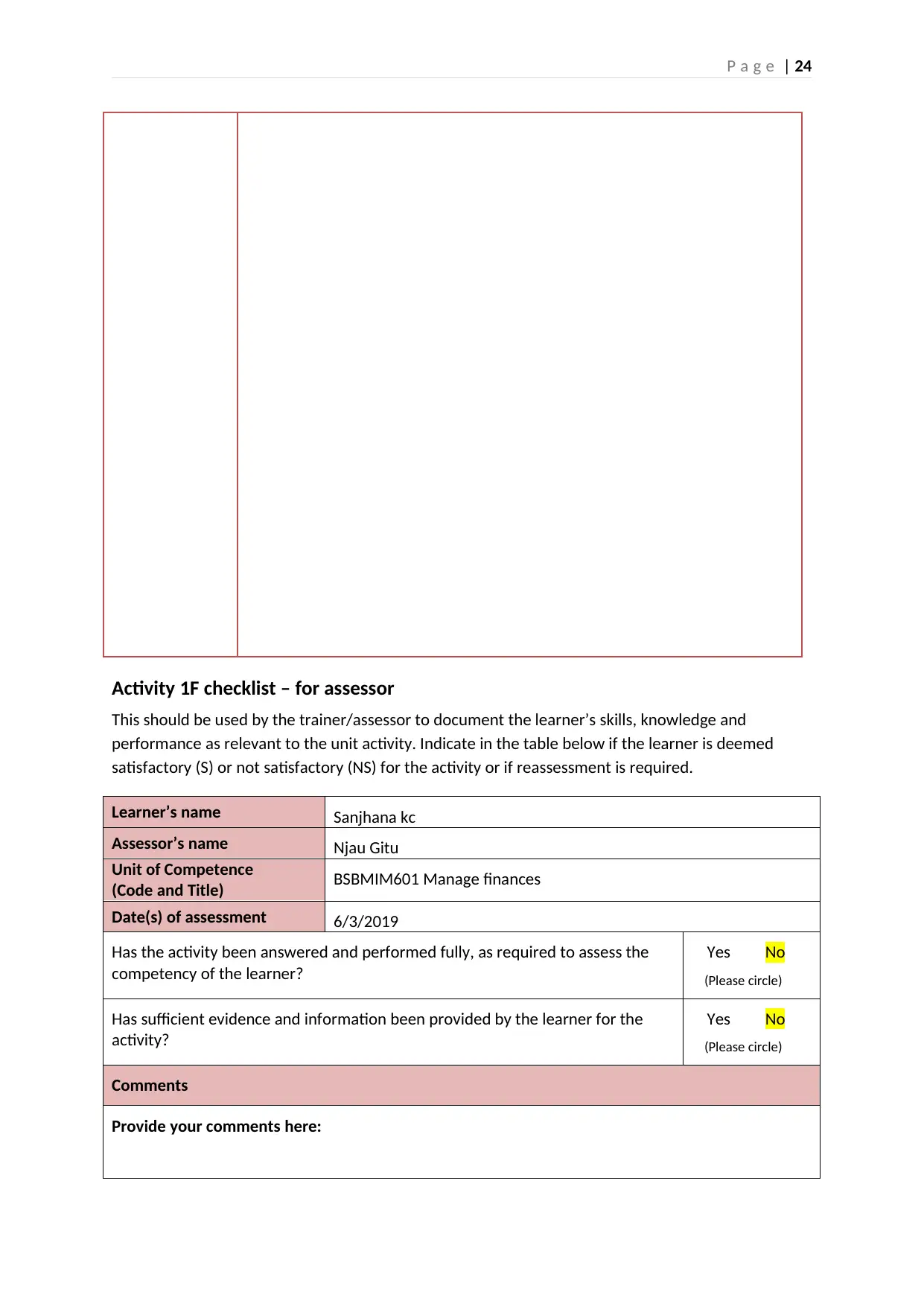
P a g e | 24
Activity 1F checklist – for assessor
This should be used by the trainer/assessor to document the learner’s skills, knowledge and
performance as relevant to the unit activity. Indicate in the table below if the learner is deemed
satisfactory (S) or not satisfactory (NS) for the activity or if reassessment is required.
Learner’s name Sanjhana kc
Assessor’s name Njau Gitu
Unit of Competence
(Code and Title) BSBMIM601 Manage finances
Date(s) of assessment 6/3/2019
Has the activity been answered and performed fully, as required to assess the
competency of the learner?
Yes No
(Please circle)
Has sufficient evidence and information been provided by the learner for the
activity?
Yes No
(Please circle)
Comments
Provide your comments here:
Activity 1F checklist – for assessor
This should be used by the trainer/assessor to document the learner’s skills, knowledge and
performance as relevant to the unit activity. Indicate in the table below if the learner is deemed
satisfactory (S) or not satisfactory (NS) for the activity or if reassessment is required.
Learner’s name Sanjhana kc
Assessor’s name Njau Gitu
Unit of Competence
(Code and Title) BSBMIM601 Manage finances
Date(s) of assessment 6/3/2019
Has the activity been answered and performed fully, as required to assess the
competency of the learner?
Yes No
(Please circle)
Has sufficient evidence and information been provided by the learner for the
activity?
Yes No
(Please circle)
Comments
Provide your comments here:
Paraphrase This Document
Need a fresh take? Get an instant paraphrase of this document with our AI Paraphraser
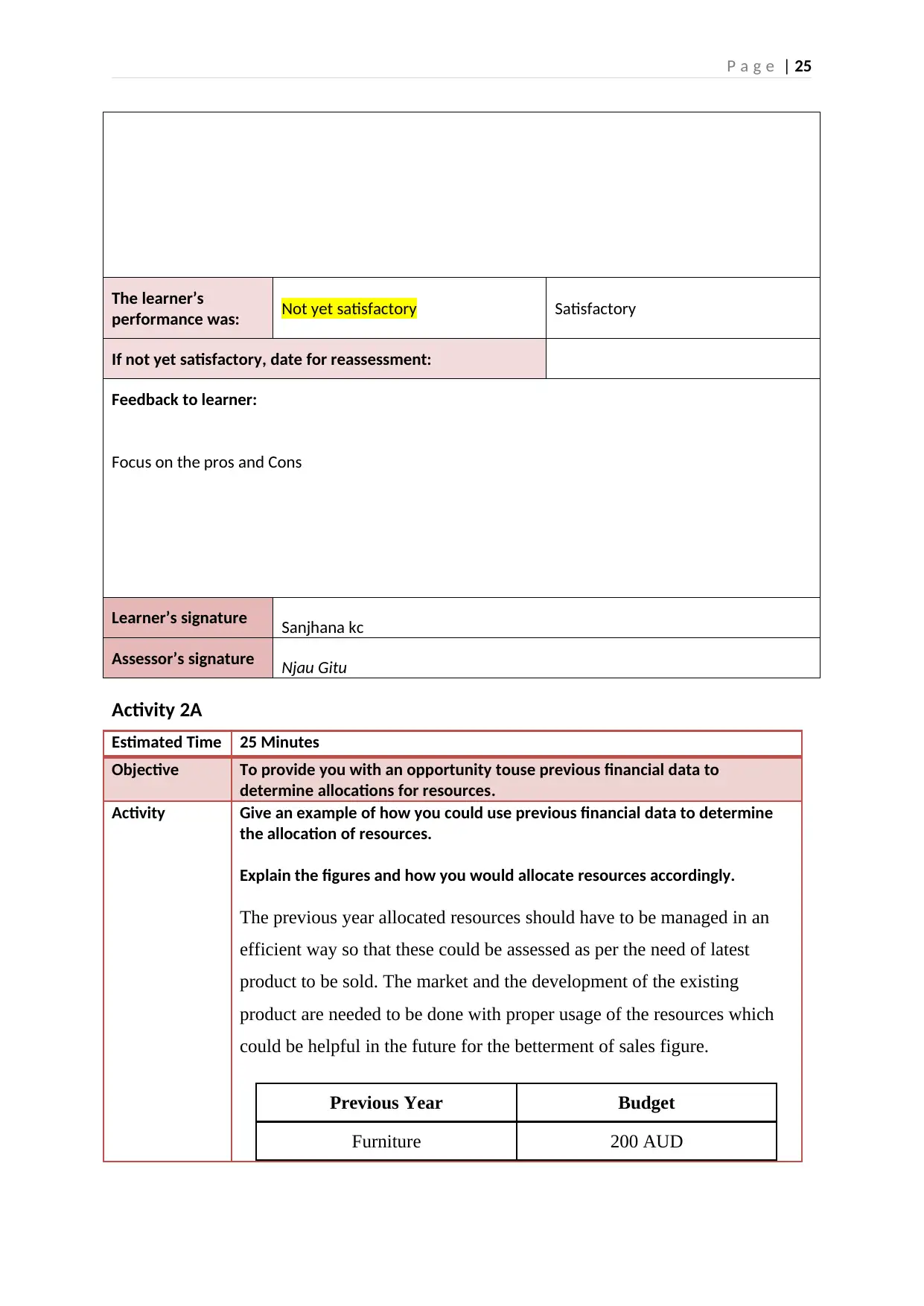
P a g e | 25
The learner’s
performance was: Not yet satisfactory Satisfactory
If not yet satisfactory, date for reassessment:
Feedback to learner:
Focus on the pros and Cons
Learner’s signature Sanjhana kc
Assessor’s signature Njau Gitu
Activity 2A
Estimated Time 25 Minutes
Objective To provide you with an opportunity touse previous financial data to
determine allocations for resources.
Activity Give an example of how you could use previous financial data to determine
the allocation of resources.
Explain the figures and how you would allocate resources accordingly.
The previous year allocated resources should have to be managed in an
efficient way so that these could be assessed as per the need of latest
product to be sold. The market and the development of the existing
product are needed to be done with proper usage of the resources which
could be helpful in the future for the betterment of sales figure.
Previous Year Budget
Furniture 200 AUD
The learner’s
performance was: Not yet satisfactory Satisfactory
If not yet satisfactory, date for reassessment:
Feedback to learner:
Focus on the pros and Cons
Learner’s signature Sanjhana kc
Assessor’s signature Njau Gitu
Activity 2A
Estimated Time 25 Minutes
Objective To provide you with an opportunity touse previous financial data to
determine allocations for resources.
Activity Give an example of how you could use previous financial data to determine
the allocation of resources.
Explain the figures and how you would allocate resources accordingly.
The previous year allocated resources should have to be managed in an
efficient way so that these could be assessed as per the need of latest
product to be sold. The market and the development of the existing
product are needed to be done with proper usage of the resources which
could be helpful in the future for the betterment of sales figure.
Previous Year Budget
Furniture 200 AUD
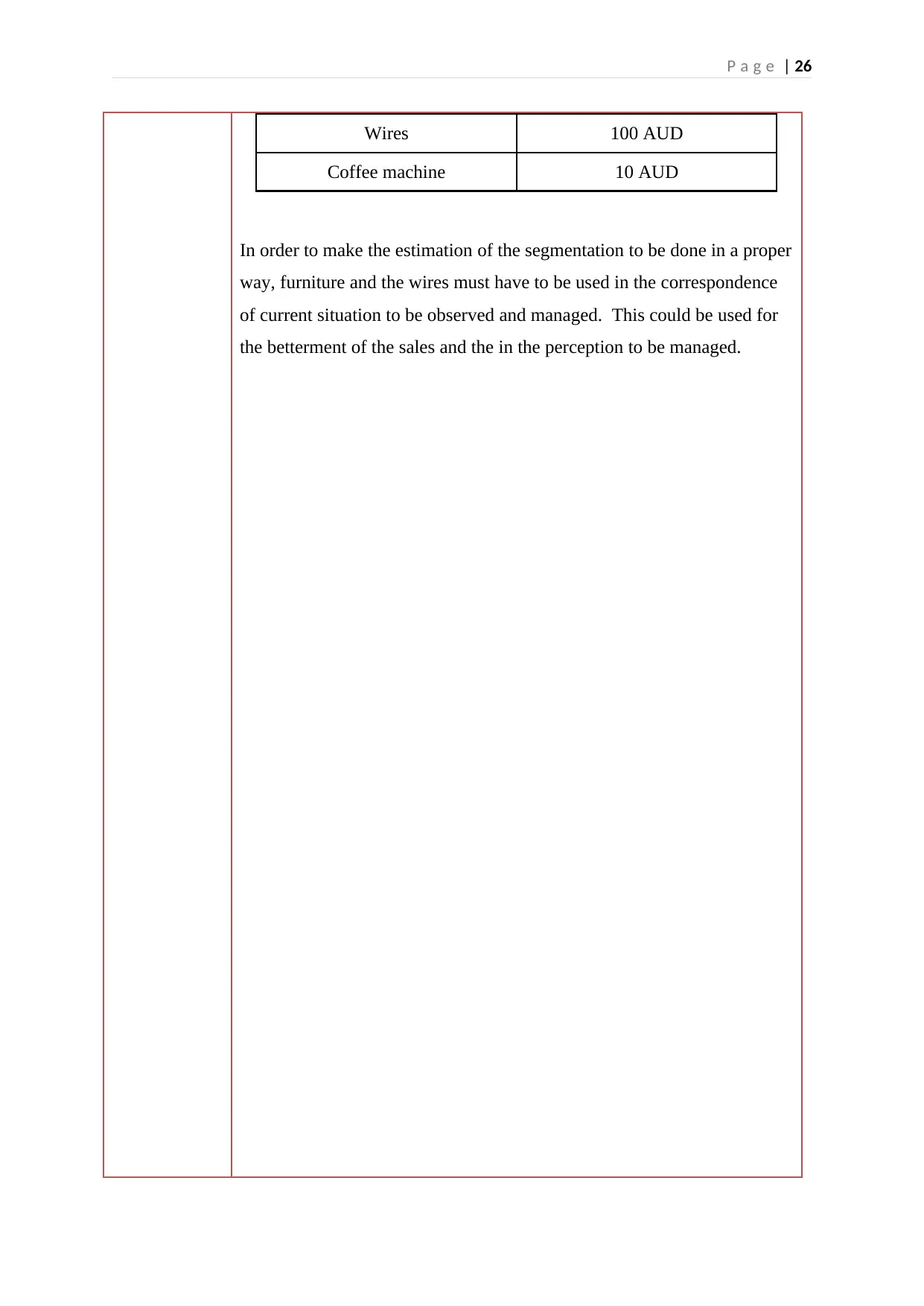
P a g e | 26
Wires 100 AUD
Coffee machine 10 AUD
In order to make the estimation of the segmentation to be done in a proper
way, furniture and the wires must have to be used in the correspondence
of current situation to be observed and managed. This could be used for
the betterment of the sales and the in the perception to be managed.
Wires 100 AUD
Coffee machine 10 AUD
In order to make the estimation of the segmentation to be done in a proper
way, furniture and the wires must have to be used in the correspondence
of current situation to be observed and managed. This could be used for
the betterment of the sales and the in the perception to be managed.
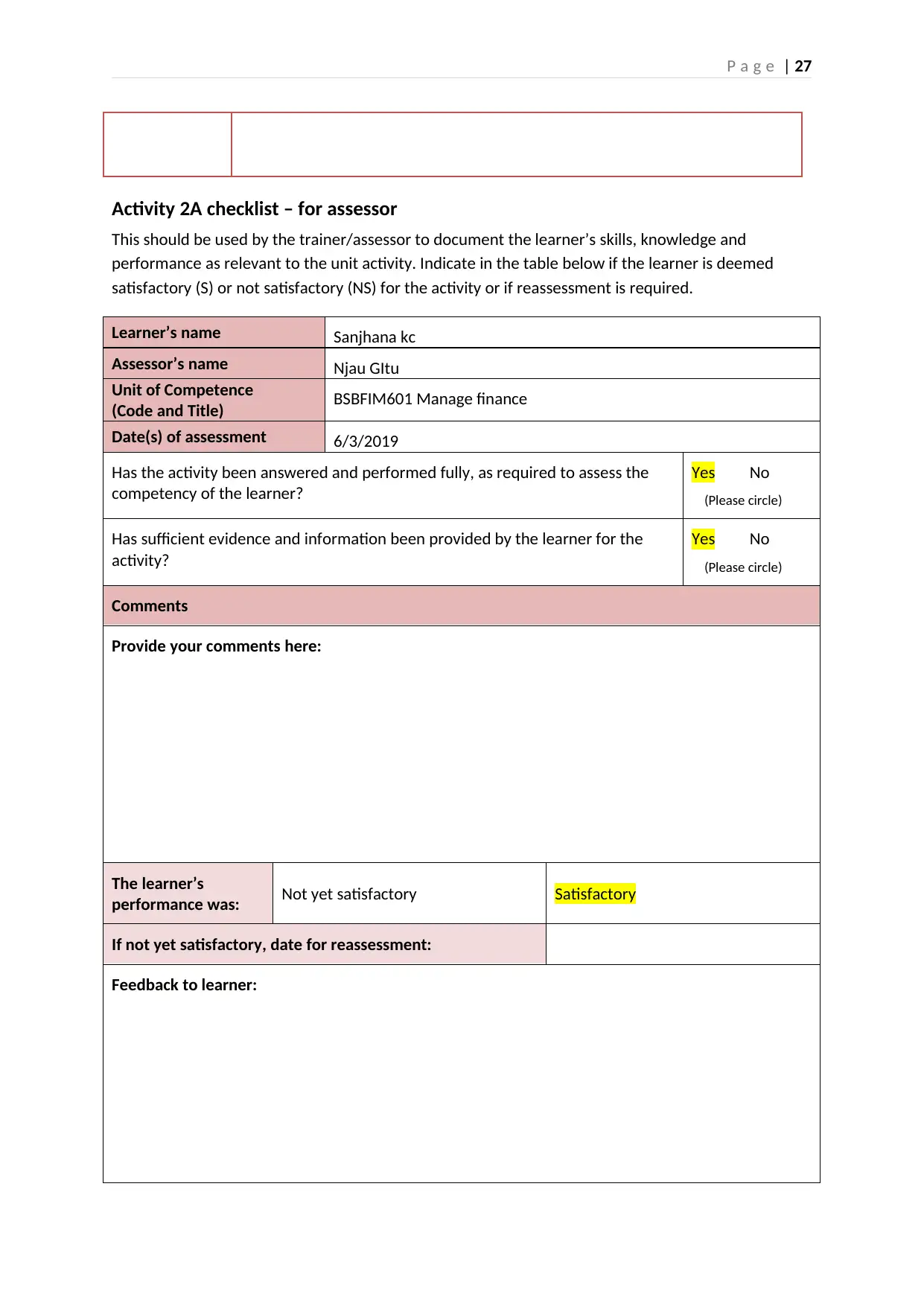
P a g e | 27
Activity 2A checklist – for assessor
This should be used by the trainer/assessor to document the learner’s skills, knowledge and
performance as relevant to the unit activity. Indicate in the table below if the learner is deemed
satisfactory (S) or not satisfactory (NS) for the activity or if reassessment is required.
Learner’s name Sanjhana kc
Assessor’s name Njau GItu
Unit of Competence
(Code and Title) BSBFIM601 Manage finance
Date(s) of assessment 6/3/2019
Has the activity been answered and performed fully, as required to assess the
competency of the learner?
Yes No
(Please circle)
Has sufficient evidence and information been provided by the learner for the
activity?
Yes No
(Please circle)
Comments
Provide your comments here:
The learner’s
performance was: Not yet satisfactory Satisfactory
If not yet satisfactory, date for reassessment:
Feedback to learner:
Activity 2A checklist – for assessor
This should be used by the trainer/assessor to document the learner’s skills, knowledge and
performance as relevant to the unit activity. Indicate in the table below if the learner is deemed
satisfactory (S) or not satisfactory (NS) for the activity or if reassessment is required.
Learner’s name Sanjhana kc
Assessor’s name Njau GItu
Unit of Competence
(Code and Title) BSBFIM601 Manage finance
Date(s) of assessment 6/3/2019
Has the activity been answered and performed fully, as required to assess the
competency of the learner?
Yes No
(Please circle)
Has sufficient evidence and information been provided by the learner for the
activity?
Yes No
(Please circle)
Comments
Provide your comments here:
The learner’s
performance was: Not yet satisfactory Satisfactory
If not yet satisfactory, date for reassessment:
Feedback to learner:
Secure Best Marks with AI Grader
Need help grading? Try our AI Grader for instant feedback on your assignments.
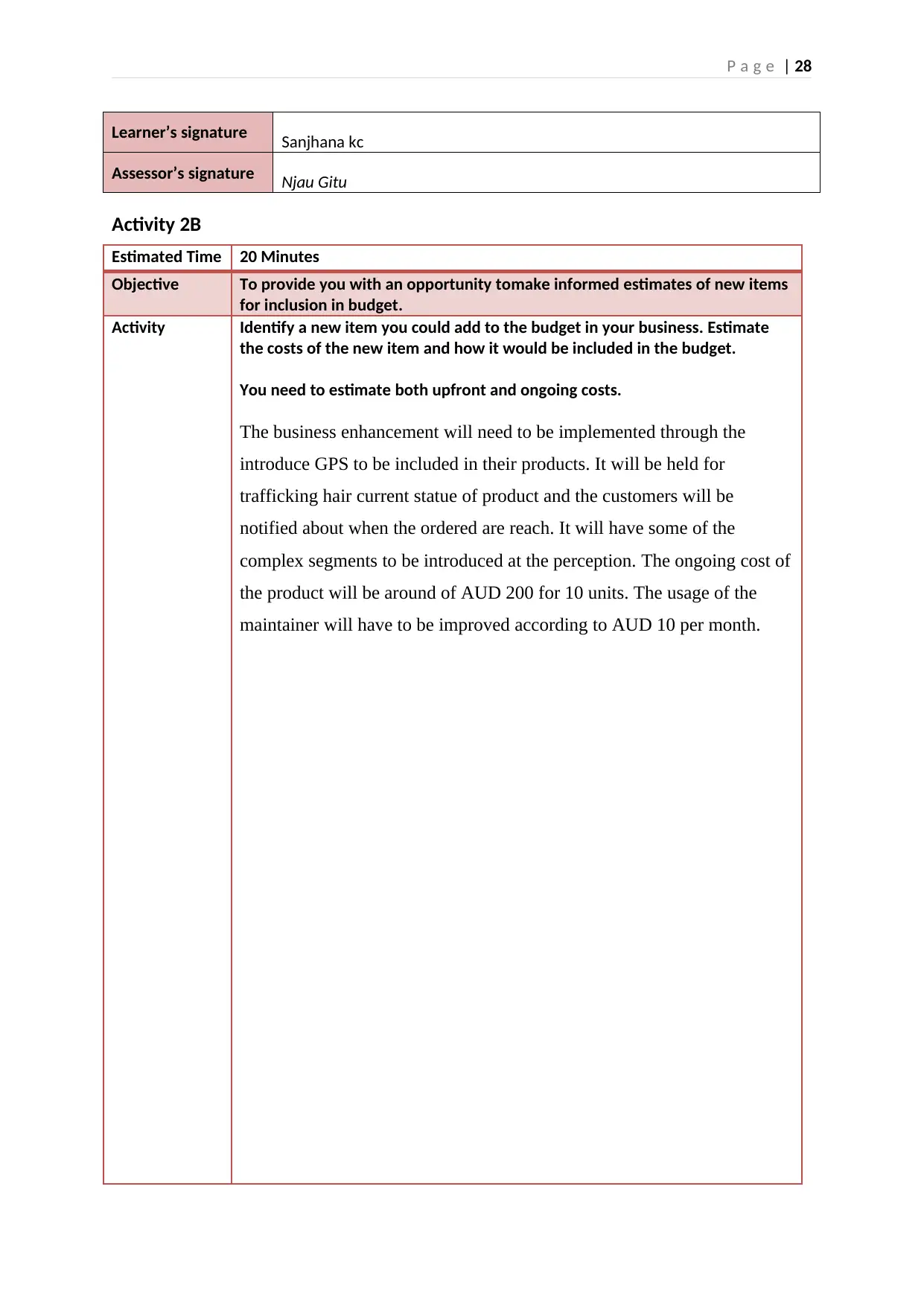
P a g e | 28
Learner’s signature Sanjhana kc
Assessor’s signature Njau Gitu
Activity 2B
Estimated Time 20 Minutes
Objective To provide you with an opportunity tomake informed estimates of new items
for inclusion in budget.
Activity Identify a new item you could add to the budget in your business. Estimate
the costs of the new item and how it would be included in the budget.
You need to estimate both upfront and ongoing costs.
The business enhancement will need to be implemented through the
introduce GPS to be included in their products. It will be held for
trafficking hair current statue of product and the customers will be
notified about when the ordered are reach. It will have some of the
complex segments to be introduced at the perception. The ongoing cost of
the product will be around of AUD 200 for 10 units. The usage of the
maintainer will have to be improved according to AUD 10 per month.
Learner’s signature Sanjhana kc
Assessor’s signature Njau Gitu
Activity 2B
Estimated Time 20 Minutes
Objective To provide you with an opportunity tomake informed estimates of new items
for inclusion in budget.
Activity Identify a new item you could add to the budget in your business. Estimate
the costs of the new item and how it would be included in the budget.
You need to estimate both upfront and ongoing costs.
The business enhancement will need to be implemented through the
introduce GPS to be included in their products. It will be held for
trafficking hair current statue of product and the customers will be
notified about when the ordered are reach. It will have some of the
complex segments to be introduced at the perception. The ongoing cost of
the product will be around of AUD 200 for 10 units. The usage of the
maintainer will have to be improved according to AUD 10 per month.
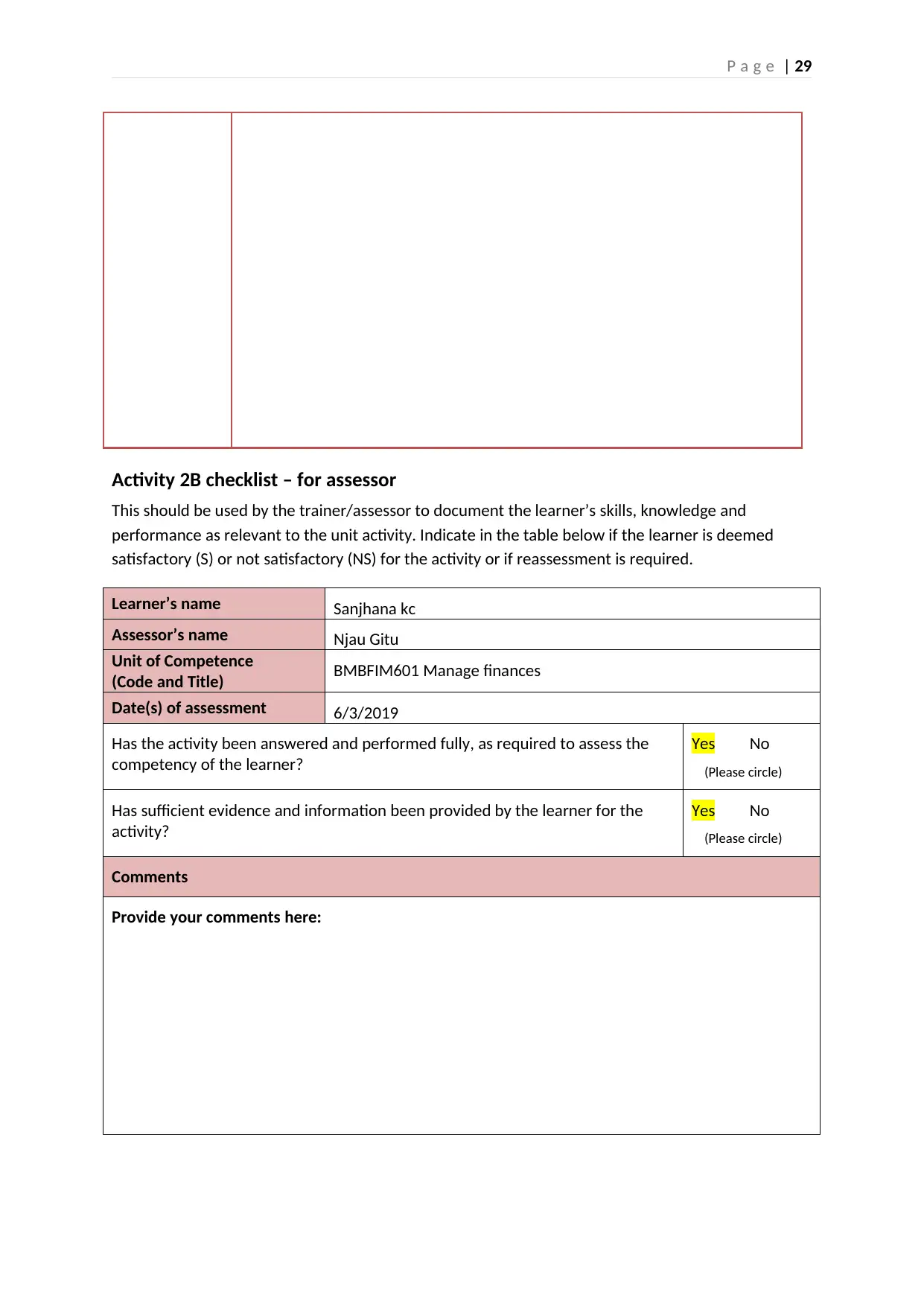
P a g e | 29
Activity 2B checklist – for assessor
This should be used by the trainer/assessor to document the learner’s skills, knowledge and
performance as relevant to the unit activity. Indicate in the table below if the learner is deemed
satisfactory (S) or not satisfactory (NS) for the activity or if reassessment is required.
Learner’s name Sanjhana kc
Assessor’s name Njau Gitu
Unit of Competence
(Code and Title) BMBFIM601 Manage finances
Date(s) of assessment 6/3/2019
Has the activity been answered and performed fully, as required to assess the
competency of the learner?
Yes No
(Please circle)
Has sufficient evidence and information been provided by the learner for the
activity?
Yes No
(Please circle)
Comments
Provide your comments here:
Activity 2B checklist – for assessor
This should be used by the trainer/assessor to document the learner’s skills, knowledge and
performance as relevant to the unit activity. Indicate in the table below if the learner is deemed
satisfactory (S) or not satisfactory (NS) for the activity or if reassessment is required.
Learner’s name Sanjhana kc
Assessor’s name Njau Gitu
Unit of Competence
(Code and Title) BMBFIM601 Manage finances
Date(s) of assessment 6/3/2019
Has the activity been answered and performed fully, as required to assess the
competency of the learner?
Yes No
(Please circle)
Has sufficient evidence and information been provided by the learner for the
activity?
Yes No
(Please circle)
Comments
Provide your comments here:
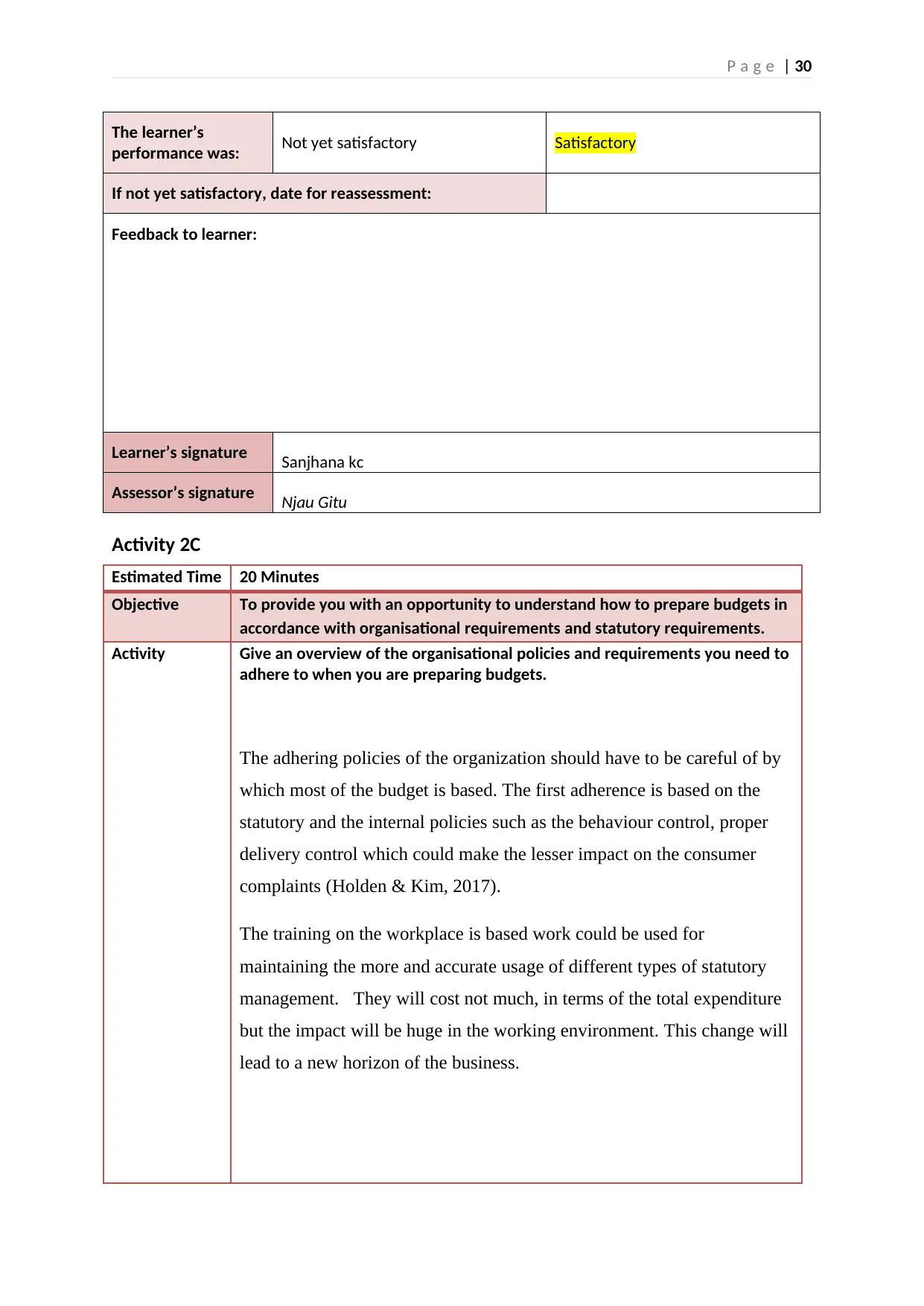
P a g e | 30
The learner’s
performance was: Not yet satisfactory Satisfactory
If not yet satisfactory, date for reassessment:
Feedback to learner:
Learner’s signature Sanjhana kc
Assessor’s signature Njau Gitu
Activity 2C
Estimated Time 20 Minutes
Objective To provide you with an opportunity to understand how to prepare budgets in
accordance with organisational requirements and statutory requirements.
Activity Give an overview of the organisational policies and requirements you need to
adhere to when you are preparing budgets.
The adhering policies of the organization should have to be careful of by
which most of the budget is based. The first adherence is based on the
statutory and the internal policies such as the behaviour control, proper
delivery control which could make the lesser impact on the consumer
complaints (Holden & Kim, 2017).
The training on the workplace is based work could be used for
maintaining the more and accurate usage of different types of statutory
management. They will cost not much, in terms of the total expenditure
but the impact will be huge in the working environment. This change will
lead to a new horizon of the business.
The learner’s
performance was: Not yet satisfactory Satisfactory
If not yet satisfactory, date for reassessment:
Feedback to learner:
Learner’s signature Sanjhana kc
Assessor’s signature Njau Gitu
Activity 2C
Estimated Time 20 Minutes
Objective To provide you with an opportunity to understand how to prepare budgets in
accordance with organisational requirements and statutory requirements.
Activity Give an overview of the organisational policies and requirements you need to
adhere to when you are preparing budgets.
The adhering policies of the organization should have to be careful of by
which most of the budget is based. The first adherence is based on the
statutory and the internal policies such as the behaviour control, proper
delivery control which could make the lesser impact on the consumer
complaints (Holden & Kim, 2017).
The training on the workplace is based work could be used for
maintaining the more and accurate usage of different types of statutory
management. They will cost not much, in terms of the total expenditure
but the impact will be huge in the working environment. This change will
lead to a new horizon of the business.
Paraphrase This Document
Need a fresh take? Get an instant paraphrase of this document with our AI Paraphraser

P a g e | 31
Activity 2C checklist – for assessor
This should be used by the trainer/assessor to document the learner’s skills, knowledge and
performance as relevant to the unit activity. Indicate in the table below if the learner is deemed
satisfactory (S) or not satisfactory (NS) for the activity or if reassessment is required.
Learner’s name Sanjhana kc
Assessor’s name Njau Gitu
Unit of Competence
(Code and Title) BSBFIM601 Manage finances
Date(s) of assessment 6/3/2019
Activity 2C checklist – for assessor
This should be used by the trainer/assessor to document the learner’s skills, knowledge and
performance as relevant to the unit activity. Indicate in the table below if the learner is deemed
satisfactory (S) or not satisfactory (NS) for the activity or if reassessment is required.
Learner’s name Sanjhana kc
Assessor’s name Njau Gitu
Unit of Competence
(Code and Title) BSBFIM601 Manage finances
Date(s) of assessment 6/3/2019
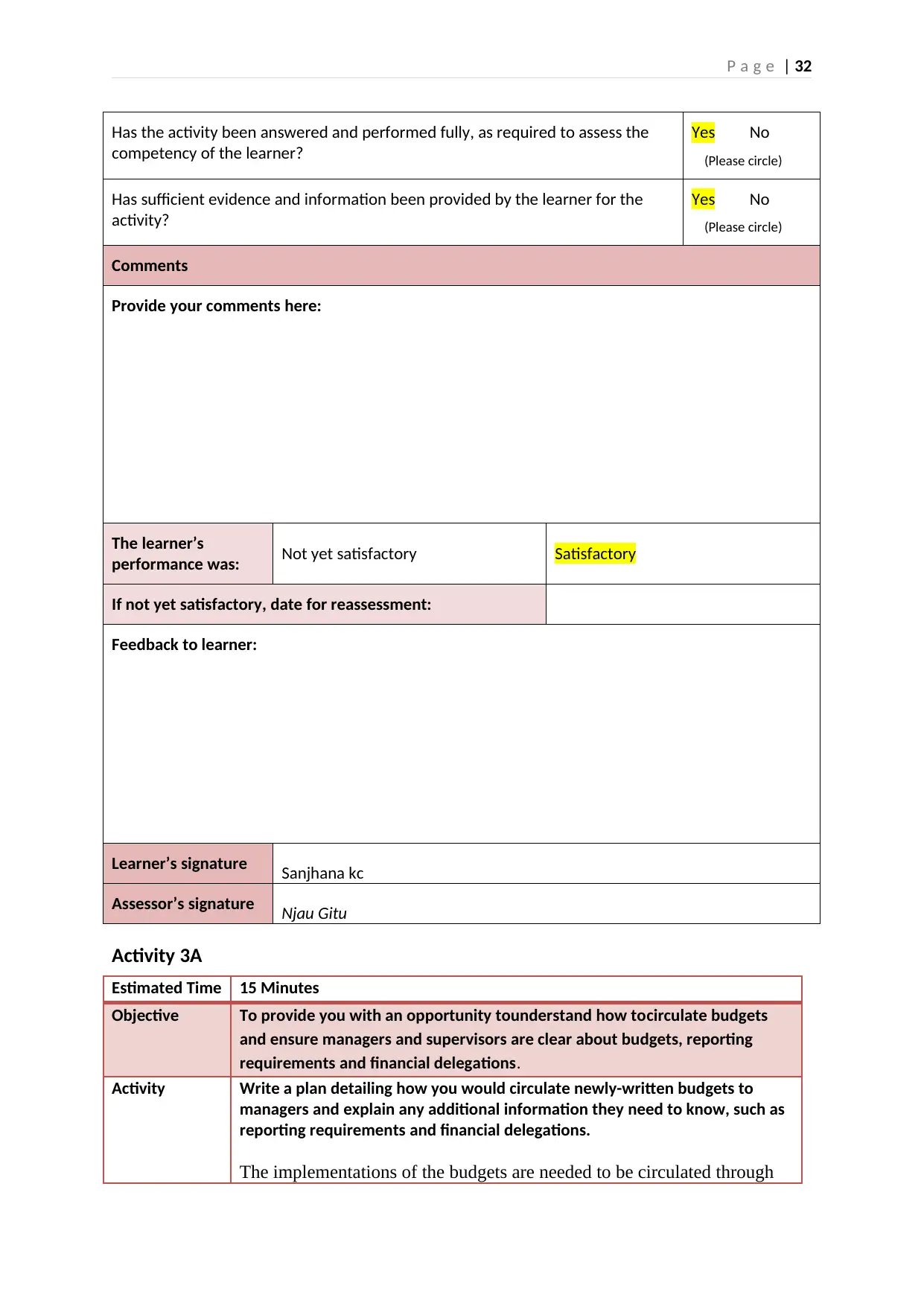
P a g e | 32
Has the activity been answered and performed fully, as required to assess the
competency of the learner?
Yes No
(Please circle)
Has sufficient evidence and information been provided by the learner for the
activity?
Yes No
(Please circle)
Comments
Provide your comments here:
The learner’s
performance was: Not yet satisfactory Satisfactory
If not yet satisfactory, date for reassessment:
Feedback to learner:
Learner’s signature Sanjhana kc
Assessor’s signature Njau Gitu
Activity 3A
Estimated Time 15 Minutes
Objective To provide you with an opportunity tounderstand how tocirculate budgets
and ensure managers and supervisors are clear about budgets, reporting
requirements and financial delegations.
Activity Write a plan detailing how you would circulate newly-written budgets to
managers and explain any additional information they need to know, such as
reporting requirements and financial delegations.
The implementations of the budgets are needed to be circulated through
Has the activity been answered and performed fully, as required to assess the
competency of the learner?
Yes No
(Please circle)
Has sufficient evidence and information been provided by the learner for the
activity?
Yes No
(Please circle)
Comments
Provide your comments here:
The learner’s
performance was: Not yet satisfactory Satisfactory
If not yet satisfactory, date for reassessment:
Feedback to learner:
Learner’s signature Sanjhana kc
Assessor’s signature Njau Gitu
Activity 3A
Estimated Time 15 Minutes
Objective To provide you with an opportunity tounderstand how tocirculate budgets
and ensure managers and supervisors are clear about budgets, reporting
requirements and financial delegations.
Activity Write a plan detailing how you would circulate newly-written budgets to
managers and explain any additional information they need to know, such as
reporting requirements and financial delegations.
The implementations of the budgets are needed to be circulated through
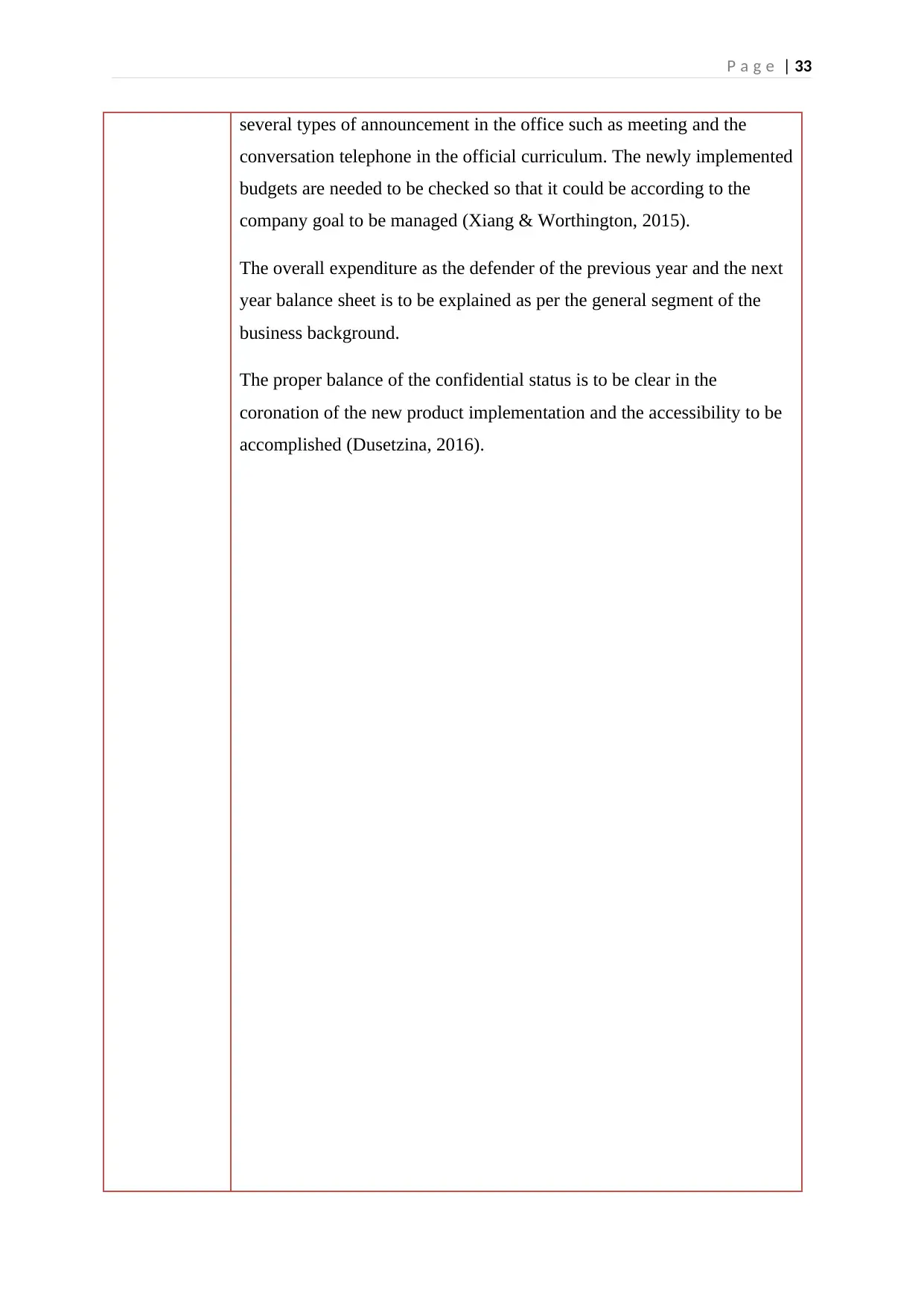
P a g e | 33
several types of announcement in the office such as meeting and the
conversation telephone in the official curriculum. The newly implemented
budgets are needed to be checked so that it could be according to the
company goal to be managed (Xiang & Worthington, 2015).
The overall expenditure as the defender of the previous year and the next
year balance sheet is to be explained as per the general segment of the
business background.
The proper balance of the confidential status is to be clear in the
coronation of the new product implementation and the accessibility to be
accomplished (Dusetzina, 2016).
several types of announcement in the office such as meeting and the
conversation telephone in the official curriculum. The newly implemented
budgets are needed to be checked so that it could be according to the
company goal to be managed (Xiang & Worthington, 2015).
The overall expenditure as the defender of the previous year and the next
year balance sheet is to be explained as per the general segment of the
business background.
The proper balance of the confidential status is to be clear in the
coronation of the new product implementation and the accessibility to be
accomplished (Dusetzina, 2016).
Secure Best Marks with AI Grader
Need help grading? Try our AI Grader for instant feedback on your assignments.
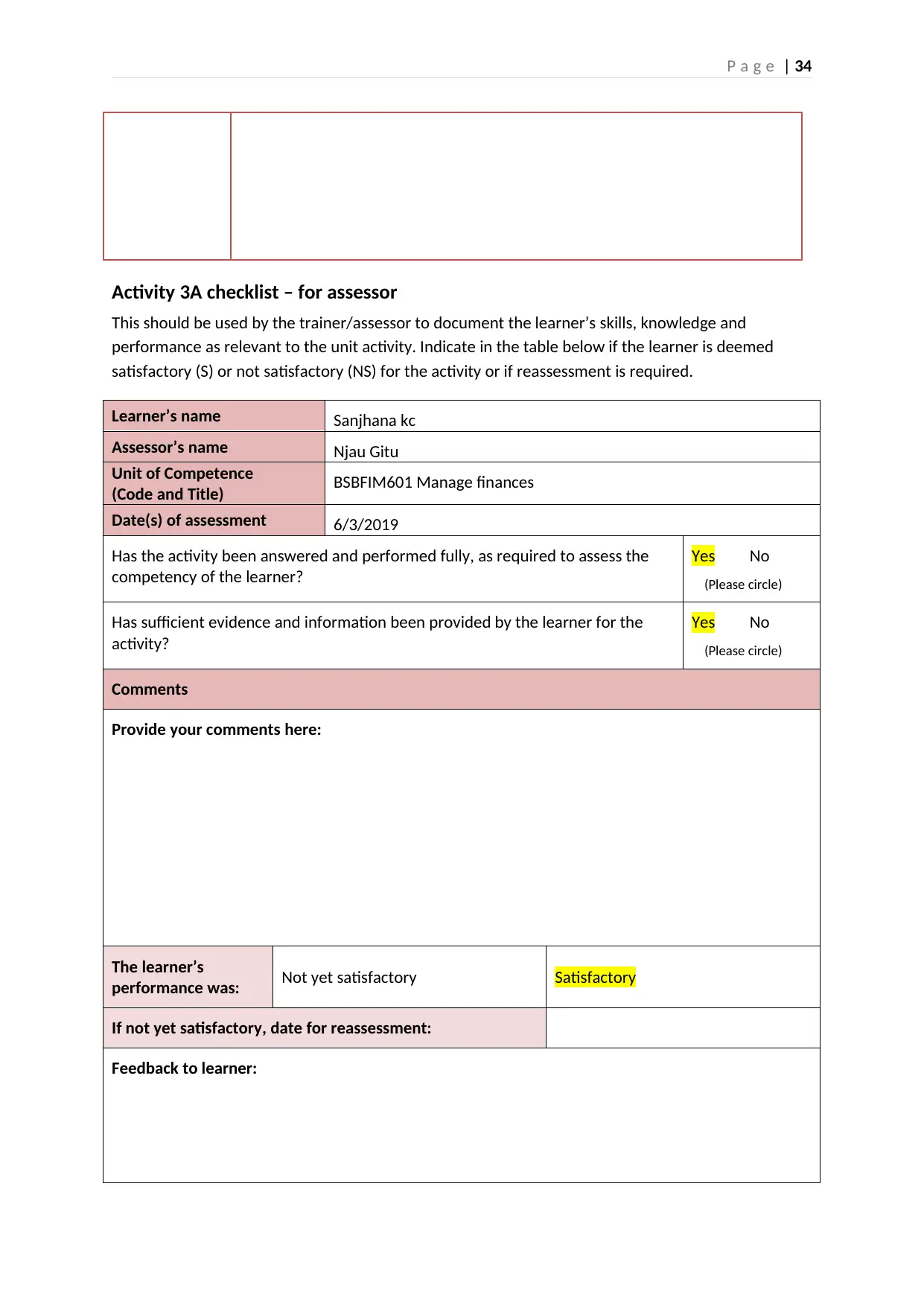
P a g e | 34
Activity 3A checklist – for assessor
This should be used by the trainer/assessor to document the learner’s skills, knowledge and
performance as relevant to the unit activity. Indicate in the table below if the learner is deemed
satisfactory (S) or not satisfactory (NS) for the activity or if reassessment is required.
Learner’s name Sanjhana kc
Assessor’s name Njau Gitu
Unit of Competence
(Code and Title) BSBFIM601 Manage finances
Date(s) of assessment 6/3/2019
Has the activity been answered and performed fully, as required to assess the
competency of the learner?
Yes No
(Please circle)
Has sufficient evidence and information been provided by the learner for the
activity?
Yes No
(Please circle)
Comments
Provide your comments here:
The learner’s
performance was: Not yet satisfactory Satisfactory
If not yet satisfactory, date for reassessment:
Feedback to learner:
Activity 3A checklist – for assessor
This should be used by the trainer/assessor to document the learner’s skills, knowledge and
performance as relevant to the unit activity. Indicate in the table below if the learner is deemed
satisfactory (S) or not satisfactory (NS) for the activity or if reassessment is required.
Learner’s name Sanjhana kc
Assessor’s name Njau Gitu
Unit of Competence
(Code and Title) BSBFIM601 Manage finances
Date(s) of assessment 6/3/2019
Has the activity been answered and performed fully, as required to assess the
competency of the learner?
Yes No
(Please circle)
Has sufficient evidence and information been provided by the learner for the
activity?
Yes No
(Please circle)
Comments
Provide your comments here:
The learner’s
performance was: Not yet satisfactory Satisfactory
If not yet satisfactory, date for reassessment:
Feedback to learner:
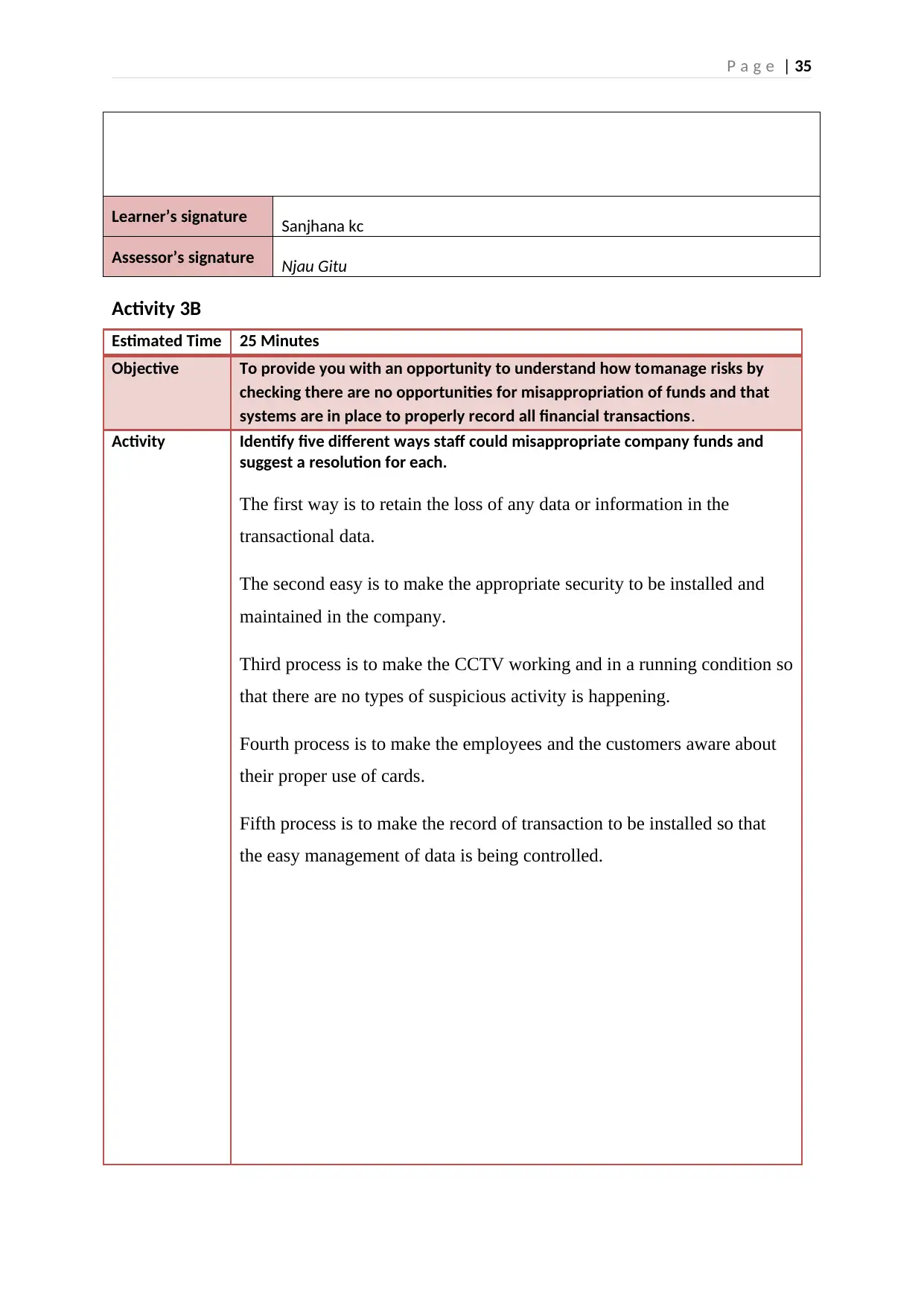
P a g e | 35
Learner’s signature Sanjhana kc
Assessor’s signature Njau Gitu
Activity 3B
Estimated Time 25 Minutes
Objective To provide you with an opportunity to understand how tomanage risks by
checking there are no opportunities for misappropriation of funds and that
systems are in place to properly record all financial transactions.
Activity Identify five different ways staff could misappropriate company funds and
suggest a resolution for each.
The first way is to retain the loss of any data or information in the
transactional data.
The second easy is to make the appropriate security to be installed and
maintained in the company.
Third process is to make the CCTV working and in a running condition so
that there are no types of suspicious activity is happening.
Fourth process is to make the employees and the customers aware about
their proper use of cards.
Fifth process is to make the record of transaction to be installed so that
the easy management of data is being controlled.
Learner’s signature Sanjhana kc
Assessor’s signature Njau Gitu
Activity 3B
Estimated Time 25 Minutes
Objective To provide you with an opportunity to understand how tomanage risks by
checking there are no opportunities for misappropriation of funds and that
systems are in place to properly record all financial transactions.
Activity Identify five different ways staff could misappropriate company funds and
suggest a resolution for each.
The first way is to retain the loss of any data or information in the
transactional data.
The second easy is to make the appropriate security to be installed and
maintained in the company.
Third process is to make the CCTV working and in a running condition so
that there are no types of suspicious activity is happening.
Fourth process is to make the employees and the customers aware about
their proper use of cards.
Fifth process is to make the record of transaction to be installed so that
the easy management of data is being controlled.
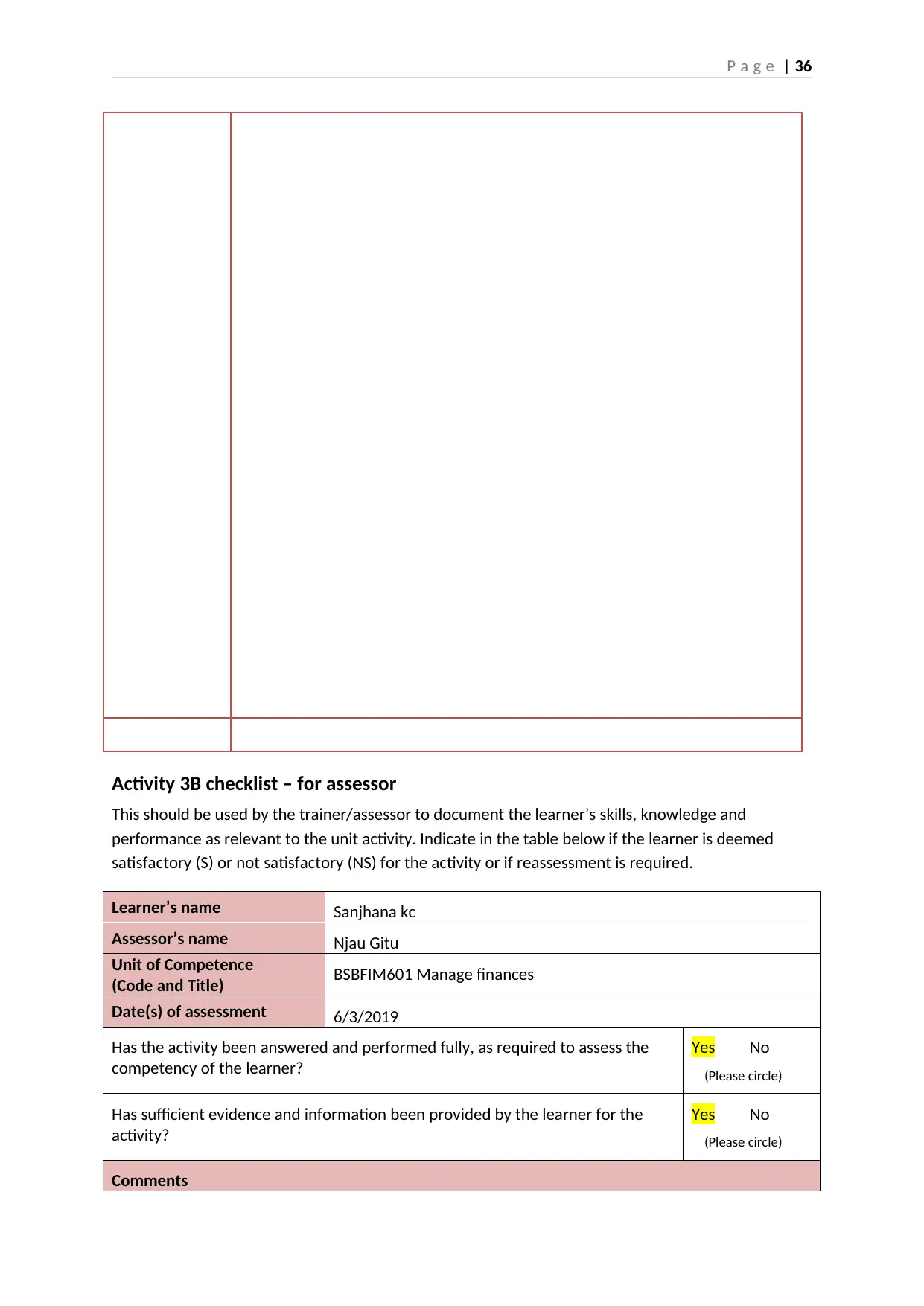
P a g e | 36
Activity 3B checklist – for assessor
This should be used by the trainer/assessor to document the learner’s skills, knowledge and
performance as relevant to the unit activity. Indicate in the table below if the learner is deemed
satisfactory (S) or not satisfactory (NS) for the activity or if reassessment is required.
Learner’s name Sanjhana kc
Assessor’s name Njau Gitu
Unit of Competence
(Code and Title) BSBFIM601 Manage finances
Date(s) of assessment 6/3/2019
Has the activity been answered and performed fully, as required to assess the
competency of the learner?
Yes No
(Please circle)
Has sufficient evidence and information been provided by the learner for the
activity?
Yes No
(Please circle)
Comments
Activity 3B checklist – for assessor
This should be used by the trainer/assessor to document the learner’s skills, knowledge and
performance as relevant to the unit activity. Indicate in the table below if the learner is deemed
satisfactory (S) or not satisfactory (NS) for the activity or if reassessment is required.
Learner’s name Sanjhana kc
Assessor’s name Njau Gitu
Unit of Competence
(Code and Title) BSBFIM601 Manage finances
Date(s) of assessment 6/3/2019
Has the activity been answered and performed fully, as required to assess the
competency of the learner?
Yes No
(Please circle)
Has sufficient evidence and information been provided by the learner for the
activity?
Yes No
(Please circle)
Comments
Paraphrase This Document
Need a fresh take? Get an instant paraphrase of this document with our AI Paraphraser
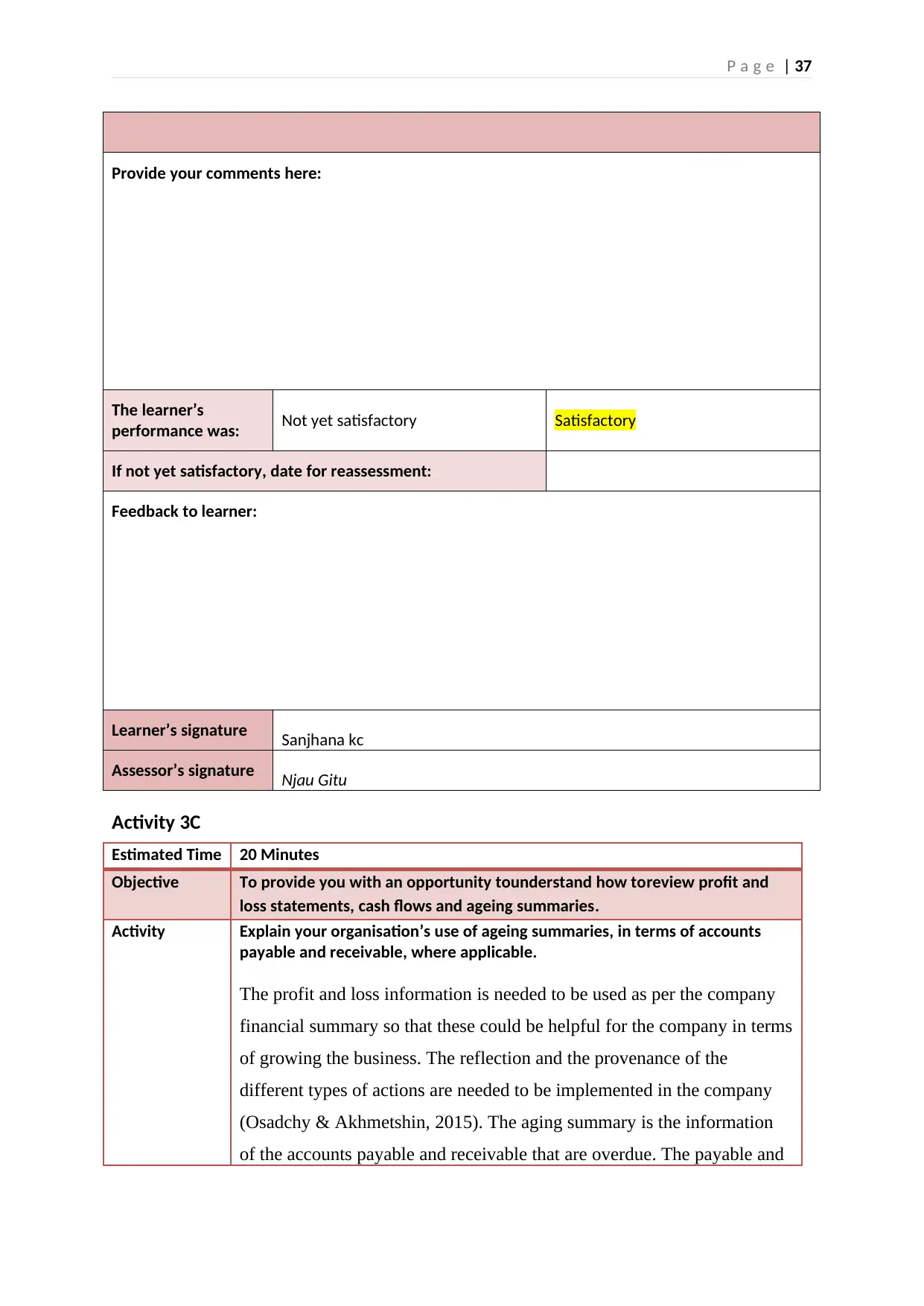
P a g e | 37
Provide your comments here:
The learner’s
performance was: Not yet satisfactory Satisfactory
If not yet satisfactory, date for reassessment:
Feedback to learner:
Learner’s signature Sanjhana kc
Assessor’s signature Njau Gitu
Activity 3C
Estimated Time 20 Minutes
Objective To provide you with an opportunity tounderstand how toreview profit and
loss statements, cash flows and ageing summaries.
Activity Explain your organisation’s use of ageing summaries, in terms of accounts
payable and receivable, where applicable.
The profit and loss information is needed to be used as per the company
financial summary so that these could be helpful for the company in terms
of growing the business. The reflection and the provenance of the
different types of actions are needed to be implemented in the company
(Osadchy & Akhmetshin, 2015). The aging summary is the information
of the accounts payable and receivable that are overdue. The payable and
Provide your comments here:
The learner’s
performance was: Not yet satisfactory Satisfactory
If not yet satisfactory, date for reassessment:
Feedback to learner:
Learner’s signature Sanjhana kc
Assessor’s signature Njau Gitu
Activity 3C
Estimated Time 20 Minutes
Objective To provide you with an opportunity tounderstand how toreview profit and
loss statements, cash flows and ageing summaries.
Activity Explain your organisation’s use of ageing summaries, in terms of accounts
payable and receivable, where applicable.
The profit and loss information is needed to be used as per the company
financial summary so that these could be helpful for the company in terms
of growing the business. The reflection and the provenance of the
different types of actions are needed to be implemented in the company
(Osadchy & Akhmetshin, 2015). The aging summary is the information
of the accounts payable and receivable that are overdue. The payable and

P a g e | 38
overdue things are needed to be managed which could help in estimating
the future bass of the profits and propagates. According to Angelidou
(2017), the accounts receivable aging report documents all the customer
invoices which are not paid yet whereas the accounts payable aging report
summarises the balances that are owed by the company to other
associated bodies.
overdue things are needed to be managed which could help in estimating
the future bass of the profits and propagates. According to Angelidou
(2017), the accounts receivable aging report documents all the customer
invoices which are not paid yet whereas the accounts payable aging report
summarises the balances that are owed by the company to other
associated bodies.
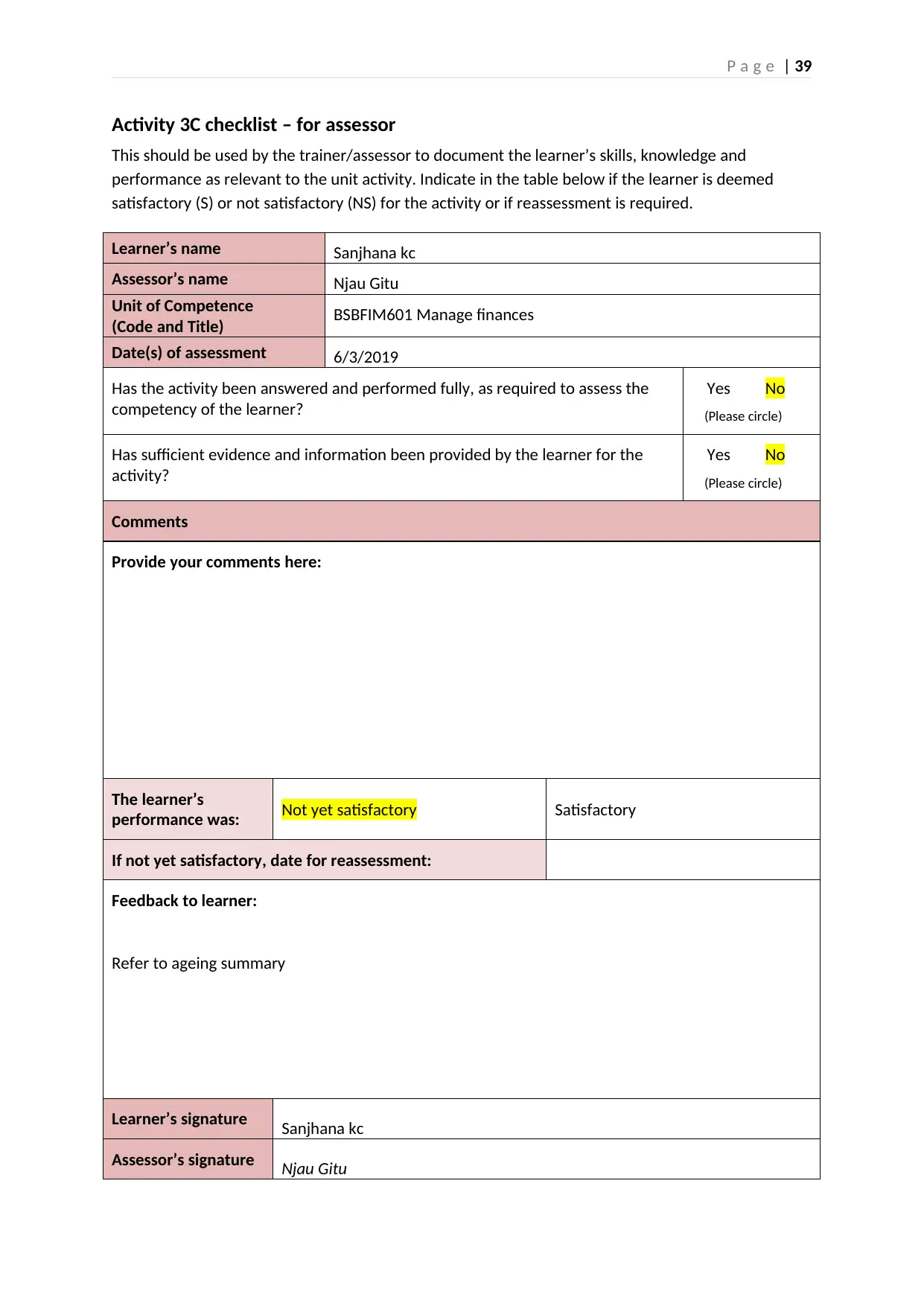
P a g e | 39
Activity 3C checklist – for assessor
This should be used by the trainer/assessor to document the learner’s skills, knowledge and
performance as relevant to the unit activity. Indicate in the table below if the learner is deemed
satisfactory (S) or not satisfactory (NS) for the activity or if reassessment is required.
Learner’s name Sanjhana kc
Assessor’s name Njau Gitu
Unit of Competence
(Code and Title) BSBFIM601 Manage finances
Date(s) of assessment 6/3/2019
Has the activity been answered and performed fully, as required to assess the
competency of the learner?
Yes No
(Please circle)
Has sufficient evidence and information been provided by the learner for the
activity?
Yes No
(Please circle)
Comments
Provide your comments here:
The learner’s
performance was: Not yet satisfactory Satisfactory
If not yet satisfactory, date for reassessment:
Feedback to learner:
Refer to ageing summary
Learner’s signature Sanjhana kc
Assessor’s signature Njau Gitu
Activity 3C checklist – for assessor
This should be used by the trainer/assessor to document the learner’s skills, knowledge and
performance as relevant to the unit activity. Indicate in the table below if the learner is deemed
satisfactory (S) or not satisfactory (NS) for the activity or if reassessment is required.
Learner’s name Sanjhana kc
Assessor’s name Njau Gitu
Unit of Competence
(Code and Title) BSBFIM601 Manage finances
Date(s) of assessment 6/3/2019
Has the activity been answered and performed fully, as required to assess the
competency of the learner?
Yes No
(Please circle)
Has sufficient evidence and information been provided by the learner for the
activity?
Yes No
(Please circle)
Comments
Provide your comments here:
The learner’s
performance was: Not yet satisfactory Satisfactory
If not yet satisfactory, date for reassessment:
Feedback to learner:
Refer to ageing summary
Learner’s signature Sanjhana kc
Assessor’s signature Njau Gitu
Secure Best Marks with AI Grader
Need help grading? Try our AI Grader for instant feedback on your assignments.
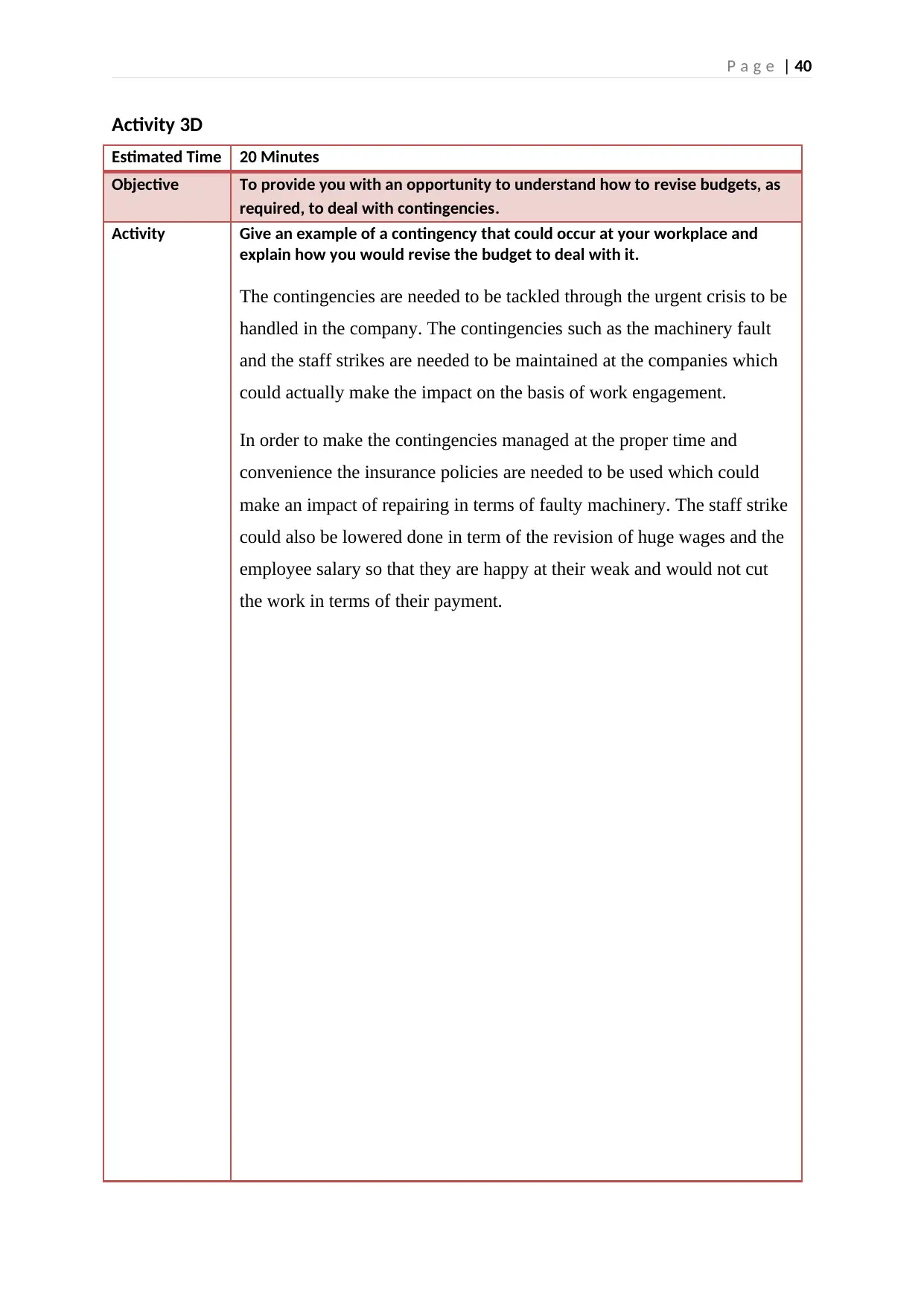
P a g e | 40
Activity 3D
Estimated Time 20 Minutes
Objective To provide you with an opportunity to understand how to revise budgets, as
required, to deal with contingencies.
Activity Give an example of a contingency that could occur at your workplace and
explain how you would revise the budget to deal with it.
The contingencies are needed to be tackled through the urgent crisis to be
handled in the company. The contingencies such as the machinery fault
and the staff strikes are needed to be maintained at the companies which
could actually make the impact on the basis of work engagement.
In order to make the contingencies managed at the proper time and
convenience the insurance policies are needed to be used which could
make an impact of repairing in terms of faulty machinery. The staff strike
could also be lowered done in term of the revision of huge wages and the
employee salary so that they are happy at their weak and would not cut
the work in terms of their payment.
Activity 3D
Estimated Time 20 Minutes
Objective To provide you with an opportunity to understand how to revise budgets, as
required, to deal with contingencies.
Activity Give an example of a contingency that could occur at your workplace and
explain how you would revise the budget to deal with it.
The contingencies are needed to be tackled through the urgent crisis to be
handled in the company. The contingencies such as the machinery fault
and the staff strikes are needed to be maintained at the companies which
could actually make the impact on the basis of work engagement.
In order to make the contingencies managed at the proper time and
convenience the insurance policies are needed to be used which could
make an impact of repairing in terms of faulty machinery. The staff strike
could also be lowered done in term of the revision of huge wages and the
employee salary so that they are happy at their weak and would not cut
the work in terms of their payment.
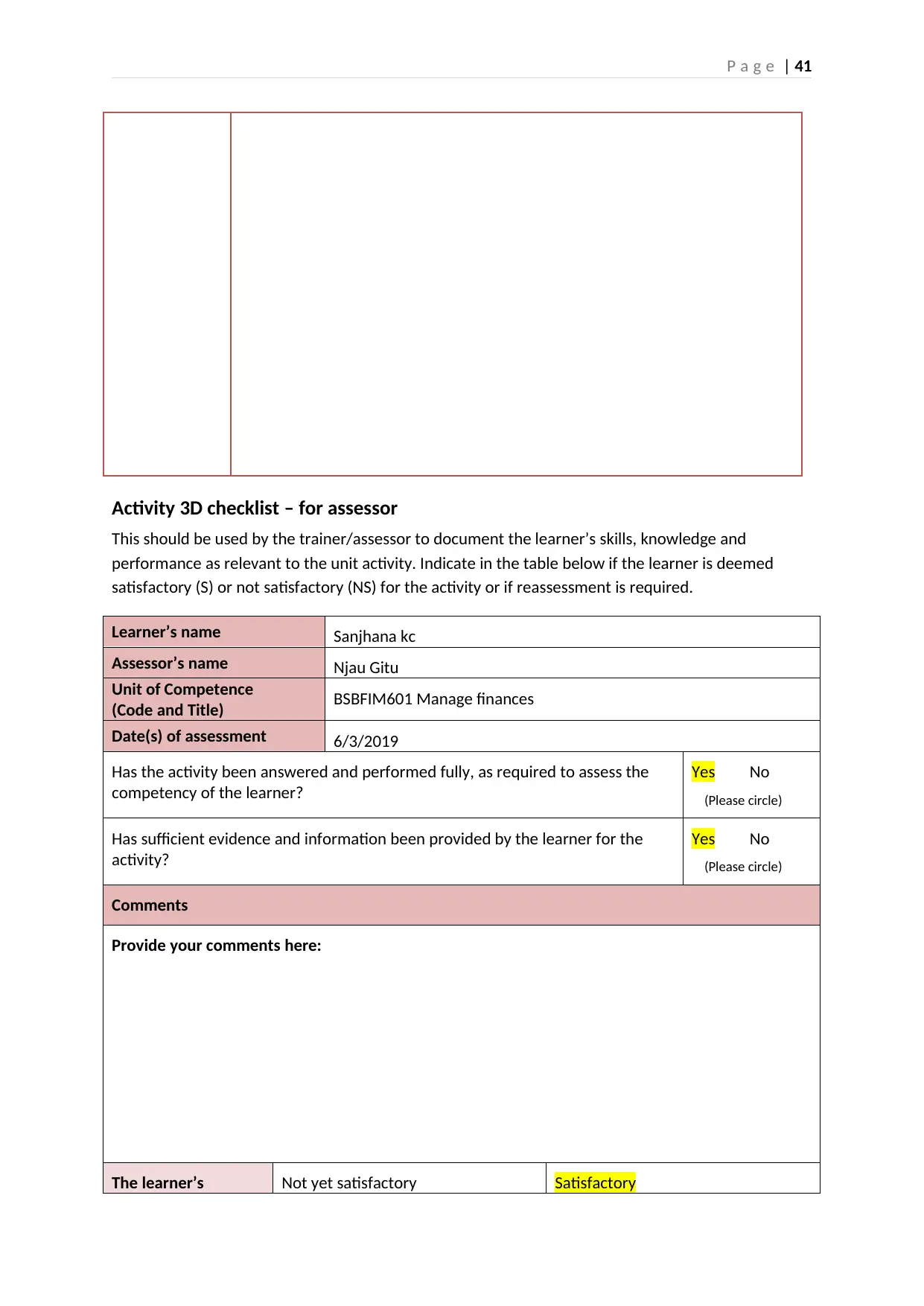
P a g e | 41
Activity 3D checklist – for assessor
This should be used by the trainer/assessor to document the learner’s skills, knowledge and
performance as relevant to the unit activity. Indicate in the table below if the learner is deemed
satisfactory (S) or not satisfactory (NS) for the activity or if reassessment is required.
Learner’s name Sanjhana kc
Assessor’s name Njau Gitu
Unit of Competence
(Code and Title) BSBFIM601 Manage finances
Date(s) of assessment 6/3/2019
Has the activity been answered and performed fully, as required to assess the
competency of the learner?
Yes No
(Please circle)
Has sufficient evidence and information been provided by the learner for the
activity?
Yes No
(Please circle)
Comments
Provide your comments here:
The learner’s Not yet satisfactory Satisfactory
Activity 3D checklist – for assessor
This should be used by the trainer/assessor to document the learner’s skills, knowledge and
performance as relevant to the unit activity. Indicate in the table below if the learner is deemed
satisfactory (S) or not satisfactory (NS) for the activity or if reassessment is required.
Learner’s name Sanjhana kc
Assessor’s name Njau Gitu
Unit of Competence
(Code and Title) BSBFIM601 Manage finances
Date(s) of assessment 6/3/2019
Has the activity been answered and performed fully, as required to assess the
competency of the learner?
Yes No
(Please circle)
Has sufficient evidence and information been provided by the learner for the
activity?
Yes No
(Please circle)
Comments
Provide your comments here:
The learner’s Not yet satisfactory Satisfactory
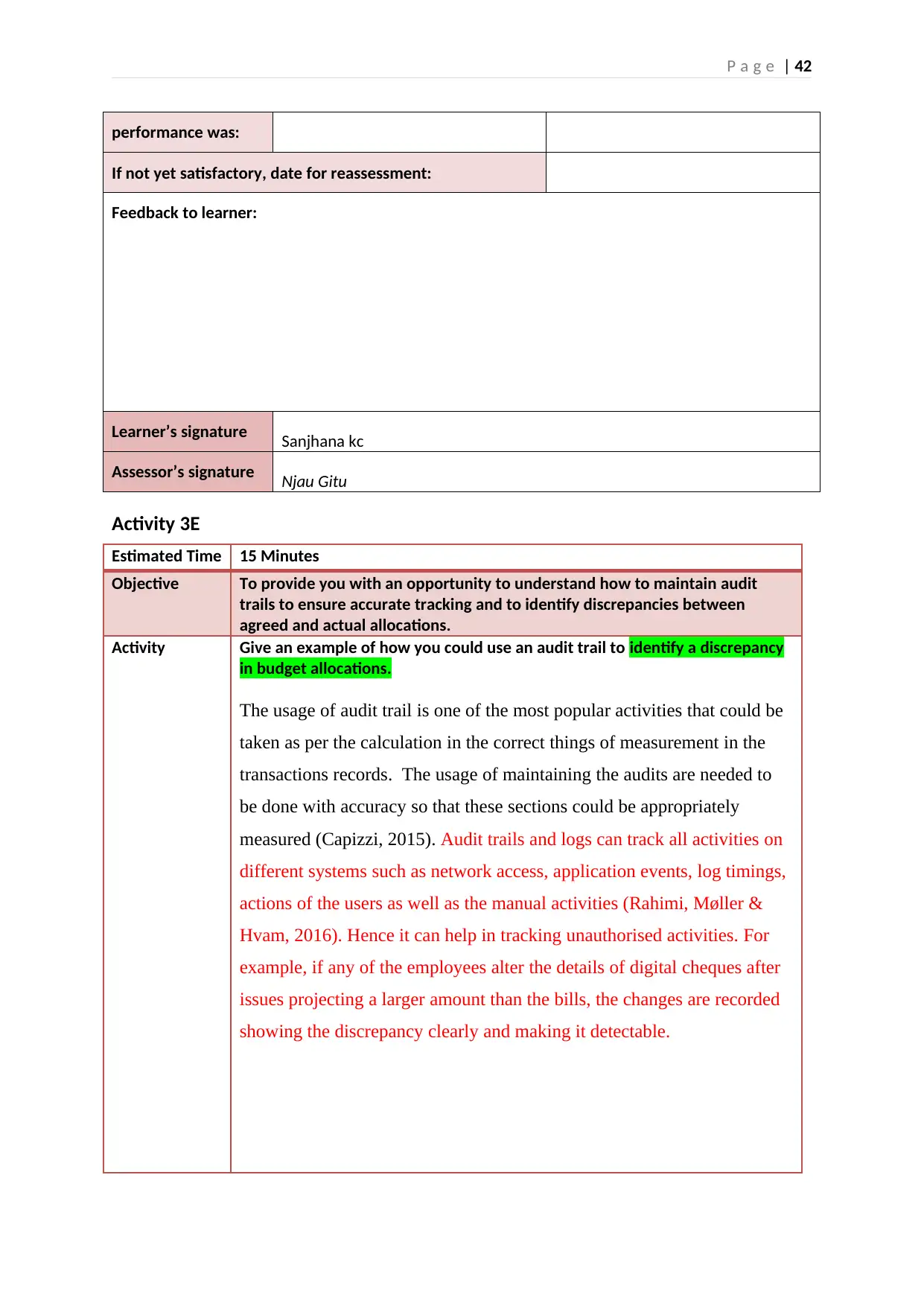
P a g e | 42
performance was:
If not yet satisfactory, date for reassessment:
Feedback to learner:
Learner’s signature Sanjhana kc
Assessor’s signature Njau Gitu
Activity 3E
Estimated Time 15 Minutes
Objective To provide you with an opportunity to understand how to maintain audit
trails to ensure accurate tracking and to identify discrepancies between
agreed and actual allocations.
Activity Give an example of how you could use an audit trail to identify a discrepancy
in budget allocations.
The usage of audit trail is one of the most popular activities that could be
taken as per the calculation in the correct things of measurement in the
transactions records. The usage of maintaining the audits are needed to
be done with accuracy so that these sections could be appropriately
measured (Capizzi, 2015). Audit trails and logs can track all activities on
different systems such as network access, application events, log timings,
actions of the users as well as the manual activities (Rahimi, Møller &
Hvam, 2016). Hence it can help in tracking unauthorised activities. For
example, if any of the employees alter the details of digital cheques after
issues projecting a larger amount than the bills, the changes are recorded
showing the discrepancy clearly and making it detectable.
performance was:
If not yet satisfactory, date for reassessment:
Feedback to learner:
Learner’s signature Sanjhana kc
Assessor’s signature Njau Gitu
Activity 3E
Estimated Time 15 Minutes
Objective To provide you with an opportunity to understand how to maintain audit
trails to ensure accurate tracking and to identify discrepancies between
agreed and actual allocations.
Activity Give an example of how you could use an audit trail to identify a discrepancy
in budget allocations.
The usage of audit trail is one of the most popular activities that could be
taken as per the calculation in the correct things of measurement in the
transactions records. The usage of maintaining the audits are needed to
be done with accuracy so that these sections could be appropriately
measured (Capizzi, 2015). Audit trails and logs can track all activities on
different systems such as network access, application events, log timings,
actions of the users as well as the manual activities (Rahimi, Møller &
Hvam, 2016). Hence it can help in tracking unauthorised activities. For
example, if any of the employees alter the details of digital cheques after
issues projecting a larger amount than the bills, the changes are recorded
showing the discrepancy clearly and making it detectable.
Paraphrase This Document
Need a fresh take? Get an instant paraphrase of this document with our AI Paraphraser
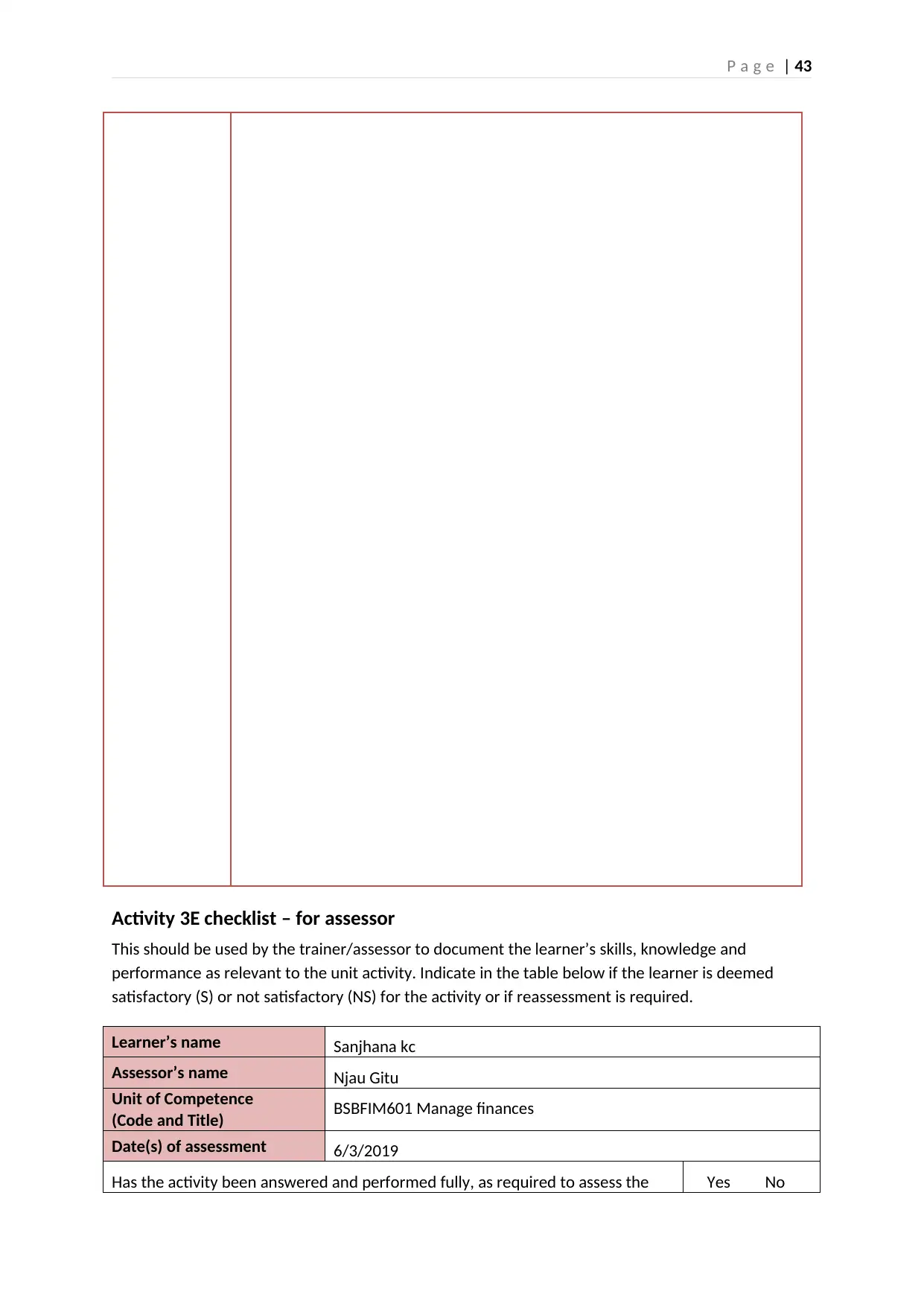
P a g e | 43
Activity 3E checklist – for assessor
This should be used by the trainer/assessor to document the learner’s skills, knowledge and
performance as relevant to the unit activity. Indicate in the table below if the learner is deemed
satisfactory (S) or not satisfactory (NS) for the activity or if reassessment is required.
Learner’s name Sanjhana kc
Assessor’s name Njau Gitu
Unit of Competence
(Code and Title) BSBFIM601 Manage finances
Date(s) of assessment 6/3/2019
Has the activity been answered and performed fully, as required to assess the Yes No
Activity 3E checklist – for assessor
This should be used by the trainer/assessor to document the learner’s skills, knowledge and
performance as relevant to the unit activity. Indicate in the table below if the learner is deemed
satisfactory (S) or not satisfactory (NS) for the activity or if reassessment is required.
Learner’s name Sanjhana kc
Assessor’s name Njau Gitu
Unit of Competence
(Code and Title) BSBFIM601 Manage finances
Date(s) of assessment 6/3/2019
Has the activity been answered and performed fully, as required to assess the Yes No
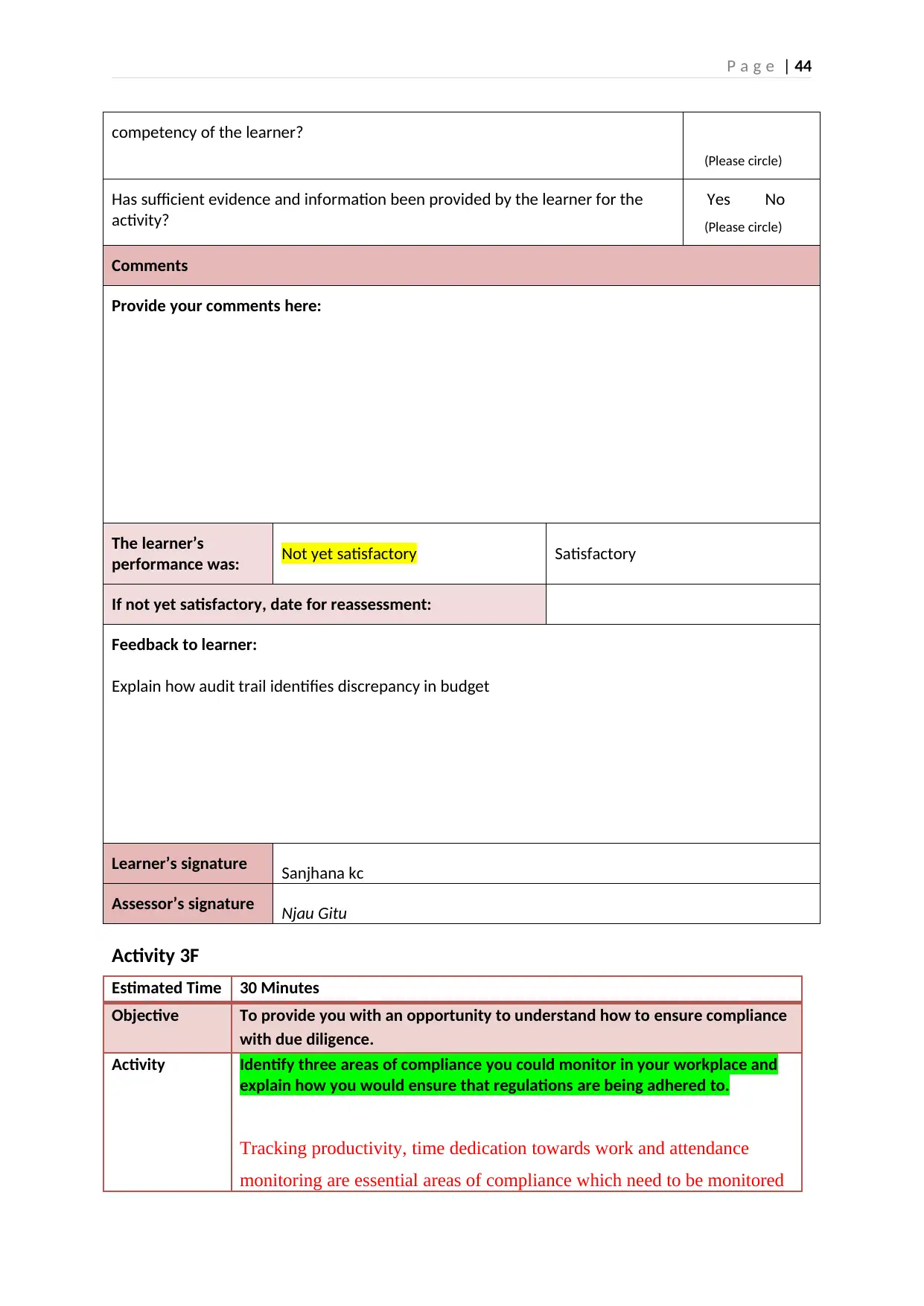
P a g e | 44
competency of the learner?
(Please circle)
Has sufficient evidence and information been provided by the learner for the
activity?
Yes No
(Please circle)
Comments
Provide your comments here:
The learner’s
performance was: Not yet satisfactory Satisfactory
If not yet satisfactory, date for reassessment:
Feedback to learner:
Explain how audit trail identifies discrepancy in budget
Learner’s signature Sanjhana kc
Assessor’s signature Njau Gitu
Activity 3F
Estimated Time 30 Minutes
Objective To provide you with an opportunity to understand how to ensure compliance
with due diligence.
Activity Identify three areas of compliance you could monitor in your workplace and
explain how you would ensure that regulations are being adhered to.
Tracking productivity, time dedication towards work and attendance
monitoring are essential areas of compliance which need to be monitored
competency of the learner?
(Please circle)
Has sufficient evidence and information been provided by the learner for the
activity?
Yes No
(Please circle)
Comments
Provide your comments here:
The learner’s
performance was: Not yet satisfactory Satisfactory
If not yet satisfactory, date for reassessment:
Feedback to learner:
Explain how audit trail identifies discrepancy in budget
Learner’s signature Sanjhana kc
Assessor’s signature Njau Gitu
Activity 3F
Estimated Time 30 Minutes
Objective To provide you with an opportunity to understand how to ensure compliance
with due diligence.
Activity Identify three areas of compliance you could monitor in your workplace and
explain how you would ensure that regulations are being adhered to.
Tracking productivity, time dedication towards work and attendance
monitoring are essential areas of compliance which need to be monitored
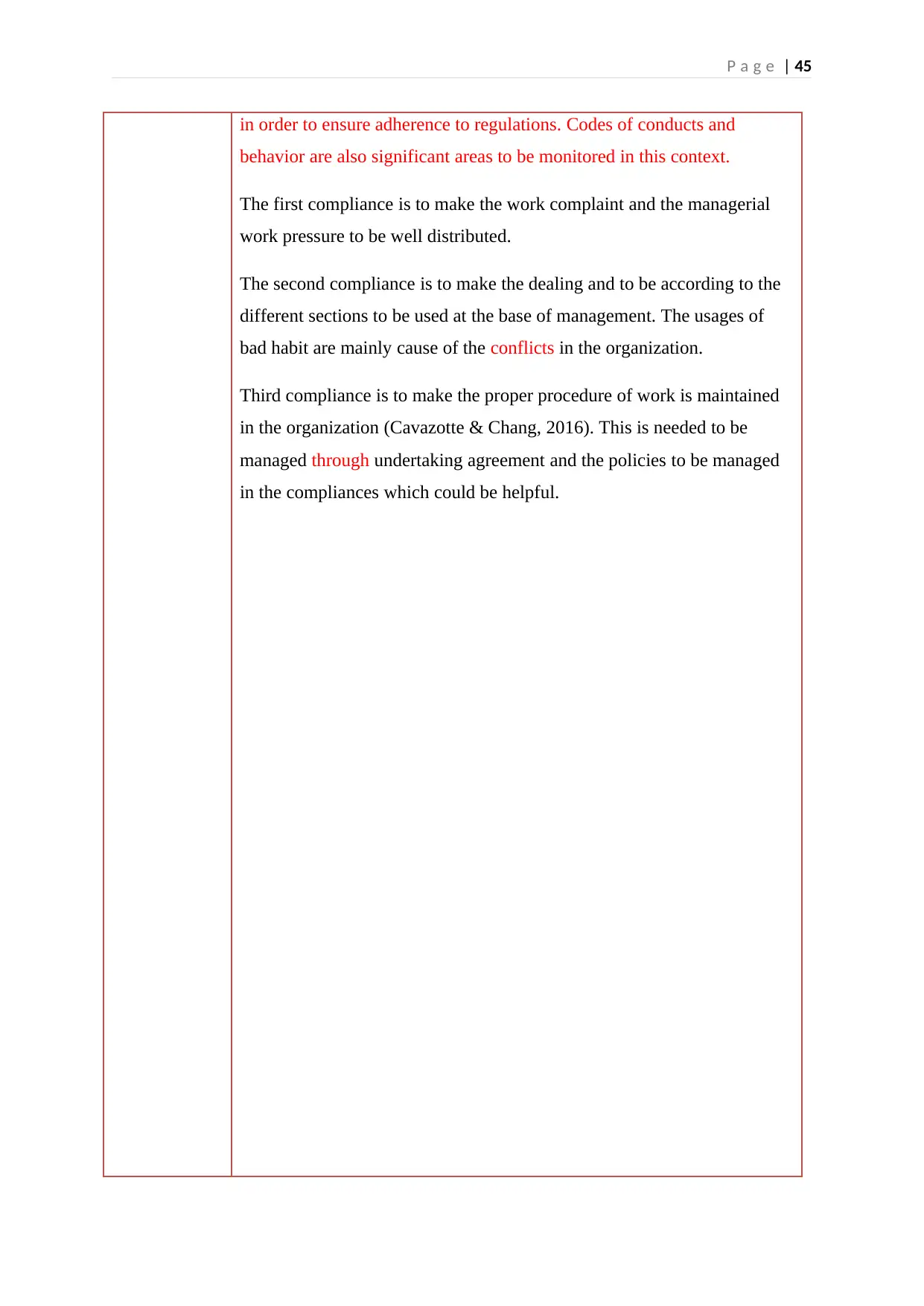
P a g e | 45
in order to ensure adherence to regulations. Codes of conducts and
behavior are also significant areas to be monitored in this context.
The first compliance is to make the work complaint and the managerial
work pressure to be well distributed.
The second compliance is to make the dealing and to be according to the
different sections to be used at the base of management. The usages of
bad habit are mainly cause of the conflicts in the organization.
Third compliance is to make the proper procedure of work is maintained
in the organization (Cavazotte & Chang, 2016). This is needed to be
managed through undertaking agreement and the policies to be managed
in the compliances which could be helpful.
in order to ensure adherence to regulations. Codes of conducts and
behavior are also significant areas to be monitored in this context.
The first compliance is to make the work complaint and the managerial
work pressure to be well distributed.
The second compliance is to make the dealing and to be according to the
different sections to be used at the base of management. The usages of
bad habit are mainly cause of the conflicts in the organization.
Third compliance is to make the proper procedure of work is maintained
in the organization (Cavazotte & Chang, 2016). This is needed to be
managed through undertaking agreement and the policies to be managed
in the compliances which could be helpful.
Secure Best Marks with AI Grader
Need help grading? Try our AI Grader for instant feedback on your assignments.
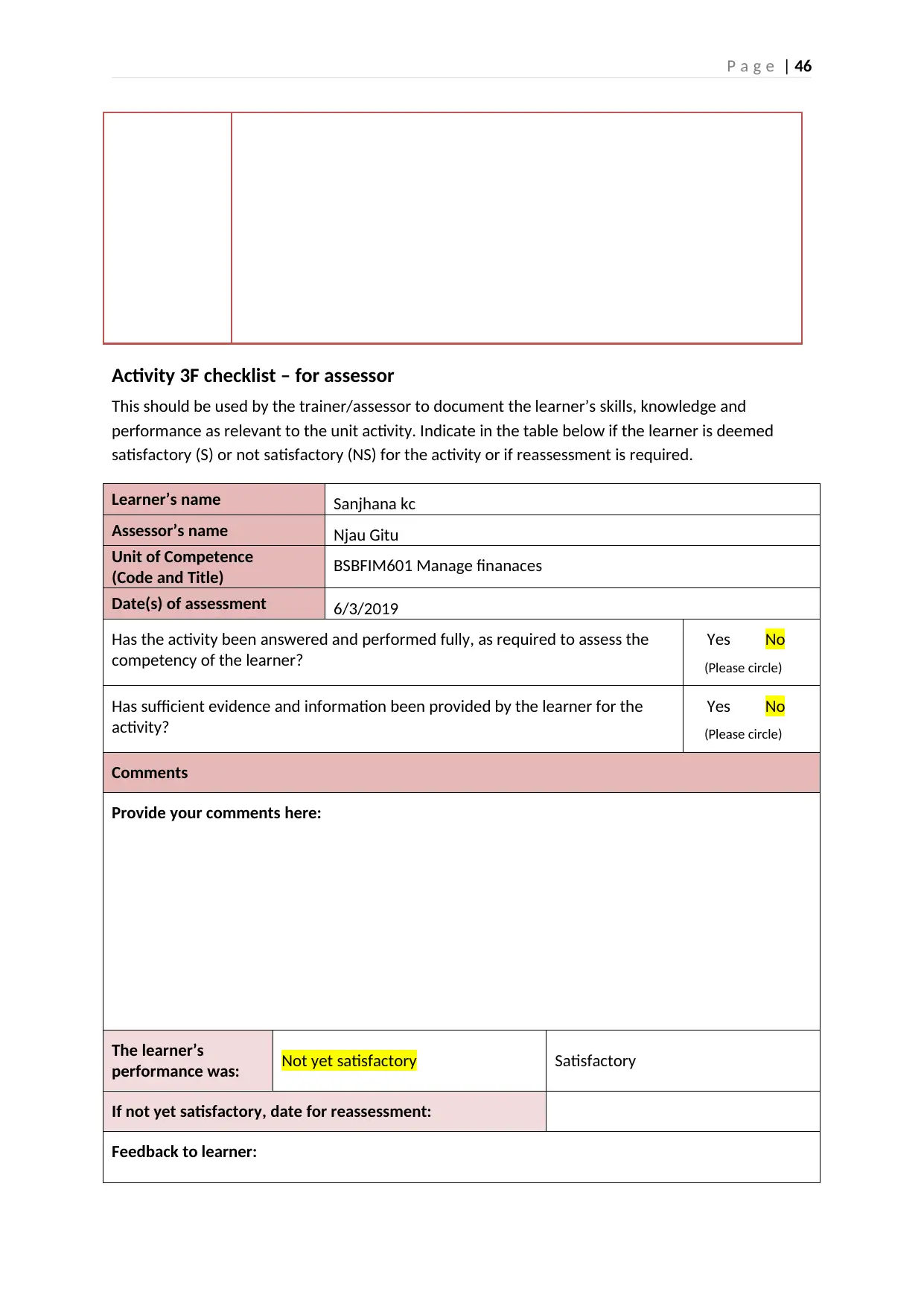
P a g e | 46
Activity 3F checklist – for assessor
This should be used by the trainer/assessor to document the learner’s skills, knowledge and
performance as relevant to the unit activity. Indicate in the table below if the learner is deemed
satisfactory (S) or not satisfactory (NS) for the activity or if reassessment is required.
Learner’s name Sanjhana kc
Assessor’s name Njau Gitu
Unit of Competence
(Code and Title) BSBFIM601 Manage finanaces
Date(s) of assessment 6/3/2019
Has the activity been answered and performed fully, as required to assess the
competency of the learner?
Yes No
(Please circle)
Has sufficient evidence and information been provided by the learner for the
activity?
Yes No
(Please circle)
Comments
Provide your comments here:
The learner’s
performance was: Not yet satisfactory Satisfactory
If not yet satisfactory, date for reassessment:
Feedback to learner:
Activity 3F checklist – for assessor
This should be used by the trainer/assessor to document the learner’s skills, knowledge and
performance as relevant to the unit activity. Indicate in the table below if the learner is deemed
satisfactory (S) or not satisfactory (NS) for the activity or if reassessment is required.
Learner’s name Sanjhana kc
Assessor’s name Njau Gitu
Unit of Competence
(Code and Title) BSBFIM601 Manage finanaces
Date(s) of assessment 6/3/2019
Has the activity been answered and performed fully, as required to assess the
competency of the learner?
Yes No
(Please circle)
Has sufficient evidence and information been provided by the learner for the
activity?
Yes No
(Please circle)
Comments
Provide your comments here:
The learner’s
performance was: Not yet satisfactory Satisfactory
If not yet satisfactory, date for reassessment:
Feedback to learner:
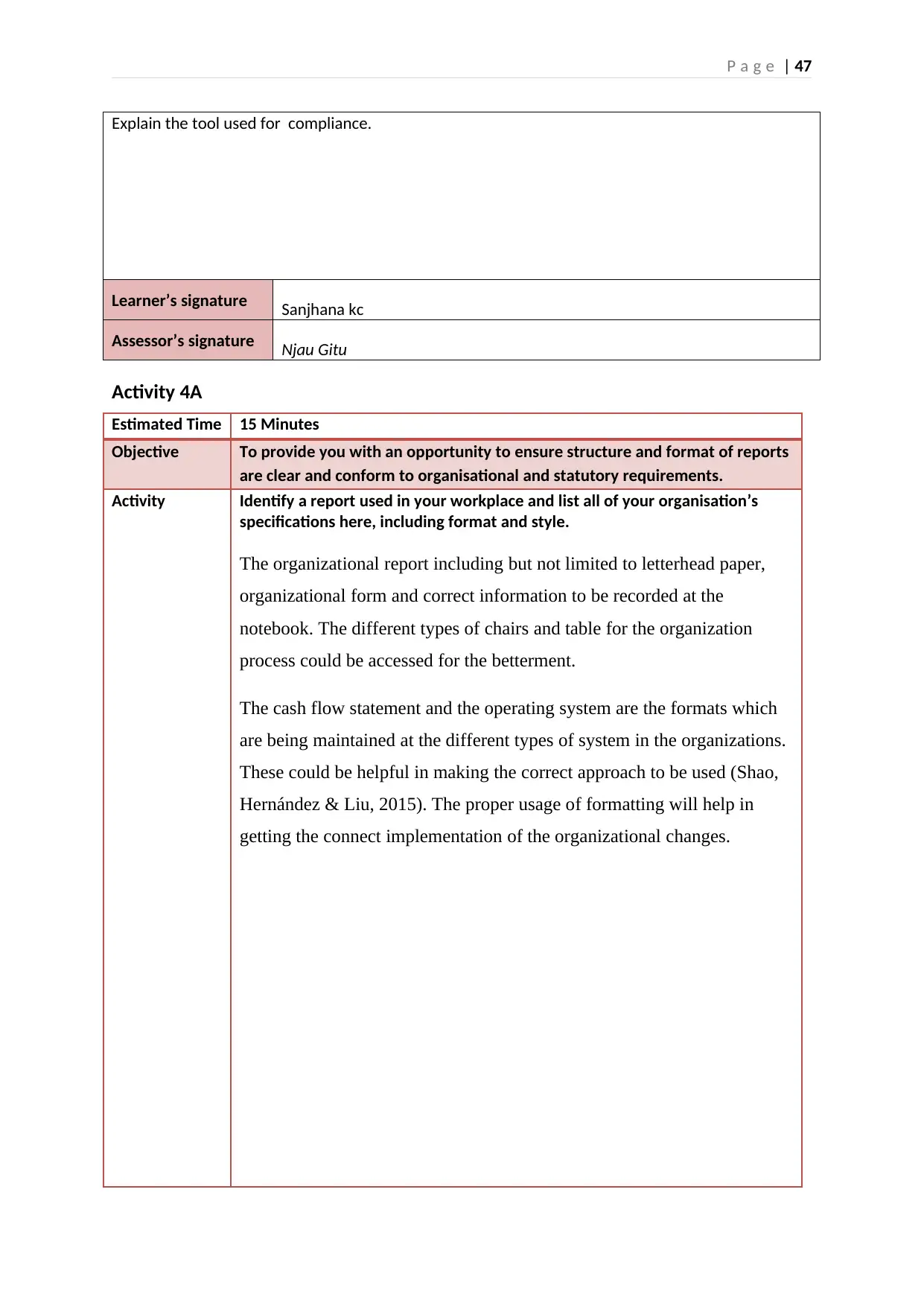
P a g e | 47
Explain the tool used for compliance.
Learner’s signature Sanjhana kc
Assessor’s signature Njau Gitu
Activity 4A
Estimated Time 15 Minutes
Objective To provide you with an opportunity to ensure structure and format of reports
are clear and conform to organisational and statutory requirements.
Activity Identify a report used in your workplace and list all of your organisation’s
specifications here, including format and style.
The organizational report including but not limited to letterhead paper,
organizational form and correct information to be recorded at the
notebook. The different types of chairs and table for the organization
process could be accessed for the betterment.
The cash flow statement and the operating system are the formats which
are being maintained at the different types of system in the organizations.
These could be helpful in making the correct approach to be used (Shao,
Hernández & Liu, 2015). The proper usage of formatting will help in
getting the connect implementation of the organizational changes.
Explain the tool used for compliance.
Learner’s signature Sanjhana kc
Assessor’s signature Njau Gitu
Activity 4A
Estimated Time 15 Minutes
Objective To provide you with an opportunity to ensure structure and format of reports
are clear and conform to organisational and statutory requirements.
Activity Identify a report used in your workplace and list all of your organisation’s
specifications here, including format and style.
The organizational report including but not limited to letterhead paper,
organizational form and correct information to be recorded at the
notebook. The different types of chairs and table for the organization
process could be accessed for the betterment.
The cash flow statement and the operating system are the formats which
are being maintained at the different types of system in the organizations.
These could be helpful in making the correct approach to be used (Shao,
Hernández & Liu, 2015). The proper usage of formatting will help in
getting the connect implementation of the organizational changes.
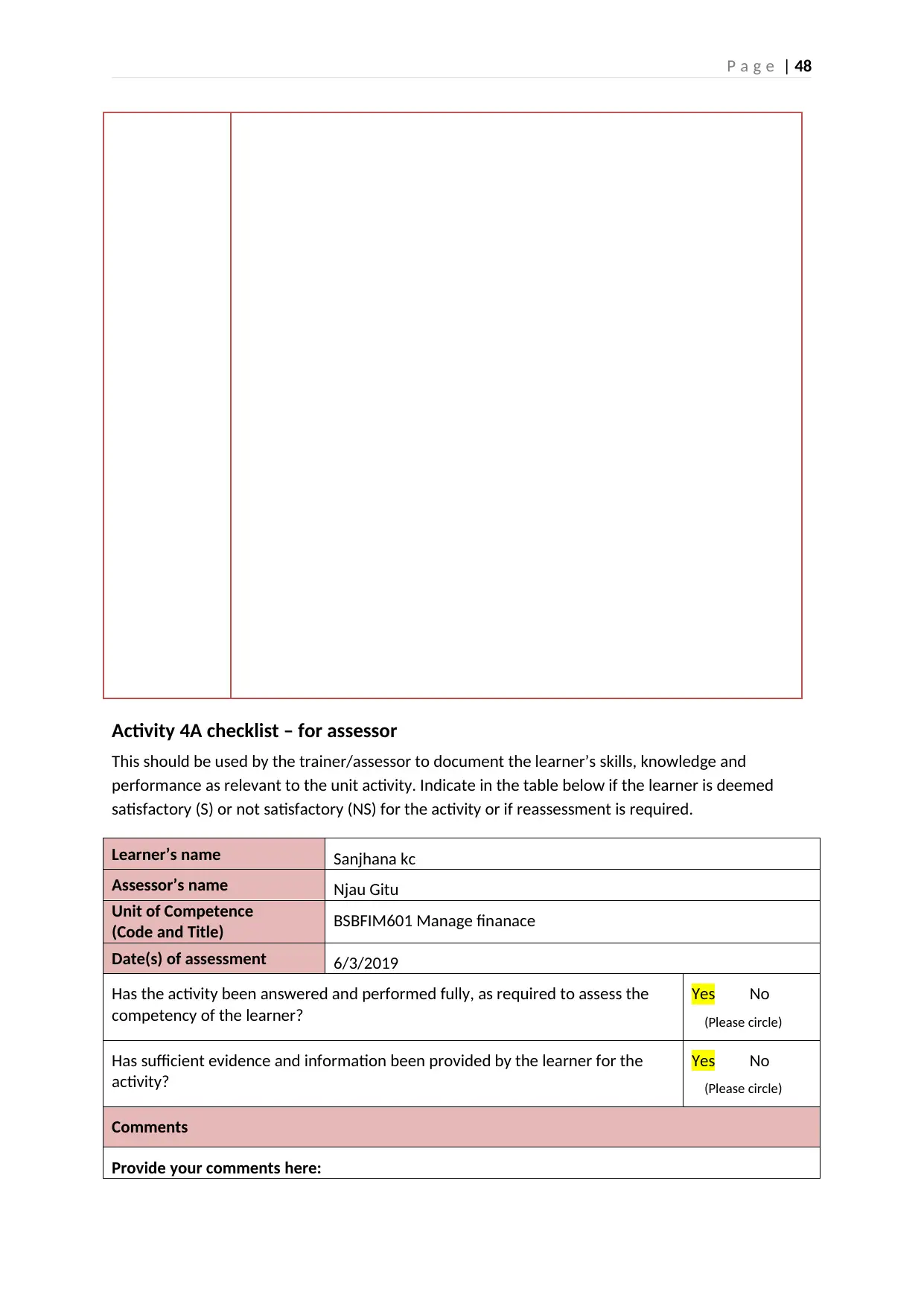
P a g e | 48
Activity 4A checklist – for assessor
This should be used by the trainer/assessor to document the learner’s skills, knowledge and
performance as relevant to the unit activity. Indicate in the table below if the learner is deemed
satisfactory (S) or not satisfactory (NS) for the activity or if reassessment is required.
Learner’s name Sanjhana kc
Assessor’s name Njau Gitu
Unit of Competence
(Code and Title) BSBFIM601 Manage finanace
Date(s) of assessment 6/3/2019
Has the activity been answered and performed fully, as required to assess the
competency of the learner?
Yes No
(Please circle)
Has sufficient evidence and information been provided by the learner for the
activity?
Yes No
(Please circle)
Comments
Provide your comments here:
Activity 4A checklist – for assessor
This should be used by the trainer/assessor to document the learner’s skills, knowledge and
performance as relevant to the unit activity. Indicate in the table below if the learner is deemed
satisfactory (S) or not satisfactory (NS) for the activity or if reassessment is required.
Learner’s name Sanjhana kc
Assessor’s name Njau Gitu
Unit of Competence
(Code and Title) BSBFIM601 Manage finanace
Date(s) of assessment 6/3/2019
Has the activity been answered and performed fully, as required to assess the
competency of the learner?
Yes No
(Please circle)
Has sufficient evidence and information been provided by the learner for the
activity?
Yes No
(Please circle)
Comments
Provide your comments here:
Paraphrase This Document
Need a fresh take? Get an instant paraphrase of this document with our AI Paraphraser
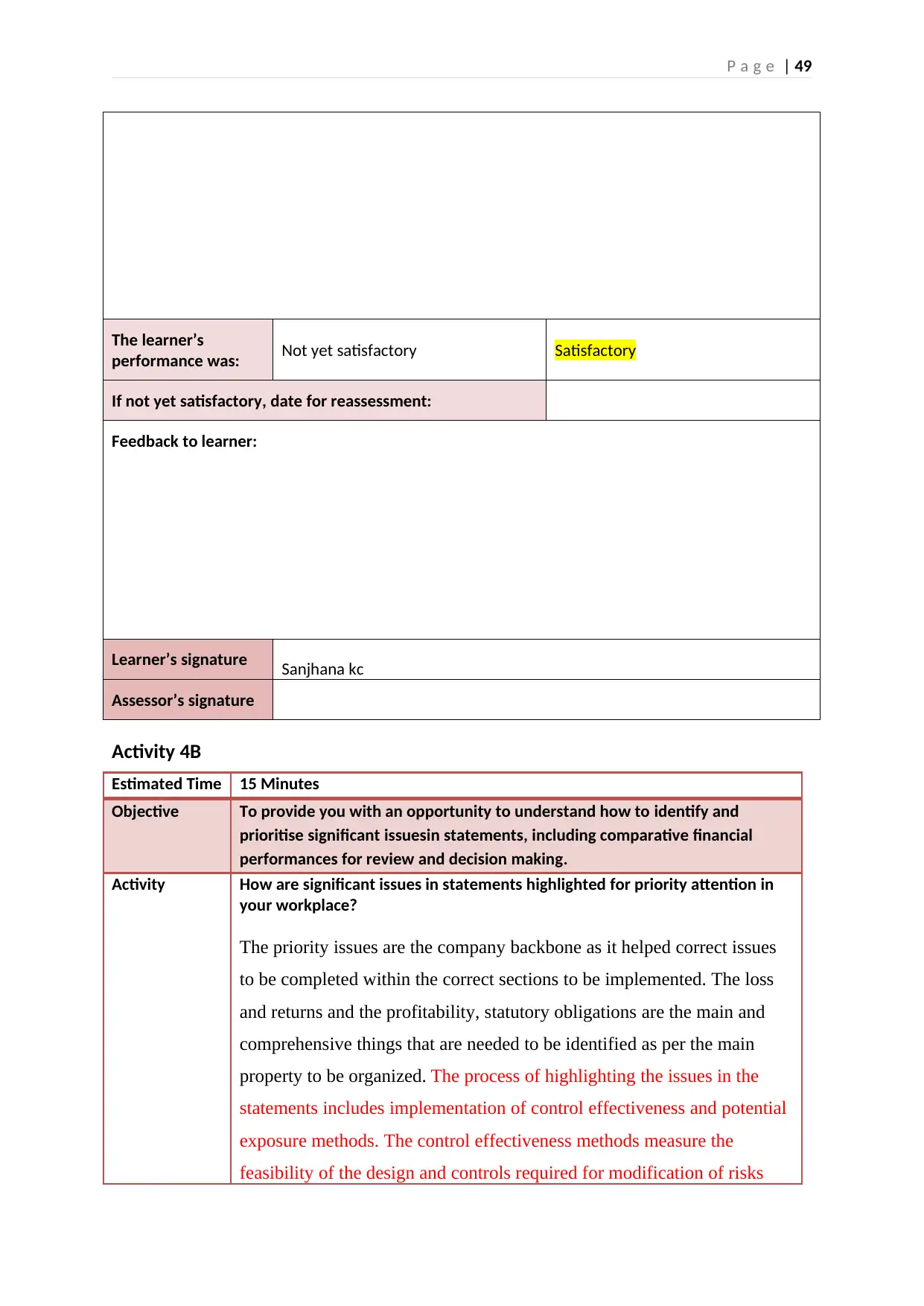
P a g e | 49
The learner’s
performance was: Not yet satisfactory Satisfactory
If not yet satisfactory, date for reassessment:
Feedback to learner:
Learner’s signature Sanjhana kc
Assessor’s signature
Activity 4B
Estimated Time 15 Minutes
Objective To provide you with an opportunity to understand how to identify and
prioritise significant issuesin statements, including comparative financial
performances for review and decision making.
Activity How are significant issues in statements highlighted for priority attention in
your workplace?
The priority issues are the company backbone as it helped correct issues
to be completed within the correct sections to be implemented. The loss
and returns and the profitability, statutory obligations are the main and
comprehensive things that are needed to be identified as per the main
property to be organized. The process of highlighting the issues in the
statements includes implementation of control effectiveness and potential
exposure methods. The control effectiveness methods measure the
feasibility of the design and controls required for modification of risks
The learner’s
performance was: Not yet satisfactory Satisfactory
If not yet satisfactory, date for reassessment:
Feedback to learner:
Learner’s signature Sanjhana kc
Assessor’s signature
Activity 4B
Estimated Time 15 Minutes
Objective To provide you with an opportunity to understand how to identify and
prioritise significant issuesin statements, including comparative financial
performances for review and decision making.
Activity How are significant issues in statements highlighted for priority attention in
your workplace?
The priority issues are the company backbone as it helped correct issues
to be completed within the correct sections to be implemented. The loss
and returns and the profitability, statutory obligations are the main and
comprehensive things that are needed to be identified as per the main
property to be organized. The process of highlighting the issues in the
statements includes implementation of control effectiveness and potential
exposure methods. The control effectiveness methods measure the
feasibility of the design and controls required for modification of risks
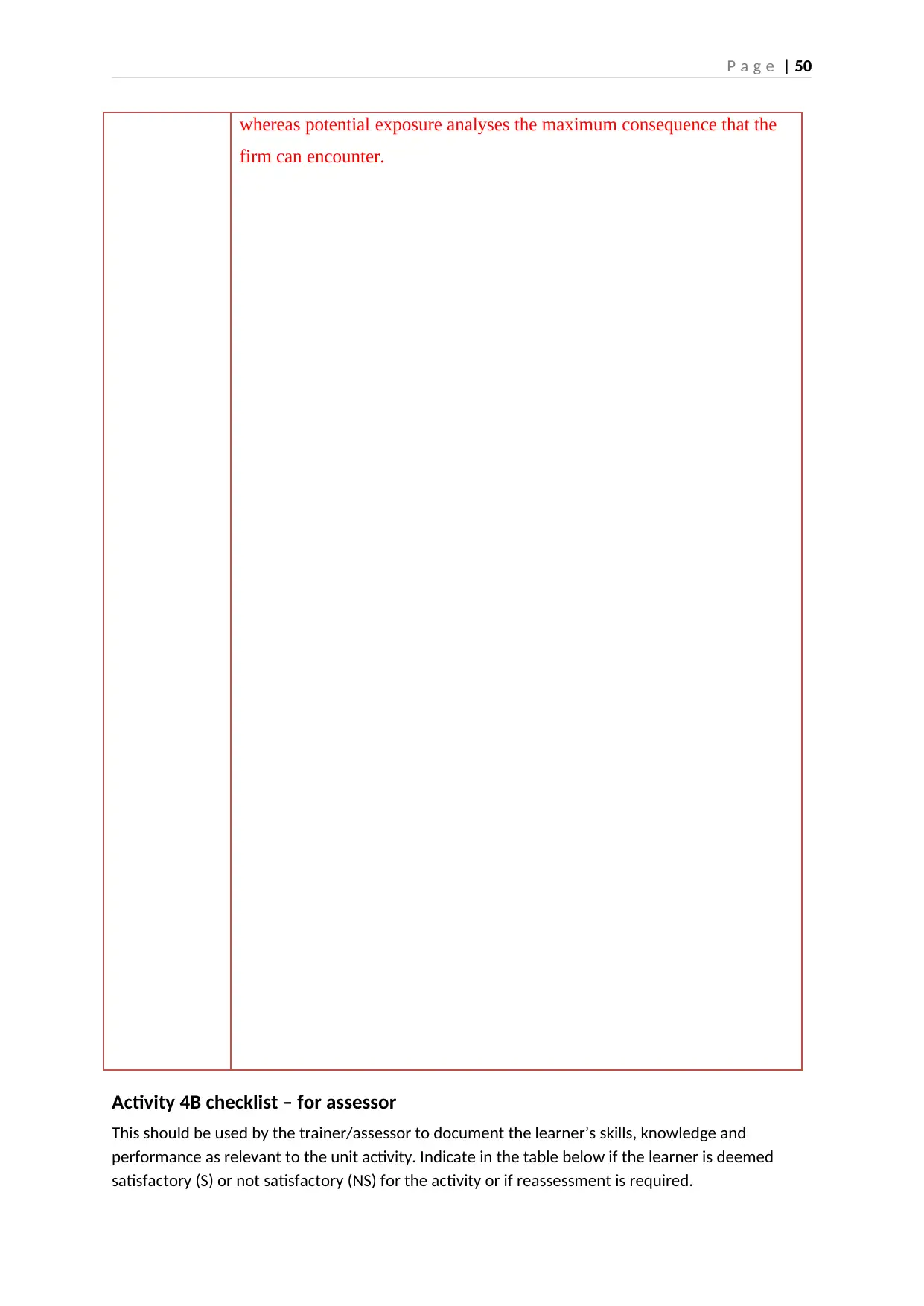
P a g e | 50
whereas potential exposure analyses the maximum consequence that the
firm can encounter.
Activity 4B checklist – for assessor
This should be used by the trainer/assessor to document the learner’s skills, knowledge and
performance as relevant to the unit activity. Indicate in the table below if the learner is deemed
satisfactory (S) or not satisfactory (NS) for the activity or if reassessment is required.
whereas potential exposure analyses the maximum consequence that the
firm can encounter.
Activity 4B checklist – for assessor
This should be used by the trainer/assessor to document the learner’s skills, knowledge and
performance as relevant to the unit activity. Indicate in the table below if the learner is deemed
satisfactory (S) or not satisfactory (NS) for the activity or if reassessment is required.
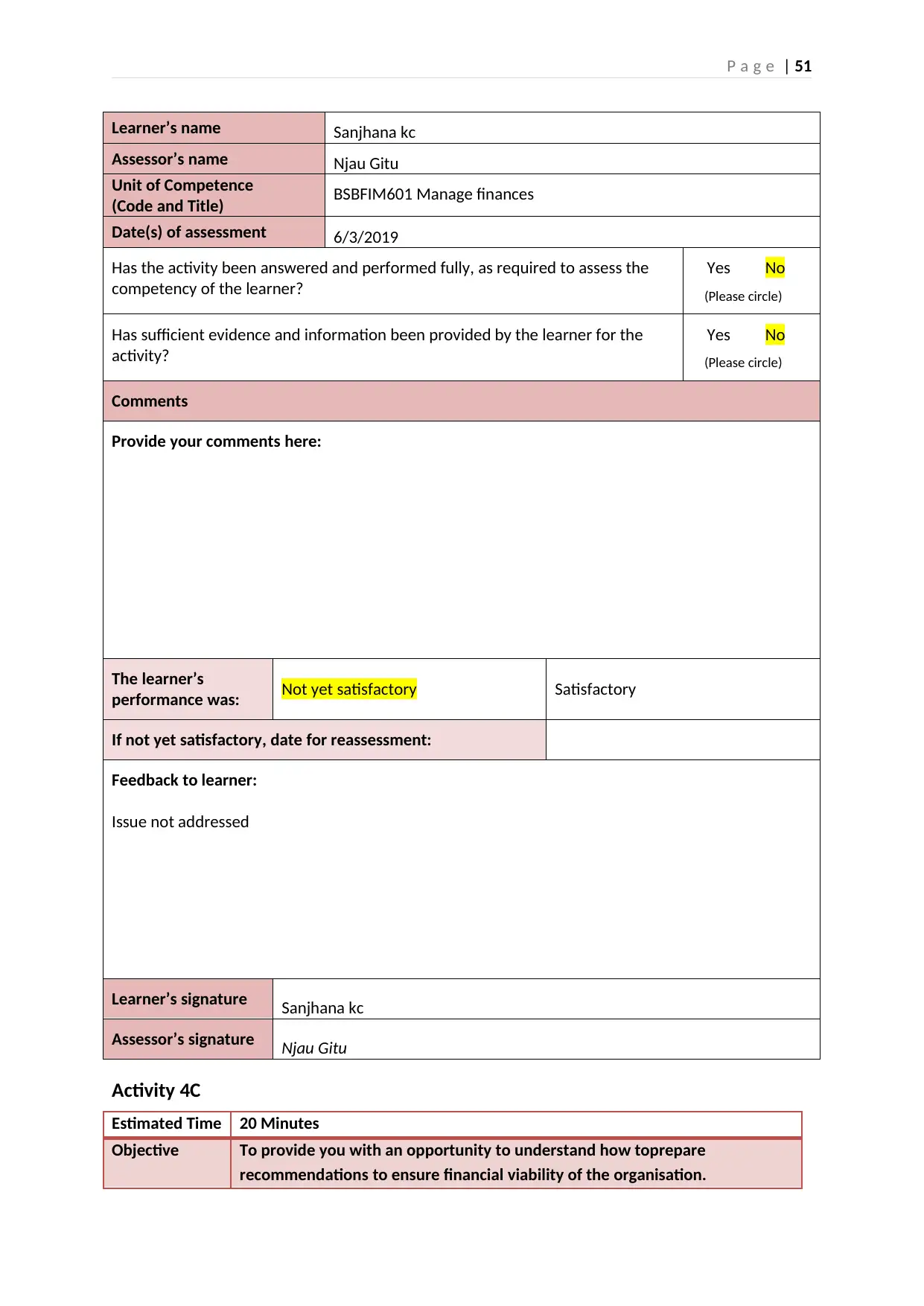
P a g e | 51
Learner’s name Sanjhana kc
Assessor’s name Njau Gitu
Unit of Competence
(Code and Title) BSBFIM601 Manage finances
Date(s) of assessment 6/3/2019
Has the activity been answered and performed fully, as required to assess the
competency of the learner?
Yes No
(Please circle)
Has sufficient evidence and information been provided by the learner for the
activity?
Yes No
(Please circle)
Comments
Provide your comments here:
The learner’s
performance was: Not yet satisfactory Satisfactory
If not yet satisfactory, date for reassessment:
Feedback to learner:
Issue not addressed
Learner’s signature Sanjhana kc
Assessor’s signature Njau Gitu
Activity 4C
Estimated Time 20 Minutes
Objective To provide you with an opportunity to understand how toprepare
recommendations to ensure financial viability of the organisation.
Learner’s name Sanjhana kc
Assessor’s name Njau Gitu
Unit of Competence
(Code and Title) BSBFIM601 Manage finances
Date(s) of assessment 6/3/2019
Has the activity been answered and performed fully, as required to assess the
competency of the learner?
Yes No
(Please circle)
Has sufficient evidence and information been provided by the learner for the
activity?
Yes No
(Please circle)
Comments
Provide your comments here:
The learner’s
performance was: Not yet satisfactory Satisfactory
If not yet satisfactory, date for reassessment:
Feedback to learner:
Issue not addressed
Learner’s signature Sanjhana kc
Assessor’s signature Njau Gitu
Activity 4C
Estimated Time 20 Minutes
Objective To provide you with an opportunity to understand how toprepare
recommendations to ensure financial viability of the organisation.
Secure Best Marks with AI Grader
Need help grading? Try our AI Grader for instant feedback on your assignments.
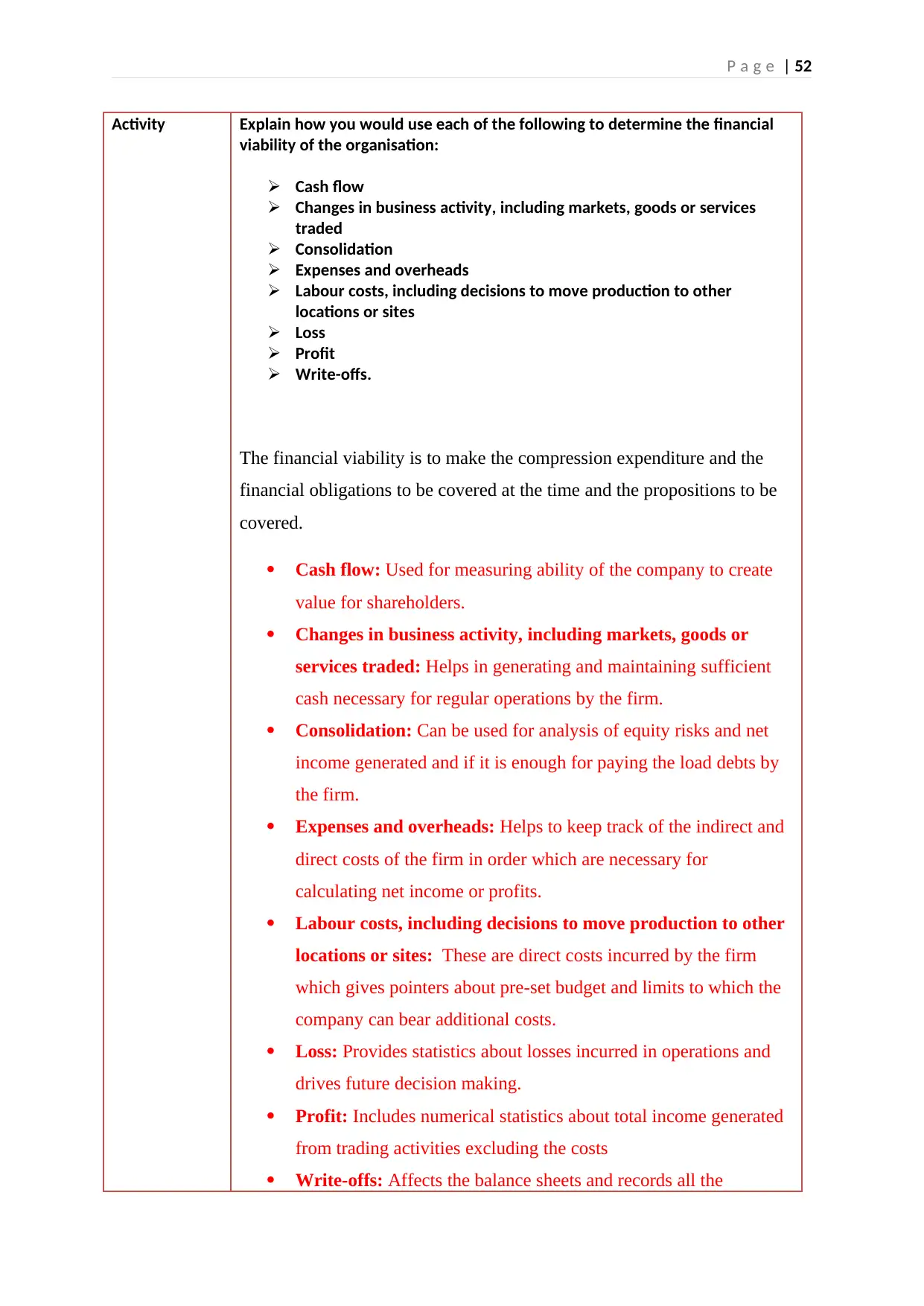
P a g e | 52
Activity Explain how you would use each of the following to determine the financial
viability of the organisation:
Cash flow
Changes in business activity, including markets, goods or services
traded
Consolidation
Expenses and overheads
Labour costs, including decisions to move production to other
locations or sites
Loss
Profit
Write-offs.
The financial viability is to make the compression expenditure and the
financial obligations to be covered at the time and the propositions to be
covered.
Cash flow: Used for measuring ability of the company to create
value for shareholders.
Changes in business activity, including markets, goods or
services traded: Helps in generating and maintaining sufficient
cash necessary for regular operations by the firm.
Consolidation: Can be used for analysis of equity risks and net
income generated and if it is enough for paying the load debts by
the firm.
Expenses and overheads: Helps to keep track of the indirect and
direct costs of the firm in order which are necessary for
calculating net income or profits.
Labour costs, including decisions to move production to other
locations or sites: These are direct costs incurred by the firm
which gives pointers about pre-set budget and limits to which the
company can bear additional costs.
Loss: Provides statistics about losses incurred in operations and
drives future decision making.
Profit: Includes numerical statistics about total income generated
from trading activities excluding the costs
Write-offs: Affects the balance sheets and records all the
Activity Explain how you would use each of the following to determine the financial
viability of the organisation:
Cash flow
Changes in business activity, including markets, goods or services
traded
Consolidation
Expenses and overheads
Labour costs, including decisions to move production to other
locations or sites
Loss
Profit
Write-offs.
The financial viability is to make the compression expenditure and the
financial obligations to be covered at the time and the propositions to be
covered.
Cash flow: Used for measuring ability of the company to create
value for shareholders.
Changes in business activity, including markets, goods or
services traded: Helps in generating and maintaining sufficient
cash necessary for regular operations by the firm.
Consolidation: Can be used for analysis of equity risks and net
income generated and if it is enough for paying the load debts by
the firm.
Expenses and overheads: Helps to keep track of the indirect and
direct costs of the firm in order which are necessary for
calculating net income or profits.
Labour costs, including decisions to move production to other
locations or sites: These are direct costs incurred by the firm
which gives pointers about pre-set budget and limits to which the
company can bear additional costs.
Loss: Provides statistics about losses incurred in operations and
drives future decision making.
Profit: Includes numerical statistics about total income generated
from trading activities excluding the costs
Write-offs: Affects the balance sheets and records all the
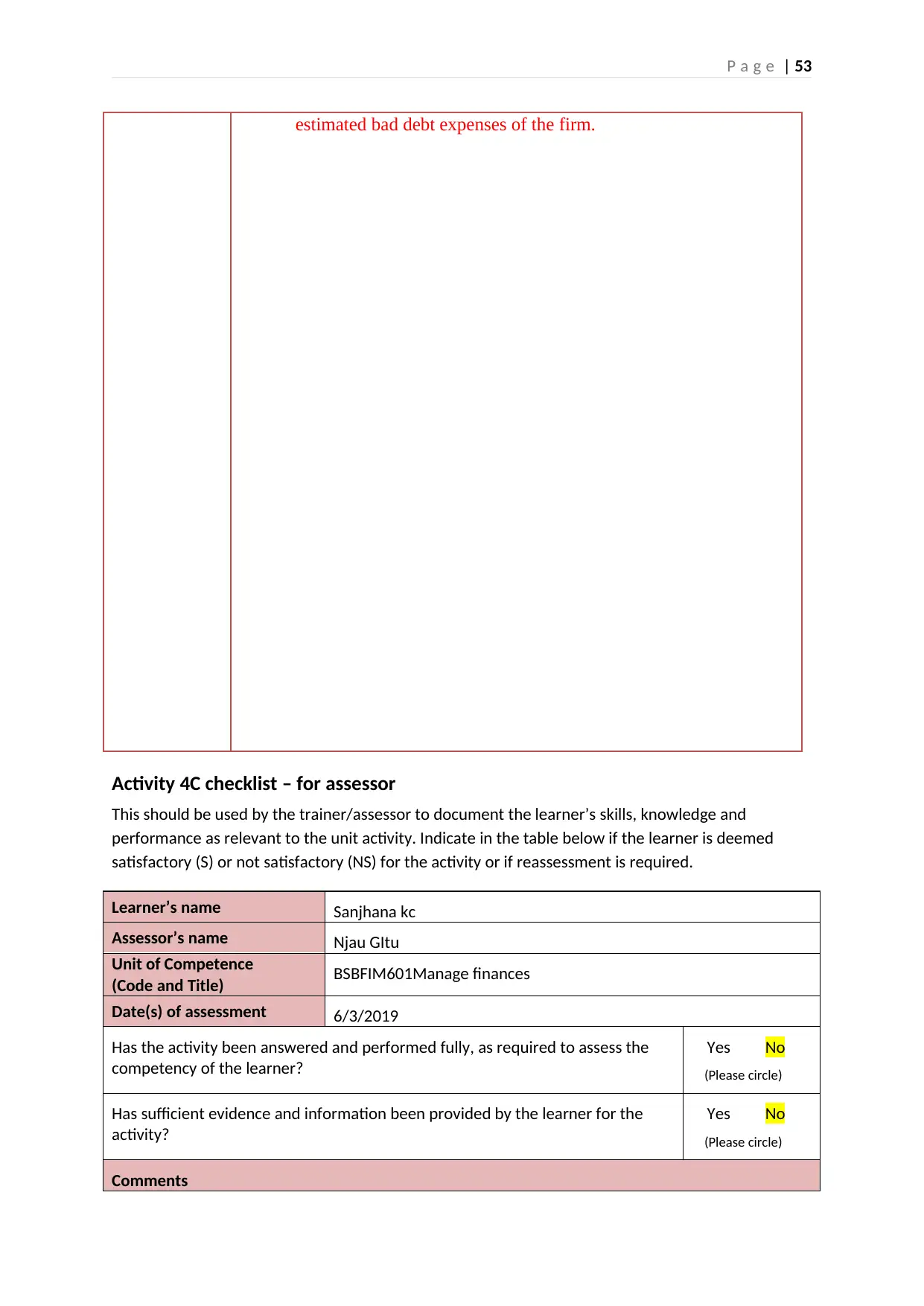
P a g e | 53
estimated bad debt expenses of the firm.
Activity 4C checklist – for assessor
This should be used by the trainer/assessor to document the learner’s skills, knowledge and
performance as relevant to the unit activity. Indicate in the table below if the learner is deemed
satisfactory (S) or not satisfactory (NS) for the activity or if reassessment is required.
Learner’s name Sanjhana kc
Assessor’s name Njau GItu
Unit of Competence
(Code and Title) BSBFIM601Manage finances
Date(s) of assessment 6/3/2019
Has the activity been answered and performed fully, as required to assess the
competency of the learner?
Yes No
(Please circle)
Has sufficient evidence and information been provided by the learner for the
activity?
Yes No
(Please circle)
Comments
estimated bad debt expenses of the firm.
Activity 4C checklist – for assessor
This should be used by the trainer/assessor to document the learner’s skills, knowledge and
performance as relevant to the unit activity. Indicate in the table below if the learner is deemed
satisfactory (S) or not satisfactory (NS) for the activity or if reassessment is required.
Learner’s name Sanjhana kc
Assessor’s name Njau GItu
Unit of Competence
(Code and Title) BSBFIM601Manage finances
Date(s) of assessment 6/3/2019
Has the activity been answered and performed fully, as required to assess the
competency of the learner?
Yes No
(Please circle)
Has sufficient evidence and information been provided by the learner for the
activity?
Yes No
(Please circle)
Comments
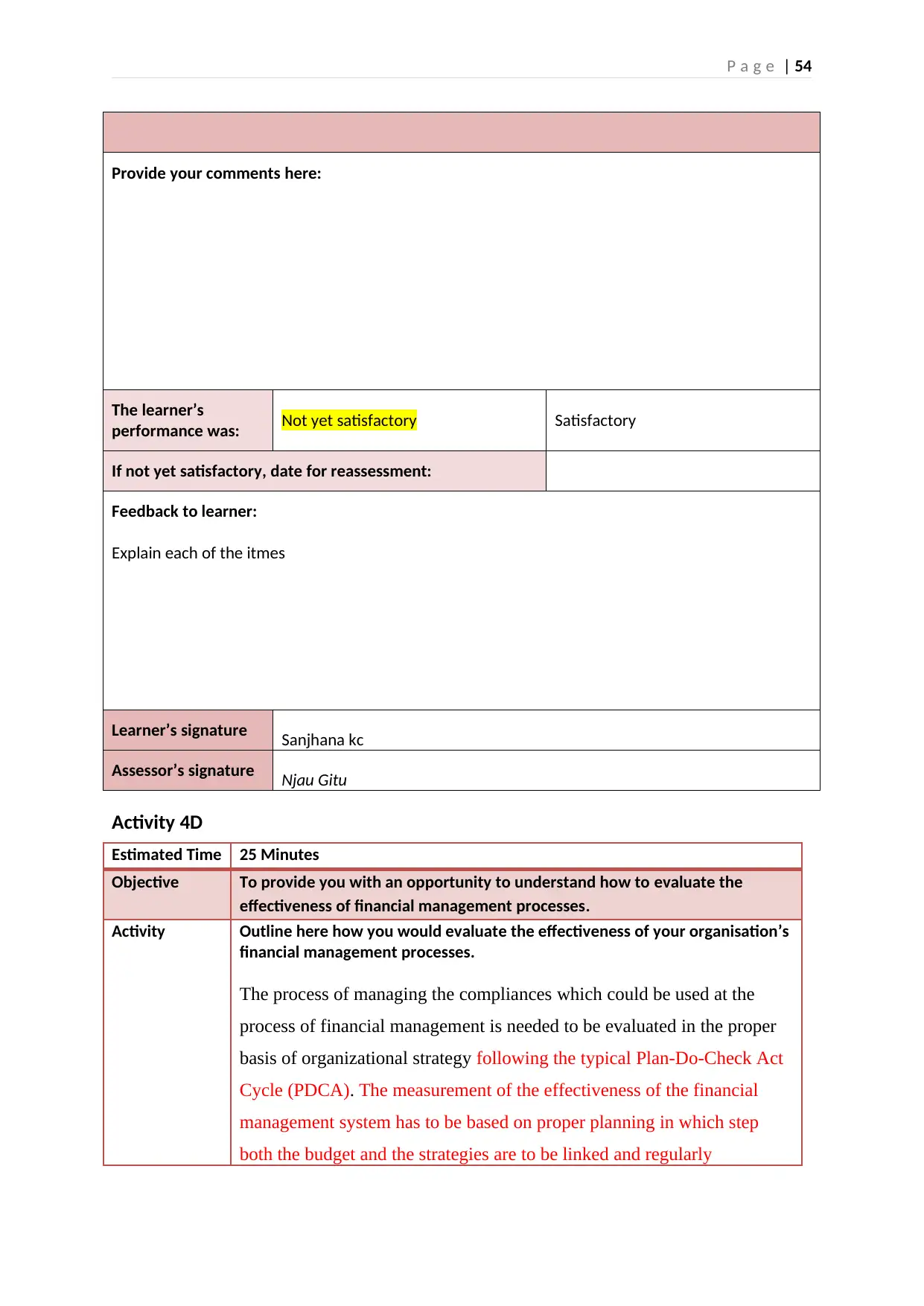
P a g e | 54
Provide your comments here:
The learner’s
performance was: Not yet satisfactory Satisfactory
If not yet satisfactory, date for reassessment:
Feedback to learner:
Explain each of the itmes
Learner’s signature Sanjhana kc
Assessor’s signature Njau Gitu
Activity 4D
Estimated Time 25 Minutes
Objective To provide you with an opportunity to understand how to evaluate the
effectiveness of financial management processes.
Activity Outline here how you would evaluate the effectiveness of your organisation’s
financial management processes.
The process of managing the compliances which could be used at the
process of financial management is needed to be evaluated in the proper
basis of organizational strategy following the typical Plan-Do-Check Act
Cycle (PDCA). The measurement of the effectiveness of the financial
management system has to be based on proper planning in which step
both the budget and the strategies are to be linked and regularly
Provide your comments here:
The learner’s
performance was: Not yet satisfactory Satisfactory
If not yet satisfactory, date for reassessment:
Feedback to learner:
Explain each of the itmes
Learner’s signature Sanjhana kc
Assessor’s signature Njau Gitu
Activity 4D
Estimated Time 25 Minutes
Objective To provide you with an opportunity to understand how to evaluate the
effectiveness of financial management processes.
Activity Outline here how you would evaluate the effectiveness of your organisation’s
financial management processes.
The process of managing the compliances which could be used at the
process of financial management is needed to be evaluated in the proper
basis of organizational strategy following the typical Plan-Do-Check Act
Cycle (PDCA). The measurement of the effectiveness of the financial
management system has to be based on proper planning in which step
both the budget and the strategies are to be linked and regularly
Paraphrase This Document
Need a fresh take? Get an instant paraphrase of this document with our AI Paraphraser

P a g e | 55
compared. The accuracy factors of predictability are also needed to be
analysed in this process. Responsiveness of the management tools used in
the financial management process is to be tracked through specification
reports and conformed to the accounting policies.
compared. The accuracy factors of predictability are also needed to be
analysed in this process. Responsiveness of the management tools used in
the financial management process is to be tracked through specification
reports and conformed to the accounting policies.

P a g e | 56
Activity 4D checklist – for assessor
This should be used by the trainer/assessor to document the learner’s skills, knowledge and
performance as relevant to the unit activity. Indicate in the table below if the learner is deemed
satisfactory (S) or not satisfactory (NS) for the activity or if reassessment is required.
Learner’s name Sanjhana kc
Assessor’s name Njau Gitu
Unit of Competence
(Code and Title) BSBFIM601 Manage finances
Date(s) of assessment 6/3/2019
Has the activity been answered and performed fully, as required to assess the
competency of the learner?
Yes No
(Please circle)
Has sufficient evidence and information been provided by the learner for the
activity?
Yes No
(Please circle)
Comments
Provide your comments here:
The learner’s
performance was: Not yet satisfactory Satisfactory
If not yet satisfactory, date for reassessment:
Feedback to learner:
Learner’s signature Sanjhana kc
Assessor’s signature Njau Gitu
Activity 4D checklist – for assessor
This should be used by the trainer/assessor to document the learner’s skills, knowledge and
performance as relevant to the unit activity. Indicate in the table below if the learner is deemed
satisfactory (S) or not satisfactory (NS) for the activity or if reassessment is required.
Learner’s name Sanjhana kc
Assessor’s name Njau Gitu
Unit of Competence
(Code and Title) BSBFIM601 Manage finances
Date(s) of assessment 6/3/2019
Has the activity been answered and performed fully, as required to assess the
competency of the learner?
Yes No
(Please circle)
Has sufficient evidence and information been provided by the learner for the
activity?
Yes No
(Please circle)
Comments
Provide your comments here:
The learner’s
performance was: Not yet satisfactory Satisfactory
If not yet satisfactory, date for reassessment:
Feedback to learner:
Learner’s signature Sanjhana kc
Assessor’s signature Njau Gitu

P a g e | 57
Secure Best Marks with AI Grader
Need help grading? Try our AI Grader for instant feedback on your assignments.
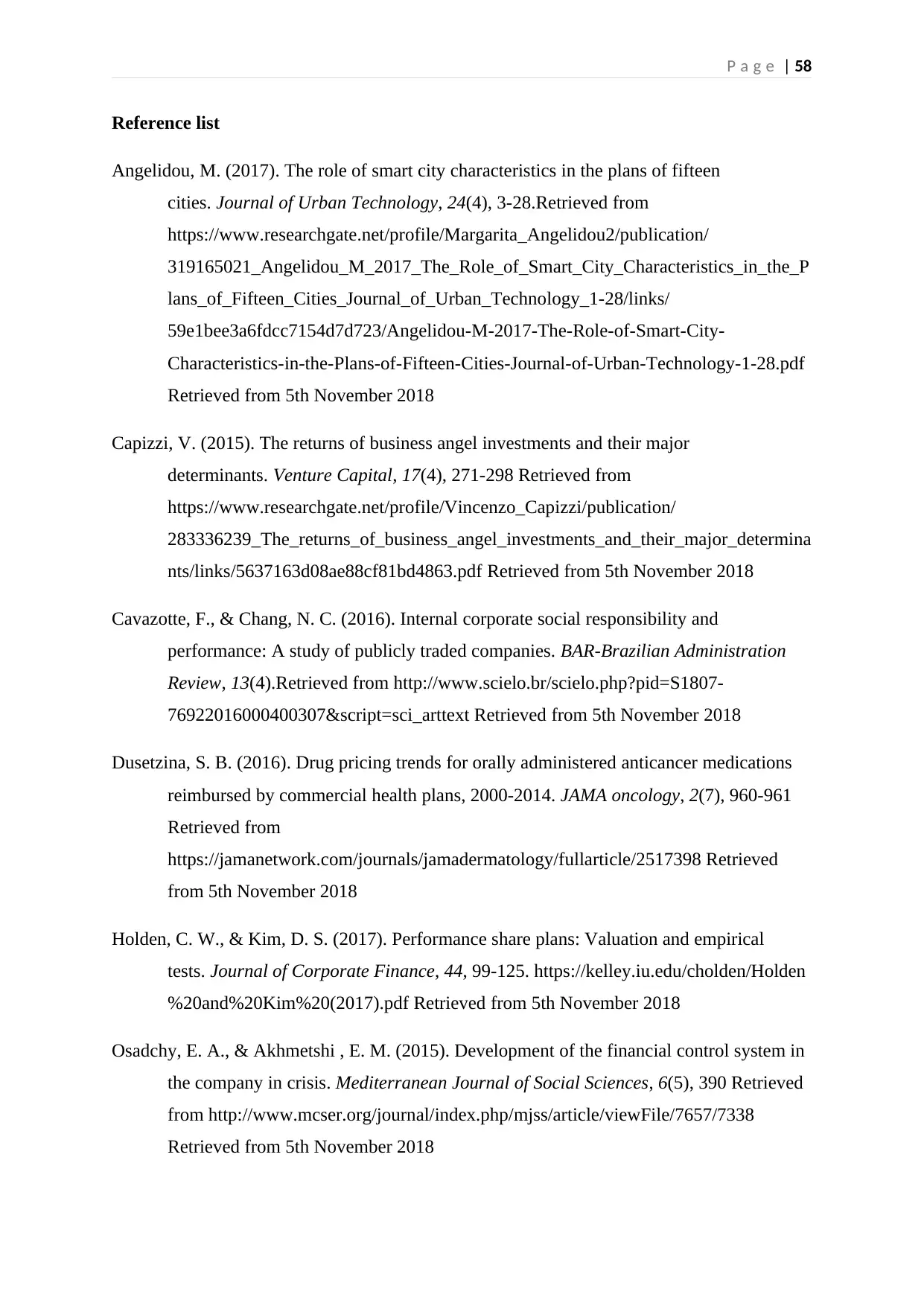
P a g e | 58
Reference list
Angelidou, M. (2017). The role of smart city characteristics in the plans of fifteen
cities. Journal of Urban Technology, 24(4), 3-28.Retrieved from
https://www.researchgate.net/profile/Margarita_Angelidou2/publication/
319165021_Angelidou_M_2017_The_Role_of_Smart_City_Characteristics_in_the_P
lans_of_Fifteen_Cities_Journal_of_Urban_Technology_1-28/links/
59e1bee3a6fdcc7154d7d723/Angelidou-M-2017-The-Role-of-Smart-City-
Characteristics-in-the-Plans-of-Fifteen-Cities-Journal-of-Urban-Technology-1-28.pdf
Retrieved from 5th November 2018
Capizzi, V. (2015). The returns of business angel investments and their major
determinants. Venture Capital, 17(4), 271-298 Retrieved from
https://www.researchgate.net/profile/Vincenzo_Capizzi/publication/
283336239_The_returns_of_business_angel_investments_and_their_major_determina
nts/links/5637163d08ae88cf81bd4863.pdf Retrieved from 5th November 2018
Cavazotte, F., & Chang, N. C. (2016). Internal corporate social responsibility and
performance: A study of publicly traded companies. BAR-Brazilian Administration
Review, 13(4).Retrieved from http://www.scielo.br/scielo.php?pid=S1807-
76922016000400307&script=sci_arttext Retrieved from 5th November 2018
Dusetzina, S. B. (2016). Drug pricing trends for orally administered anticancer medications
reimbursed by commercial health plans, 2000-2014. JAMA oncology, 2(7), 960-961
Retrieved from
https://jamanetwork.com/journals/jamadermatology/fullarticle/2517398 Retrieved
from 5th November 2018
Holden, C. W., & Kim, D. S. (2017). Performance share plans: Valuation and empirical
tests. Journal of Corporate Finance, 44, 99-125. https://kelley.iu.edu/cholden/Holden
%20and%20Kim%20(2017).pdf Retrieved from 5th November 2018
Osadchy, E. A., & Akhmetshi , E. M. (2015). Development of the financial control system in
the company in crisis. Mediterranean Journal of Social Sciences, 6(5), 390 Retrieved
from http://www.mcser.org/journal/index.php/mjss/article/viewFile/7657/7338
Retrieved from 5th November 2018
Reference list
Angelidou, M. (2017). The role of smart city characteristics in the plans of fifteen
cities. Journal of Urban Technology, 24(4), 3-28.Retrieved from
https://www.researchgate.net/profile/Margarita_Angelidou2/publication/
319165021_Angelidou_M_2017_The_Role_of_Smart_City_Characteristics_in_the_P
lans_of_Fifteen_Cities_Journal_of_Urban_Technology_1-28/links/
59e1bee3a6fdcc7154d7d723/Angelidou-M-2017-The-Role-of-Smart-City-
Characteristics-in-the-Plans-of-Fifteen-Cities-Journal-of-Urban-Technology-1-28.pdf
Retrieved from 5th November 2018
Capizzi, V. (2015). The returns of business angel investments and their major
determinants. Venture Capital, 17(4), 271-298 Retrieved from
https://www.researchgate.net/profile/Vincenzo_Capizzi/publication/
283336239_The_returns_of_business_angel_investments_and_their_major_determina
nts/links/5637163d08ae88cf81bd4863.pdf Retrieved from 5th November 2018
Cavazotte, F., & Chang, N. C. (2016). Internal corporate social responsibility and
performance: A study of publicly traded companies. BAR-Brazilian Administration
Review, 13(4).Retrieved from http://www.scielo.br/scielo.php?pid=S1807-
76922016000400307&script=sci_arttext Retrieved from 5th November 2018
Dusetzina, S. B. (2016). Drug pricing trends for orally administered anticancer medications
reimbursed by commercial health plans, 2000-2014. JAMA oncology, 2(7), 960-961
Retrieved from
https://jamanetwork.com/journals/jamadermatology/fullarticle/2517398 Retrieved
from 5th November 2018
Holden, C. W., & Kim, D. S. (2017). Performance share plans: Valuation and empirical
tests. Journal of Corporate Finance, 44, 99-125. https://kelley.iu.edu/cholden/Holden
%20and%20Kim%20(2017).pdf Retrieved from 5th November 2018
Osadchy, E. A., & Akhmetshi , E. M. (2015). Development of the financial control system in
the company in crisis. Mediterranean Journal of Social Sciences, 6(5), 390 Retrieved
from http://www.mcser.org/journal/index.php/mjss/article/viewFile/7657/7338
Retrieved from 5th November 2018
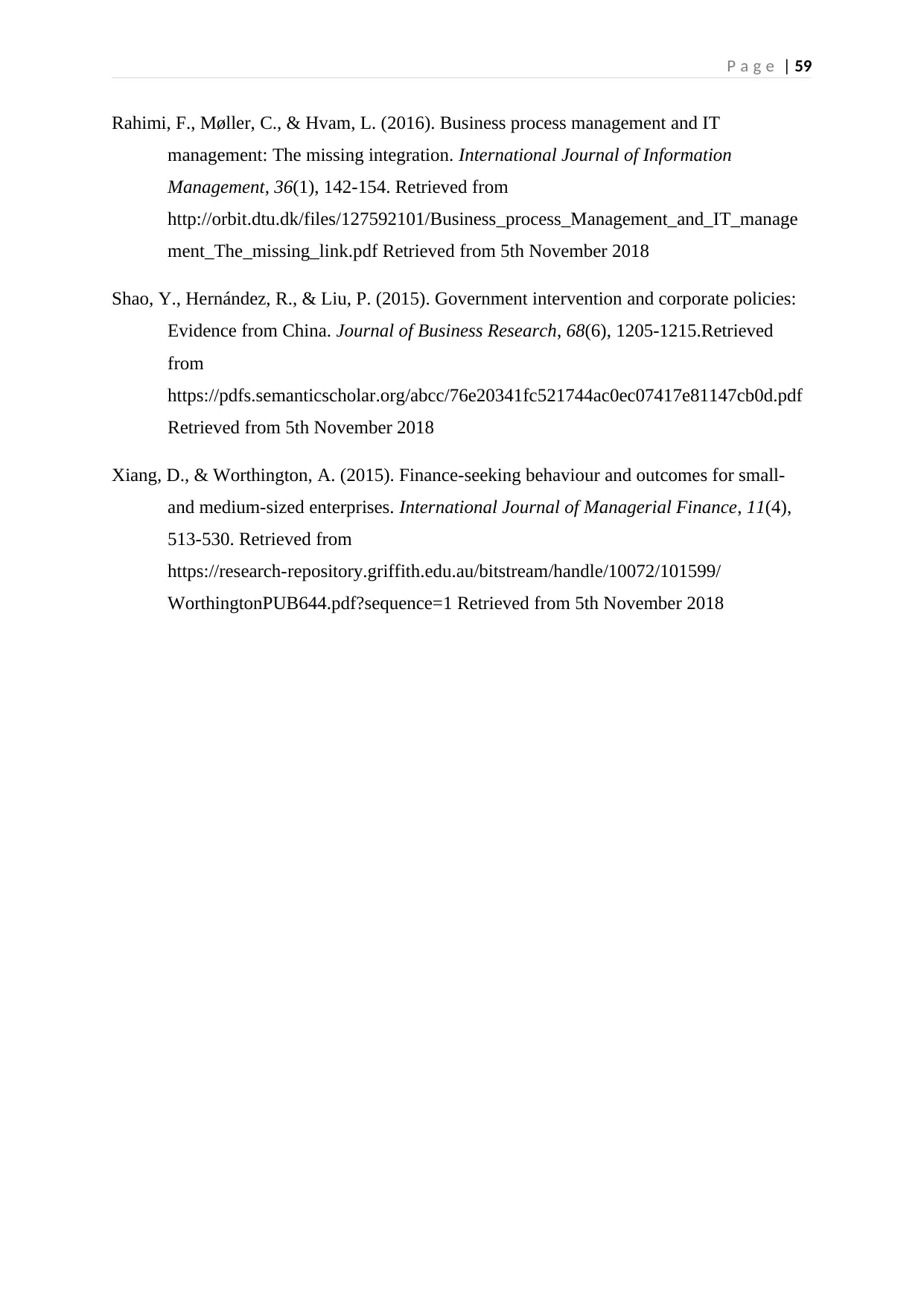
P a g e | 59
Rahimi, F., Møller, C., & Hvam, L. (2016). Business process management and IT
management: The missing integration. International Journal of Information
Management, 36(1), 142-154. Retrieved from
http://orbit.dtu.dk/files/127592101/Business_process_Management_and_IT_manage
ment_The_missing_link.pdf Retrieved from 5th November 2018
Shao, Y., Hernández, R., & Liu, P. (2015). Government intervention and corporate policies:
Evidence from China. Journal of Business Research, 68(6), 1205-1215.Retrieved
from
https://pdfs.semanticscholar.org/abcc/76e20341fc521744ac0ec07417e81147cb0d.pdf
Retrieved from 5th November 2018
Xiang, D., & Worthington, A. (2015). Finance-seeking behaviour and outcomes for small-
and medium-sized enterprises. International Journal of Managerial Finance, 11(4),
513-530. Retrieved from
https://research-repository.griffith.edu.au/bitstream/handle/10072/101599/
WorthingtonPUB644.pdf?sequence=1 Retrieved from 5th November 2018
Rahimi, F., Møller, C., & Hvam, L. (2016). Business process management and IT
management: The missing integration. International Journal of Information
Management, 36(1), 142-154. Retrieved from
http://orbit.dtu.dk/files/127592101/Business_process_Management_and_IT_manage
ment_The_missing_link.pdf Retrieved from 5th November 2018
Shao, Y., Hernández, R., & Liu, P. (2015). Government intervention and corporate policies:
Evidence from China. Journal of Business Research, 68(6), 1205-1215.Retrieved
from
https://pdfs.semanticscholar.org/abcc/76e20341fc521744ac0ec07417e81147cb0d.pdf
Retrieved from 5th November 2018
Xiang, D., & Worthington, A. (2015). Finance-seeking behaviour and outcomes for small-
and medium-sized enterprises. International Journal of Managerial Finance, 11(4),
513-530. Retrieved from
https://research-repository.griffith.edu.au/bitstream/handle/10072/101599/
WorthingtonPUB644.pdf?sequence=1 Retrieved from 5th November 2018
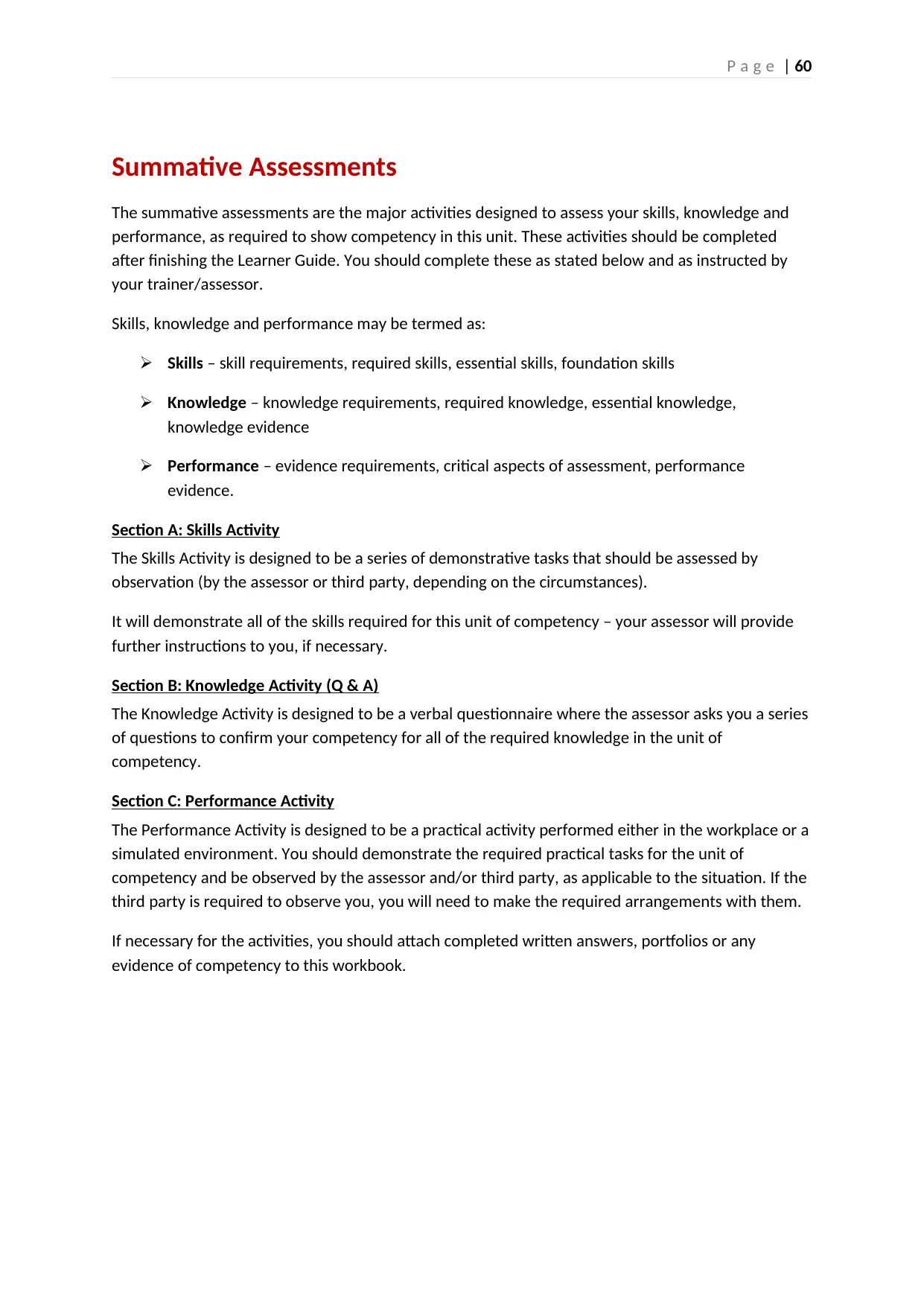
P a g e | 60
Summative Assessments
The summative assessments are the major activities designed to assess your skills, knowledge and
performance, as required to show competency in this unit. These activities should be completed
after finishing the Learner Guide. You should complete these as stated below and as instructed by
your trainer/assessor.
Skills, knowledge and performance may be termed as:
Skills – skill requirements, required skills, essential skills, foundation skills
Knowledge – knowledge requirements, required knowledge, essential knowledge,
knowledge evidence
Performance – evidence requirements, critical aspects of assessment, performance
evidence.
Section A: Skills Activity
The Skills Activity is designed to be a series of demonstrative tasks that should be assessed by
observation (by the assessor or third party, depending on the circumstances).
It will demonstrate all of the skills required for this unit of competency – your assessor will provide
further instructions to you, if necessary.
Section B: Knowledge Activity (Q & A)
The Knowledge Activity is designed to be a verbal questionnaire where the assessor asks you a series
of questions to confirm your competency for all of the required knowledge in the unit of
competency.
Section C: Performance Activity
The Performance Activity is designed to be a practical activity performed either in the workplace or a
simulated environment. You should demonstrate the required practical tasks for the unit of
competency and be observed by the assessor and/or third party, as applicable to the situation. If the
third party is required to observe you, you will need to make the required arrangements with them.
If necessary for the activities, you should attach completed written answers, portfolios or any
evidence of competency to this workbook.
Summative Assessments
The summative assessments are the major activities designed to assess your skills, knowledge and
performance, as required to show competency in this unit. These activities should be completed
after finishing the Learner Guide. You should complete these as stated below and as instructed by
your trainer/assessor.
Skills, knowledge and performance may be termed as:
Skills – skill requirements, required skills, essential skills, foundation skills
Knowledge – knowledge requirements, required knowledge, essential knowledge,
knowledge evidence
Performance – evidence requirements, critical aspects of assessment, performance
evidence.
Section A: Skills Activity
The Skills Activity is designed to be a series of demonstrative tasks that should be assessed by
observation (by the assessor or third party, depending on the circumstances).
It will demonstrate all of the skills required for this unit of competency – your assessor will provide
further instructions to you, if necessary.
Section B: Knowledge Activity (Q & A)
The Knowledge Activity is designed to be a verbal questionnaire where the assessor asks you a series
of questions to confirm your competency for all of the required knowledge in the unit of
competency.
Section C: Performance Activity
The Performance Activity is designed to be a practical activity performed either in the workplace or a
simulated environment. You should demonstrate the required practical tasks for the unit of
competency and be observed by the assessor and/or third party, as applicable to the situation. If the
third party is required to observe you, you will need to make the required arrangements with them.
If necessary for the activities, you should attach completed written answers, portfolios or any
evidence of competency to this workbook.
Paraphrase This Document
Need a fresh take? Get an instant paraphrase of this document with our AI Paraphraser

P a g e | 61
Section A: Skills Activity
Objective: To provide you with an opportunity to show you have the required skills for this unit.
A signed observation by either an approved third party or the assessor will need to be included in
this activity as proof of completion.
This activity will enable you to demonstrate the following skills:
Reading
Writing
Oral Communication
Numeracy
Navigate the world of work
Interact with others
Get the work done
Answer the activity in as much detail as possible, considering your organisational requirements.
1. Evaluate whether your organisation is adhering to legislative requirements. What proof can
you find to suggest they are or are not meeting legislative needs?
2. Create a document which provides an analysis of factual and forecasted information. Your
document should be prepared using the format, content and layout most appropriate to the
audience and purpose of the document.
3. Demonstrate your oral communication skills by explaining financial decisions and outcomes
clearly and using listening and questioning techniques to exchange information and obtain
agreement. For example, you may host a meeting, talk via a video conference or have a one-
to-one discussion with someone.
4. Describe a time when you have used your numerical skills. Provide details of the calculations,
to show how you have either:
Reviewed and analysed numerical data embedded in organisational documentation and
legislation; or
Compared and contrasted complex numerical data to analyse and evaluate financial
position and processes; or
Used appropriate formulae to analyse financial data to assess and manage risk and
identify discrepancies.
5. Outline a task you have completed (which is part of your work role) where you have
recognised, understood and adhered to legislative and organisational requirements.
6. Describe a protocol which is in place in your organisation (and you have used), to
communicate with supervisors and managers to share information or seek agreement.
7. Give a demonstration to a supervisor or assessor on how to use a range of digital technology
to access, filter, compile, integrate and logically present complex information from multiple
sources. What new digital technologies and applications are available (or soon to be available)
to manage and manipulate data?
Section A: Skills Activity
Objective: To provide you with an opportunity to show you have the required skills for this unit.
A signed observation by either an approved third party or the assessor will need to be included in
this activity as proof of completion.
This activity will enable you to demonstrate the following skills:
Reading
Writing
Oral Communication
Numeracy
Navigate the world of work
Interact with others
Get the work done
Answer the activity in as much detail as possible, considering your organisational requirements.
1. Evaluate whether your organisation is adhering to legislative requirements. What proof can
you find to suggest they are or are not meeting legislative needs?
2. Create a document which provides an analysis of factual and forecasted information. Your
document should be prepared using the format, content and layout most appropriate to the
audience and purpose of the document.
3. Demonstrate your oral communication skills by explaining financial decisions and outcomes
clearly and using listening and questioning techniques to exchange information and obtain
agreement. For example, you may host a meeting, talk via a video conference or have a one-
to-one discussion with someone.
4. Describe a time when you have used your numerical skills. Provide details of the calculations,
to show how you have either:
Reviewed and analysed numerical data embedded in organisational documentation and
legislation; or
Compared and contrasted complex numerical data to analyse and evaluate financial
position and processes; or
Used appropriate formulae to analyse financial data to assess and manage risk and
identify discrepancies.
5. Outline a task you have completed (which is part of your work role) where you have
recognised, understood and adhered to legislative and organisational requirements.
6. Describe a protocol which is in place in your organisation (and you have used), to
communicate with supervisors and managers to share information or seek agreement.
7. Give a demonstration to a supervisor or assessor on how to use a range of digital technology
to access, filter, compile, integrate and logically present complex information from multiple
sources. What new digital technologies and applications are available (or soon to be available)
to manage and manipulate data?

P a g e | 62

P a g e | 63
Summative Assessments: Section A checklist
This should be used by the trainer/assessor to document the learner’s skills, knowledge and
performance as relevant to the summative assessment. Indicate in the table below if the learner is
deemed satisfactory (S) or not satisfactory (NS) for the activity or if reassessment is required.
Learner’s name Sanjhana kc
Assessor’s name Njau Gitu
Unit of Competence
(Code and Title) BSBFIM601 Manage finances
Date(s) of assessment 6/3/2019
Has the activity been answered and performed fully, as required to assess the
competency of the learner?
Yes No
(Please circle)
Has sufficient evidence and information been provided by the learner for the
activity?
Yes No
(Please circle)
Comments
Provide your comments here:
The learner’s
performance was: Not yet satisfactory Satisfactory
If not yet satisfactory, date for reassessment:
Feedback to learner:
You have not answered the questions
Learner’s signature Sanjhana kc
Summative Assessments: Section A checklist
This should be used by the trainer/assessor to document the learner’s skills, knowledge and
performance as relevant to the summative assessment. Indicate in the table below if the learner is
deemed satisfactory (S) or not satisfactory (NS) for the activity or if reassessment is required.
Learner’s name Sanjhana kc
Assessor’s name Njau Gitu
Unit of Competence
(Code and Title) BSBFIM601 Manage finances
Date(s) of assessment 6/3/2019
Has the activity been answered and performed fully, as required to assess the
competency of the learner?
Yes No
(Please circle)
Has sufficient evidence and information been provided by the learner for the
activity?
Yes No
(Please circle)
Comments
Provide your comments here:
The learner’s
performance was: Not yet satisfactory Satisfactory
If not yet satisfactory, date for reassessment:
Feedback to learner:
You have not answered the questions
Learner’s signature Sanjhana kc
Secure Best Marks with AI Grader
Need help grading? Try our AI Grader for instant feedback on your assignments.
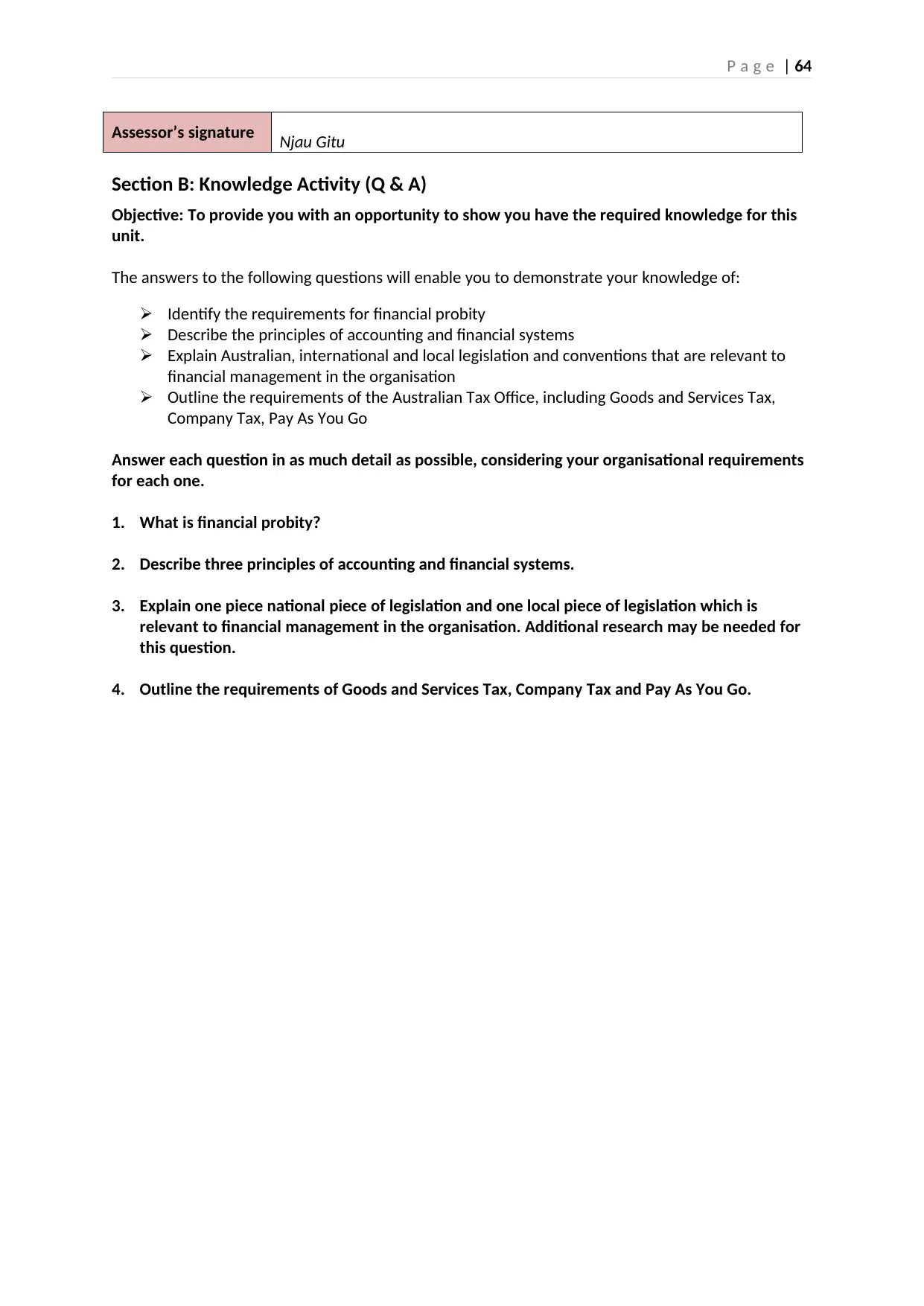
P a g e | 64
Assessor’s signature Njau Gitu
Section B: Knowledge Activity (Q & A)
Objective: To provide you with an opportunity to show you have the required knowledge for this
unit.
The answers to the following questions will enable you to demonstrate your knowledge of:
Identify the requirements for financial probity
Describe the principles of accounting and financial systems
Explain Australian, international and local legislation and conventions that are relevant to
financial management in the organisation
Outline the requirements of the Australian Tax Office, including Goods and Services Tax,
Company Tax, Pay As You Go
Answer each question in as much detail as possible, considering your organisational requirements
for each one.
1. What is financial probity?
2. Describe three principles of accounting and financial systems.
3. Explain one piece national piece of legislation and one local piece of legislation which is
relevant to financial management in the organisation. Additional research may be needed for
this question.
4. Outline the requirements of Goods and Services Tax, Company Tax and Pay As You Go.
Assessor’s signature Njau Gitu
Section B: Knowledge Activity (Q & A)
Objective: To provide you with an opportunity to show you have the required knowledge for this
unit.
The answers to the following questions will enable you to demonstrate your knowledge of:
Identify the requirements for financial probity
Describe the principles of accounting and financial systems
Explain Australian, international and local legislation and conventions that are relevant to
financial management in the organisation
Outline the requirements of the Australian Tax Office, including Goods and Services Tax,
Company Tax, Pay As You Go
Answer each question in as much detail as possible, considering your organisational requirements
for each one.
1. What is financial probity?
2. Describe three principles of accounting and financial systems.
3. Explain one piece national piece of legislation and one local piece of legislation which is
relevant to financial management in the organisation. Additional research may be needed for
this question.
4. Outline the requirements of Goods and Services Tax, Company Tax and Pay As You Go.

P a g e | 65
Summative Assessments: Section B checklist
This should be used by the trainer/assessor to document the learner’s skills, knowledge and
performance as relevant to the summative assessment. Indicate in the table below if the learner is
deemed satisfactory (S) or not satisfactory (NS) for the activity or if reassessment is required.
Learner’s name
Assessor’s name
Unit of Competence
(Code and Title)
Date(s) of assessment
Has the activity been answered and performed fully, as required to assess the
competency of the learner?
Yes No
(Please circle)
Has sufficient evidence and information been provided by the learner for the
activity?
Yes No
(Please circle)
Comments
Provide your comments here:
The learner’s
performance was: Not yet satisfactory Satisfactory
If not yet satisfactory, date for reassessment:
Feedback to learner:
Learner’s signature
Summative Assessments: Section B checklist
This should be used by the trainer/assessor to document the learner’s skills, knowledge and
performance as relevant to the summative assessment. Indicate in the table below if the learner is
deemed satisfactory (S) or not satisfactory (NS) for the activity or if reassessment is required.
Learner’s name
Assessor’s name
Unit of Competence
(Code and Title)
Date(s) of assessment
Has the activity been answered and performed fully, as required to assess the
competency of the learner?
Yes No
(Please circle)
Has sufficient evidence and information been provided by the learner for the
activity?
Yes No
(Please circle)
Comments
Provide your comments here:
The learner’s
performance was: Not yet satisfactory Satisfactory
If not yet satisfactory, date for reassessment:
Feedback to learner:
Learner’s signature
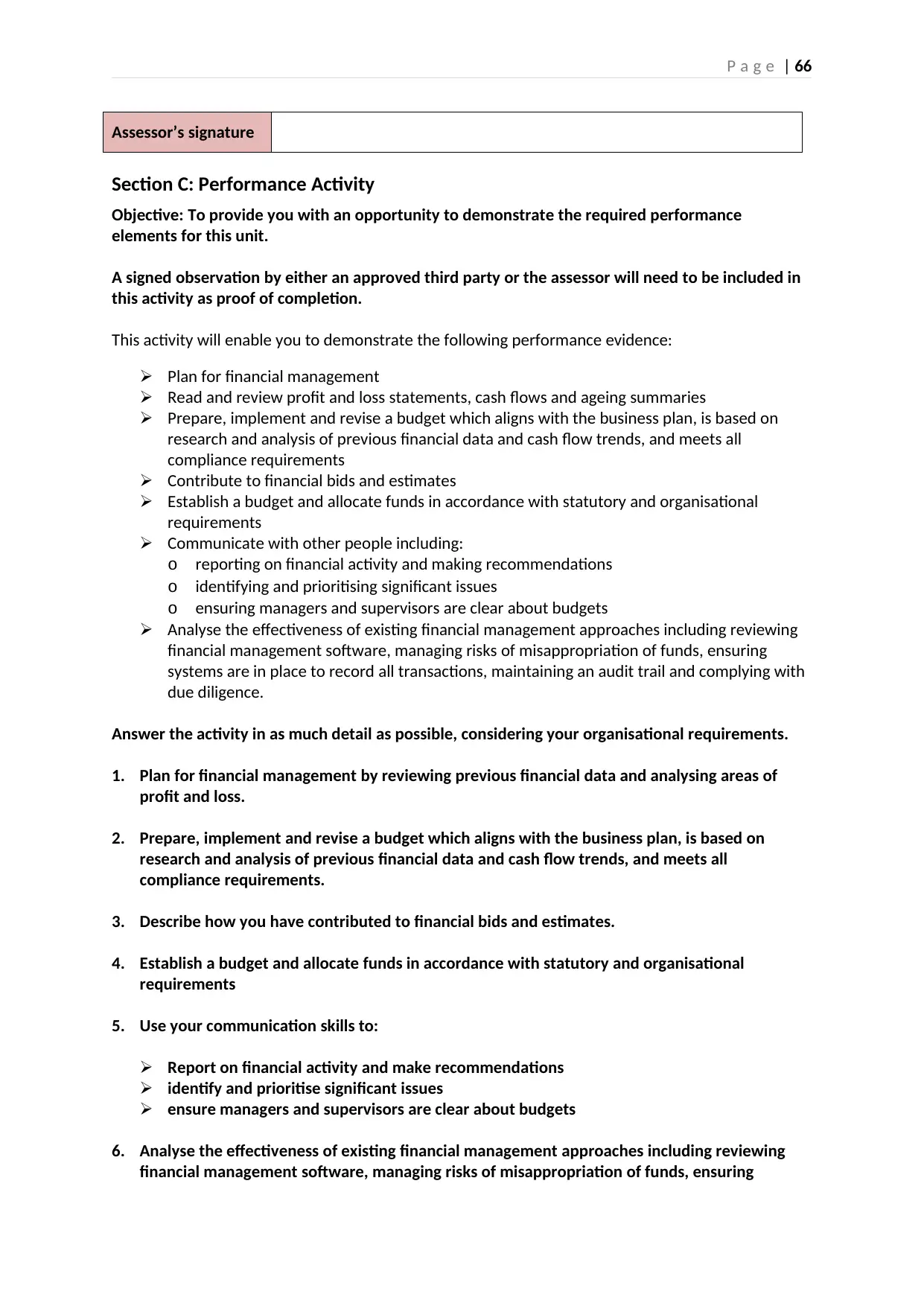
P a g e | 66
Assessor’s signature
Section C: Performance Activity
Objective: To provide you with an opportunity to demonstrate the required performance
elements for this unit.
A signed observation by either an approved third party or the assessor will need to be included in
this activity as proof of completion.
This activity will enable you to demonstrate the following performance evidence:
Plan for financial management
Read and review profit and loss statements, cash flows and ageing summaries
Prepare, implement and revise a budget which aligns with the business plan, is based on
research and analysis of previous financial data and cash flow trends, and meets all
compliance requirements
Contribute to financial bids and estimates
Establish a budget and allocate funds in accordance with statutory and organisational
requirements
Communicate with other people including:
o reporting on financial activity and making recommendations
o identifying and prioritising significant issues
o ensuring managers and supervisors are clear about budgets
Analyse the effectiveness of existing financial management approaches including reviewing
financial management software, managing risks of misappropriation of funds, ensuring
systems are in place to record all transactions, maintaining an audit trail and complying with
due diligence.
Answer the activity in as much detail as possible, considering your organisational requirements.
1. Plan for financial management by reviewing previous financial data and analysing areas of
profit and loss.
2. Prepare, implement and revise a budget which aligns with the business plan, is based on
research and analysis of previous financial data and cash flow trends, and meets all
compliance requirements.
3. Describe how you have contributed to financial bids and estimates.
4. Establish a budget and allocate funds in accordance with statutory and organisational
requirements
5. Use your communication skills to:
Report on financial activity and make recommendations
identify and prioritise significant issues
ensure managers and supervisors are clear about budgets
6. Analyse the effectiveness of existing financial management approaches including reviewing
financial management software, managing risks of misappropriation of funds, ensuring
Assessor’s signature
Section C: Performance Activity
Objective: To provide you with an opportunity to demonstrate the required performance
elements for this unit.
A signed observation by either an approved third party or the assessor will need to be included in
this activity as proof of completion.
This activity will enable you to demonstrate the following performance evidence:
Plan for financial management
Read and review profit and loss statements, cash flows and ageing summaries
Prepare, implement and revise a budget which aligns with the business plan, is based on
research and analysis of previous financial data and cash flow trends, and meets all
compliance requirements
Contribute to financial bids and estimates
Establish a budget and allocate funds in accordance with statutory and organisational
requirements
Communicate with other people including:
o reporting on financial activity and making recommendations
o identifying and prioritising significant issues
o ensuring managers and supervisors are clear about budgets
Analyse the effectiveness of existing financial management approaches including reviewing
financial management software, managing risks of misappropriation of funds, ensuring
systems are in place to record all transactions, maintaining an audit trail and complying with
due diligence.
Answer the activity in as much detail as possible, considering your organisational requirements.
1. Plan for financial management by reviewing previous financial data and analysing areas of
profit and loss.
2. Prepare, implement and revise a budget which aligns with the business plan, is based on
research and analysis of previous financial data and cash flow trends, and meets all
compliance requirements.
3. Describe how you have contributed to financial bids and estimates.
4. Establish a budget and allocate funds in accordance with statutory and organisational
requirements
5. Use your communication skills to:
Report on financial activity and make recommendations
identify and prioritise significant issues
ensure managers and supervisors are clear about budgets
6. Analyse the effectiveness of existing financial management approaches including reviewing
financial management software, managing risks of misappropriation of funds, ensuring
Paraphrase This Document
Need a fresh take? Get an instant paraphrase of this document with our AI Paraphraser

P a g e | 67
systems are in place to record all transactions, maintaining an audit trail and complying with
due diligence.
systems are in place to record all transactions, maintaining an audit trail and complying with
due diligence.

P a g e | 68
Summative Assessments: Section C checklist
This should be used by the trainer/assessor to document the learner’s skills, knowledge and
performance as relevant to the summative assessment. Indicate in the table below if the learner is
deemed satisfactory (S) or not satisfactory (NS) for the activity or if reassessment is required.
Learner’s name
Assessor’s name
Unit of Competence
(Code and Title)
Date(s) of assessment
Has the activity been answered and performed fully, as required to assess the
competency of the learner?
Yes No
(Please circle)
Has sufficient evidence and information been provided by the learner for the
activity?
Yes No
(Please circle)
Comments
Provide your comments here:
The learner’s
performance was: Not yet satisfactory Satisfactory
If not yet satisfactory, date for reassessment:
Feedback to learner:
Learner’s signature
Summative Assessments: Section C checklist
This should be used by the trainer/assessor to document the learner’s skills, knowledge and
performance as relevant to the summative assessment. Indicate in the table below if the learner is
deemed satisfactory (S) or not satisfactory (NS) for the activity or if reassessment is required.
Learner’s name
Assessor’s name
Unit of Competence
(Code and Title)
Date(s) of assessment
Has the activity been answered and performed fully, as required to assess the
competency of the learner?
Yes No
(Please circle)
Has sufficient evidence and information been provided by the learner for the
activity?
Yes No
(Please circle)
Comments
Provide your comments here:
The learner’s
performance was: Not yet satisfactory Satisfactory
If not yet satisfactory, date for reassessment:
Feedback to learner:
Learner’s signature
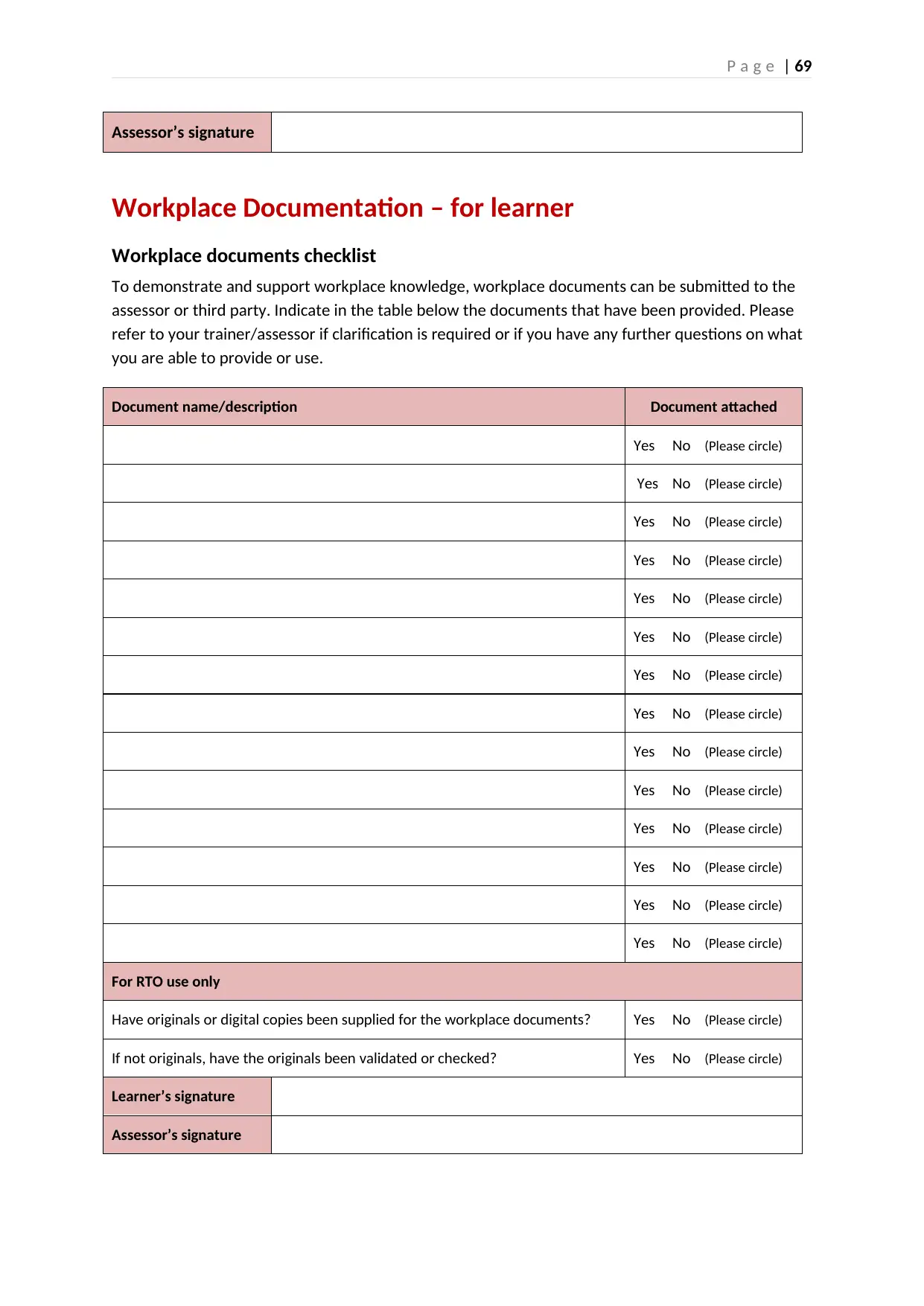
P a g e | 69
Assessor’s signature
Workplace Documentation – for learner
Workplace documents checklist
To demonstrate and support workplace knowledge, workplace documents can be submitted to the
assessor or third party. Indicate in the table below the documents that have been provided. Please
refer to your trainer/assessor if clarification is required or if you have any further questions on what
you are able to provide or use.
Document name/description Document attached
Yes No (Please circle)
Yes No (Please circle)
Yes No (Please circle)
Yes No (Please circle)
Yes No (Please circle)
Yes No (Please circle)
Yes No (Please circle)
Yes No (Please circle)
Yes No (Please circle)
Yes No (Please circle)
Yes No (Please circle)
Yes No (Please circle)
Yes No (Please circle)
Yes No (Please circle)
For RTO use only
Have originals or digital copies been supplied for the workplace documents? Yes No (Please circle)
If not originals, have the originals been validated or checked? Yes No (Please circle)
Learner’s signature
Assessor’s signature
Assessor’s signature
Workplace Documentation – for learner
Workplace documents checklist
To demonstrate and support workplace knowledge, workplace documents can be submitted to the
assessor or third party. Indicate in the table below the documents that have been provided. Please
refer to your trainer/assessor if clarification is required or if you have any further questions on what
you are able to provide or use.
Document name/description Document attached
Yes No (Please circle)
Yes No (Please circle)
Yes No (Please circle)
Yes No (Please circle)
Yes No (Please circle)
Yes No (Please circle)
Yes No (Please circle)
Yes No (Please circle)
Yes No (Please circle)
Yes No (Please circle)
Yes No (Please circle)
Yes No (Please circle)
Yes No (Please circle)
Yes No (Please circle)
For RTO use only
Have originals or digital copies been supplied for the workplace documents? Yes No (Please circle)
If not originals, have the originals been validated or checked? Yes No (Please circle)
Learner’s signature
Assessor’s signature
Secure Best Marks with AI Grader
Need help grading? Try our AI Grader for instant feedback on your assignments.
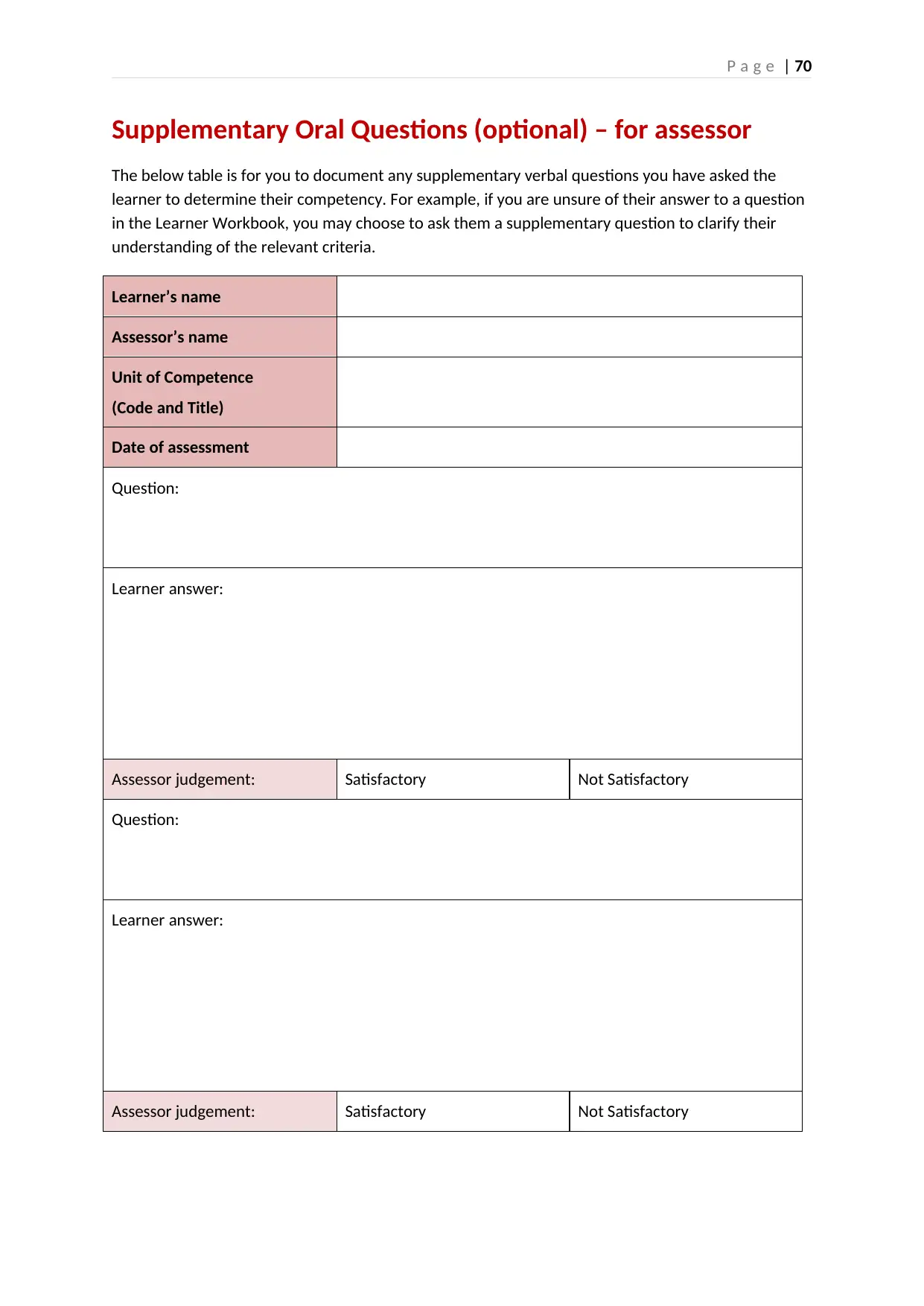
P a g e | 70
Supplementary Oral Questions (optional) – for assessor
The below table is for you to document any supplementary verbal questions you have asked the
learner to determine their competency. For example, if you are unsure of their answer to a question
in the Learner Workbook, you may choose to ask them a supplementary question to clarify their
understanding of the relevant criteria.
Learner’s name
Assessor’s name
Unit of Competence
(Code and Title)
Date of assessment
Question:
Learner answer:
Assessor judgement: Satisfactory Not Satisfactory
Question:
Learner answer:
Assessor judgement: Satisfactory Not Satisfactory
Supplementary Oral Questions (optional) – for assessor
The below table is for you to document any supplementary verbal questions you have asked the
learner to determine their competency. For example, if you are unsure of their answer to a question
in the Learner Workbook, you may choose to ask them a supplementary question to clarify their
understanding of the relevant criteria.
Learner’s name
Assessor’s name
Unit of Competence
(Code and Title)
Date of assessment
Question:
Learner answer:
Assessor judgement: Satisfactory Not Satisfactory
Question:
Learner answer:
Assessor judgement: Satisfactory Not Satisfactory
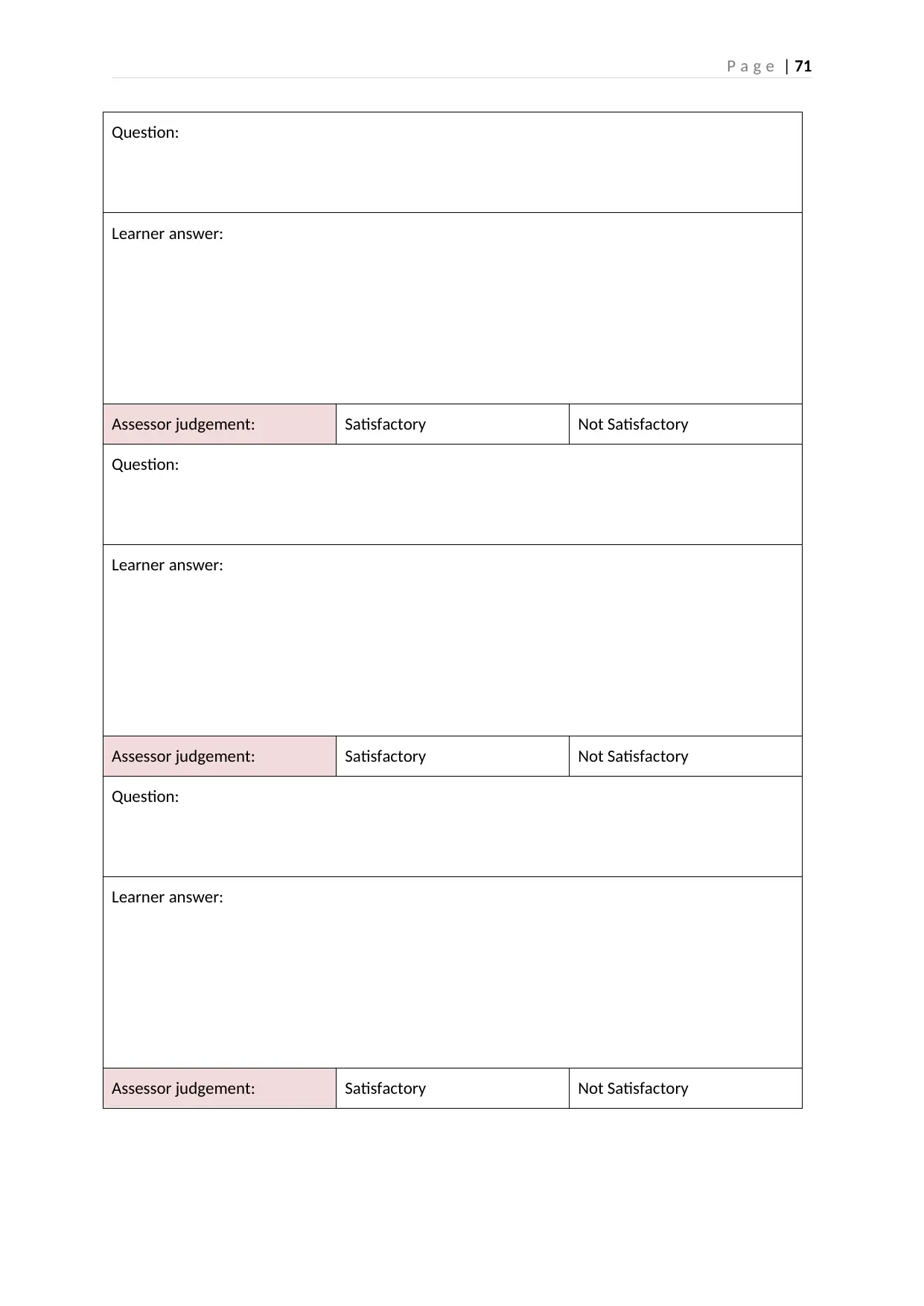
P a g e | 71
Question:
Learner answer:
Assessor judgement: Satisfactory Not Satisfactory
Question:
Learner answer:
Assessor judgement: Satisfactory Not Satisfactory
Question:
Learner answer:
Assessor judgement: Satisfactory Not Satisfactory
Question:
Learner answer:
Assessor judgement: Satisfactory Not Satisfactory
Question:
Learner answer:
Assessor judgement: Satisfactory Not Satisfactory
Question:
Learner answer:
Assessor judgement: Satisfactory Not Satisfactory
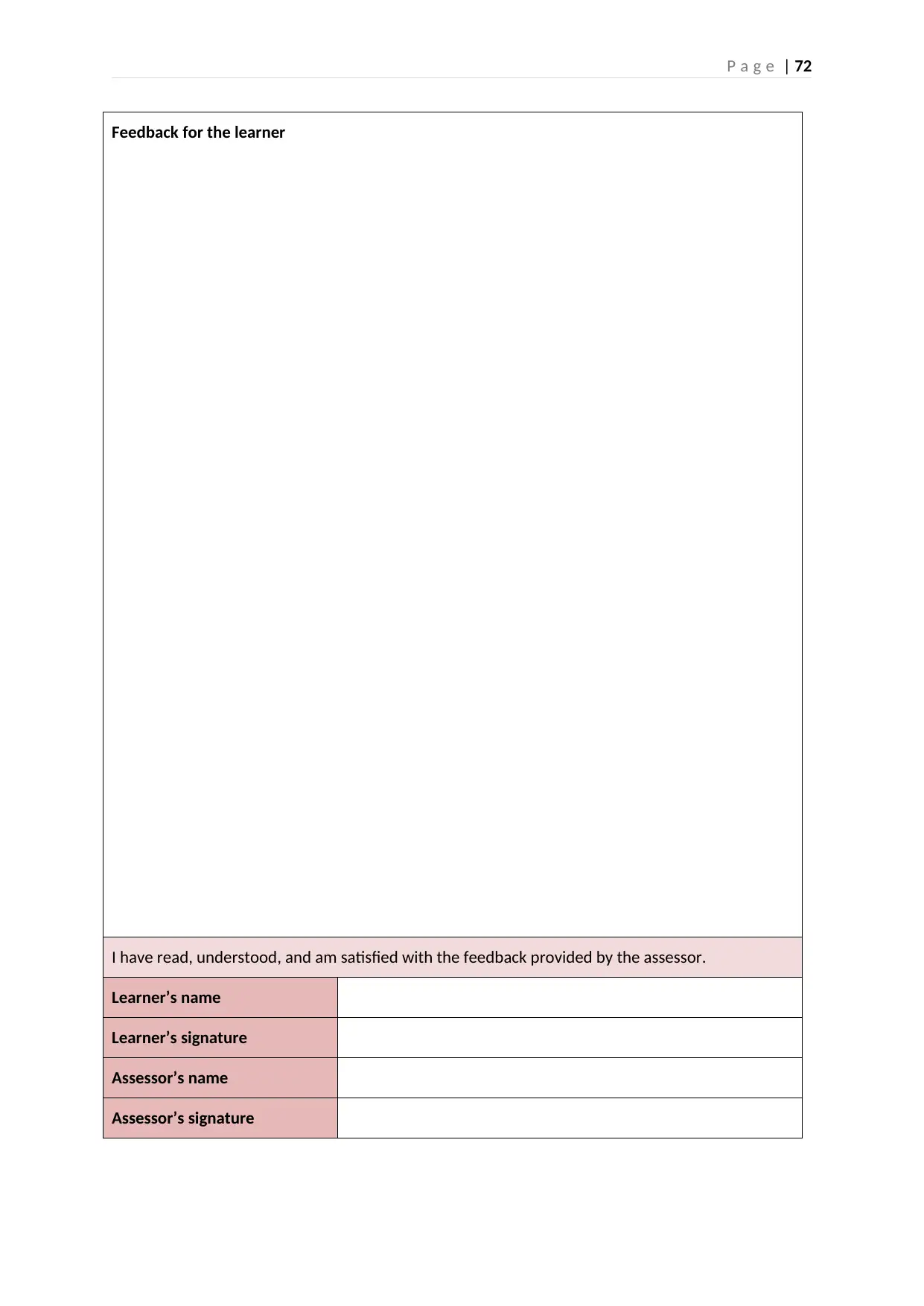
P a g e | 72
Feedback for the learner
I have read, understood, and am satisfied with the feedback provided by the assessor.
Learner’s name
Learner’s signature
Assessor’s name
Assessor’s signature
Feedback for the learner
I have read, understood, and am satisfied with the feedback provided by the assessor.
Learner’s name
Learner’s signature
Assessor’s name
Assessor’s signature
Paraphrase This Document
Need a fresh take? Get an instant paraphrase of this document with our AI Paraphraser

P a g e | 73
Competency record to be completed by assessor
This should be used by the trainer/assessor to document the learner’s skills, knowledge and
performance as relevant to the overall unit. Indicate in the table below if the learner is deemed
competent or not yet competent for the unit or if reassessment is required.
Learner’s name Sanjhana kc
Assessor’s name Njau Gitu
Unit of Competence
(Code and Title)
BSBFIM601 Manage finanaces
Date(s) of assessment
Has the learner completed all required assessments to a satisfactory standard? Yes No
(Please circle)
Has sufficient evidence and information been provided by the learner to prove
their competency across the entire unit?
Yes No
(Please circle)
The learner has been assessed as competent in the elements and performance criteria and the
evidence has been presented as:
Authentic Yes No
(Please circle)
Valid Yes No
(Please circle)
Reliable Yes No
(Please circle)
Current Yes No
(Please circle)
Sufficient Yes No
(Please circle)
Competency record to be completed by assessor
This should be used by the trainer/assessor to document the learner’s skills, knowledge and
performance as relevant to the overall unit. Indicate in the table below if the learner is deemed
competent or not yet competent for the unit or if reassessment is required.
Learner’s name Sanjhana kc
Assessor’s name Njau Gitu
Unit of Competence
(Code and Title)
BSBFIM601 Manage finanaces
Date(s) of assessment
Has the learner completed all required assessments to a satisfactory standard? Yes No
(Please circle)
Has sufficient evidence and information been provided by the learner to prove
their competency across the entire unit?
Yes No
(Please circle)
The learner has been assessed as competent in the elements and performance criteria and the
evidence has been presented as:
Authentic Yes No
(Please circle)
Valid Yes No
(Please circle)
Reliable Yes No
(Please circle)
Current Yes No
(Please circle)
Sufficient Yes No
(Please circle)
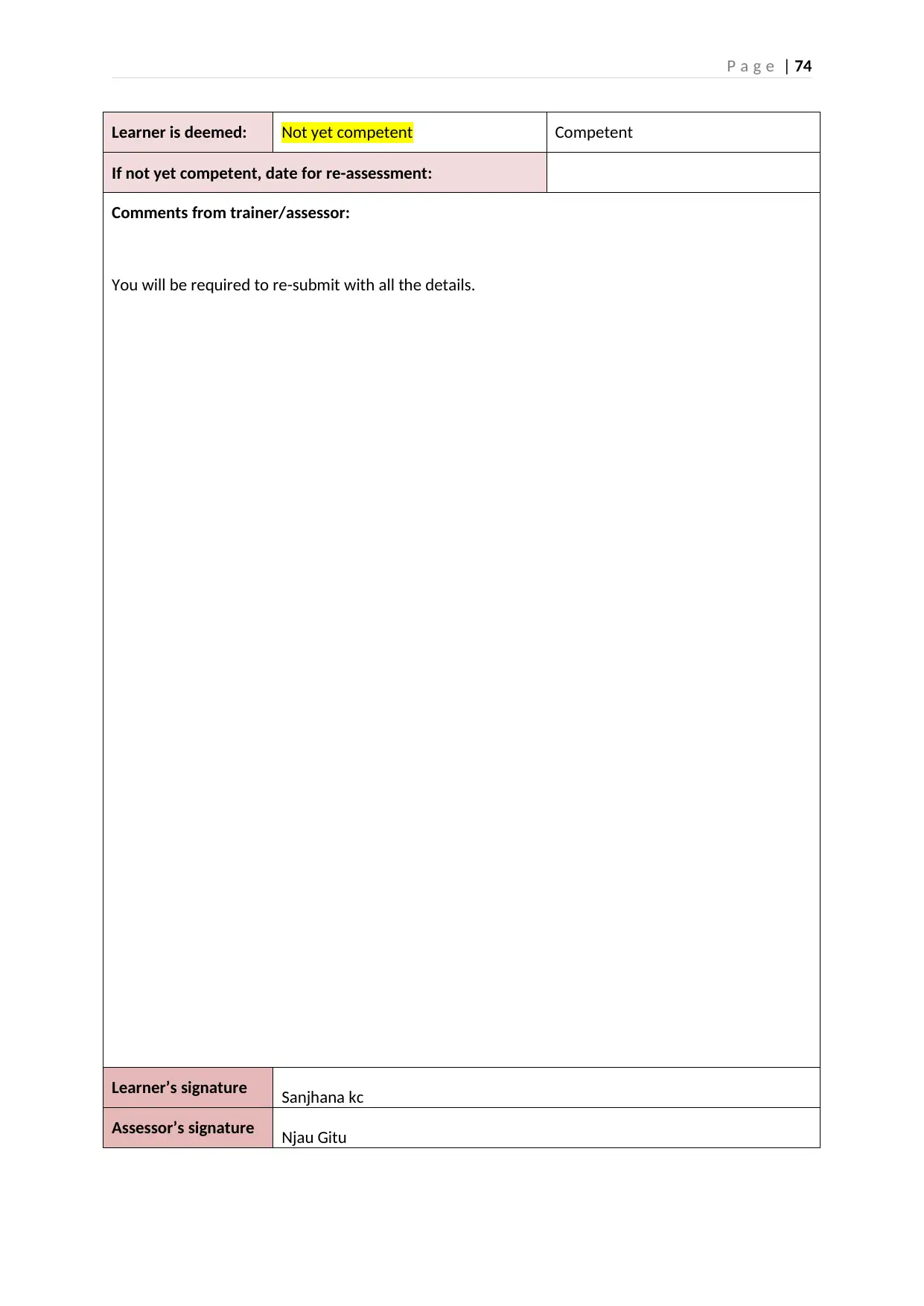
P a g e | 74
Learner is deemed: Not yet competent Competent
If not yet competent, date for re-assessment:
Comments from trainer/assessor:
You will be required to re-submit with all the details.
Learner’s signature Sanjhana kc
Assessor’s signature Njau Gitu
Learner is deemed: Not yet competent Competent
If not yet competent, date for re-assessment:
Comments from trainer/assessor:
You will be required to re-submit with all the details.
Learner’s signature Sanjhana kc
Assessor’s signature Njau Gitu
1 out of 75
Related Documents
Your All-in-One AI-Powered Toolkit for Academic Success.
+13062052269
info@desklib.com
Available 24*7 on WhatsApp / Email
![[object Object]](/_next/static/media/star-bottom.7253800d.svg)
Unlock your academic potential
© 2024 | Zucol Services PVT LTD | All rights reserved.





